
CRO Audit Guide
The purpose of a CRO audit is to highlight user behavior patterns and then make suggestions for improving visitors’ experiences and conversion rates based on the data. Depending on the type of audit being completed heatmaps, user recordings, user polls/surveys, and engagement data from Google Analytics are utilized. There are two types of audits, with slight differences between them:
- Pinpoint: Includes five key findings with supporting evidence and recommendations for each. Heatmaps, user recordings, and form analytics are incorporated to substantiate conclusions.
- U/X Diagnostic: Limited to three specific pages on the website which the client usually chooses. Includes one heatmap for each page, five user recordings total, and a two question user poll. Also includes a review of existing Google Analytics configuration and engagement data for each of the three pages. An example report is accessible here.
- Configure Hotjar and gain access to Google Analytics
- Make sure client site has been added
- Check that tracking has been installed
- Ensure heatmaps have been set up
- Check that user recordings are enabled
- Filter out internal IP addresses
- Determine if the user poll has been created
- Request Google Analytics access
- How to analyze user movements
- Evaluate distribution of clicks, mouse movement and scroll depth on heatmaps
- Review user recordings to identify behavior patterns
- How to analyze user feedback
- Identify trends in user responses
- How to analyze user interactions
- Interpreting user engagement metrics in Google Analytics
- Evaluating events in Google Analytics
- Assessing goals in Google Analytics
Guide to Configure Hotjar and Gain Access to Google Analytics
The Big Idea Behind Configuring Hotjar
Configuring Hotjar correctly is essential as it collects the data you’ll use to draw conclusions and interpret user behavior. While setup is generally simple, there are a few issues that can arise to complicate the process. Configuring Hotjar includes the following:
- Creating the client account
- Creating heatmaps
- Turning on user recordings
- Filtering out internal IP addresses
- Developing a user poll/survey
Gaining access to Google Analytics is simple and included in this guide only as a reminder.
Common Problems When Configuring Hotjar
The following problems tend to occur:
- Parallax scrolling: This is an effect where the background of a webpage moves at a different rate than the foreground. (Look at Wells.edu for an example) Hotjar cannot accurately display this type of page and so elements are often out of place or do not appear at all.Looking at the site’s styling should tell you if parallax scrolling will be an issue. You can also check the page source for “overflow” within the CSS, which can indicate that this is in place. However, the best way to know is to simply make the heatmap and check it after a few pageviews.
- Heatmaps not rendering correctly: Can be related to parallax scrolling (mentioned above), how the page displays on other browsers (Hotjar uses Firefox for snapshots), other CSS issues, etc.
- User recordings not showing the entire page: Often the result of infinite scrolling, but again, the only way to know if recordings will work on the site is to set them up and comb through to make sure you can see the page footer in multiple recordings.
Examples of Correct & Incorrect Hotjar Configurations
Correct
Code installed properly

IP addresses filtered

Poll/survey created and collecting data

Heatmaps created

User recording turned on

Incorrect
Tracking inactive/not installed
![]()
IP addresses not filtered

Heatmaps not created

User recordings not turned on

Poll/survey not created or launched


Suggested Tools for Configuring Hotjar
Step-by-Step Instructions for Configuring Hotjar and Requesting Google Analytics Access
- Make sure client site has been added
Log in to Hotjar, then navigate to the Site and Organizations menu in the upper left corner.


- Check that tracking has been installed
Once you’re in the client’s Hotjar account, look in the upper right corner, just below the Help menu. It will either say “Tracking Inactive” or “Tracking Active.” If it is inactive, the code has not been installed and data will not be collected.

- Ensure heatmaps have been set up
On the left sidebar, click “Heatmaps” which has a flame icon next to it.

On the Heatmap page, it will list heatmaps that have been created and if they are recording (see the “Correct” heatmap image above) or it will contain the introductory video if no heatmaps have been configured (see the “Incorrect” heatmap image above).If heatmaps have not been set up, click the green +New Heatmap button toward the top of the page.
Then choose how many pageviews you’d like the snapshot to contain, name the heatmap and add the URL you’d like to track. It’s best to navigate to the page in your browser, copy the URL from the address bar, and then paste it into the field. This ensures that the correct page will be tracked. *Note that Hotjar considers pages with a trailing slash as separate, e.g. /example is not the same as /example/
The “Simple match” type should work for most pages. However, check the other URL match types to be sure that you select the best option for your needs.The “Advanced Options” section can be ignored unless you have a specific screenshot you’d like to use for your heatmap or there are elements you’d like to exclude.
Note: It is important to check that heatmaps have been generated correctly and are gathering data soon after they have been created to avoid any errors. - Check that user recordings are enabled
To ensure that recordings are enabled, click “Recordings” in the left sidebar, next to the video camera icon.

If recordings have been enabled and are being collected, there should be rows of recordings on the page and the heading should have an open green circle next to it with a button saying “Stop Recording” (as in the “Correct” image for recordings above). If recordings are not being collected, there will be a green button near the heading saying “Record Visitors” (as in the “Incorrect” image for recordings above). Click it to start capturing videos of user movement.Note: It is important to check that recordings allow you to see user activity all the way to the bottom of the page. Check several videos to be sure that you will have all of the data you need. - Filter out internal IP addresses
In the upper right corner, under the Help menu, click the gear icon. Then click “IP Blocking” under the “Account” section.

Select the organization under which the site is housed. Name the IP addresses that will be filtered out, e.g. “Client – Internal Traffic.” If there are multiple IPs or a range, use a Regular Expression rather than adding them individually.

To set up the Regular Expression for IP blocking, it’s important to note that each set of numbers separated by a period is in a range from 0 to 255. For example, you may be given a range that looks like this: 199.8.16.x – 199.8.27.x. This would translate to the following: 199.8.16.1 – 199.8.27.255. You can then enter that range into this tool, which will populate the Regex for you. In our example, the Regex would appear as follows:
^199\.8\.(1[6-9]|2[0-7])\.([0-9]|[1-9][0-9]|1([0-9][0-9])|2([0-4][0-9]|5[0-5]))$Private IP addresses do not need to be filtered. If you are given a subnet, the process is slightly different. You will need to enter the subnet into this tool to convert it to a range. You can then use the tool mentioned in the previous paragraph to get the final Regex. If you have questions, as the development team for assistance. It’s very important to be sure you are filtering out internal traffic. - Determine if the user poll/survey has been created
In the left sidebar, click “Polls.”

If a poll has been created it will be listed on the page (see the “Correct” image for user polls above). To determine if the poll is active, look at the toggle on the left side of the screen. If it is green, the poll is active, but if it is gray the poll has been turned off.

Check the number of responses to be sure that data is coming through correctly.
If no polls have been created, click the green “+New Poll” button toward the top of the page.

- Add the questions you’d like to include and type of answer that may be provided (free form text, radio button, etc)
- Give the poll an internal name so you know its purpose
- Click to remove Hotjar branding
- Ensure that the poll appears on the proper devices and pages (typically desktops, and for U/X diagnostics, only on the three pages included)
- Choose what triggers the poll to appear (e.g. exit intent, time delay, etc)
- Select how often someone should see it
When complete, save the poll and make it active. It’s generally a good idea to complete a test submission as well.
Note that the same steps apply for surveys. To access surveys, click the “Surveys” button in the left sidebar.

With surveys, you also have the option to invite users to complete the survey through a popup. Surveys tend to be more detailed and require more time to complete, so be sure to consider whether a survey or poll is best for your target audience. - Request Google Analytics access
To complete the Google Analytics review, you will need to request that the client provide full Google Analytics access to the house account: [email protected] It’s best to gain access as soon as possible so you can start working on that portion of the project while data is collecting in Hotjar.
Outcome after Configuring Hotjar
Asana
Make a task to check in on data collection to ensure everything is functioning correctly.
Documents
No documents result from this task.
How to Analyze User Movements
The Big Idea Behind Analyzing User Movements
Heatmaps and recording data provide key insights into user behavior. By looking at visitors’ movements, you will be able to identify patterns that can influence your recommendations for improving their experiences. It is crucial to focus on suggestions that could have a significant impact, rather than smaller or aesthetic changes.
Common Problems When Analyzing User Movements
The following problems tend to occur:
- Making suggestions based on personal preferences rather than data
- Gaining a true understanding of the reasons behind users’ movements
Step-by-Step Instructions for Analyzing User Movements
- Evaluate distribution of clicks, mouse movement, and scroll depth on heatmaps
First, select the heatmap that you would like to analyze. It’s best to start your analysis when the heatmap has a significant number of pageviews (200+ is typically the bare minimum). How quickly data accumulates depends on traffic levels to the site. When the heatmap appears, notice at the top you can select desktop, mobile, or tablet devices and you can toggle click data, mouse movements, and scroll depth.




- Review user recordings to identify behavior patterns
Similar to the heatmap data, it is important to identify potential usability issues and behavior patterns that highlight areas for improvement. Pay special attention to where users move their mice, sequences they tend to follow (e.g. Homepage, to Academics page, to Majors and Minors page), elements they try to click but can’t, etc.As you view user recordings, star, tag and take notes on videos that reveal key usability issues. Once you have tagged and/or starred many recordings, you can then filter all of the recordings by specific tags or by starred videos, making it easy to find and re-watch them later. Remember that only 5 are to be included in the report.




 Note: You should make notes on your ideas and findings as you look through the heatmaps and recordings. This makes it easier to assemble the report and remember the reasoning behind your recommendations.IMPORTANT: Don’t forget to share the heatmaps and videos so the client can access them. Be sure to use these links in your report.
Note: You should make notes on your ideas and findings as you look through the heatmaps and recordings. This makes it easier to assemble the report and remember the reasoning behind your recommendations.IMPORTANT: Don’t forget to share the heatmaps and videos so the client can access them. Be sure to use these links in your report.To share a heatmap, navigate to the heatmaps tab. Then, to the right of the down arrow next to View Heatmap, select “Share.”




Outcome after Analyzing User Movements
Asana
Keep tasks to check in on new heatmapping data and user recordings every couple of days, depending on how much traffic the site gets.
Documents
- Use a templated doc to make notes. This will likely be provided by client, but you can use the outline presented in this doc.
- For Ruffalo Noel Levitz, make a copy of this document and use it for your notes and final report.
How to Analyze User Feedback
The Big Idea Behind Analyzing User Feedback
Running user polls allows you to get information about pain points directly from site visitors. They can highlight specific issues among different user groups (e.g. potential students versus current students), as well as technical glitches and other usability problems. Polls are also helpful for making and supporting recommendations.
Common Problems When Analyzing User Feedback
The following problems tend to occur:
- Expletives in the poll responses (yes, seriously)
- Getting very granular answers rather than those that point to high level issues
- Getting generic, vague, or generally unhelpful answers
Step-by-Step Instructions for Analyzing User Feedback
- Identify trends in user responses
This process really only has one step. Navigate to Polls in the left sidebar in Hotjar, and then click View Responses for the poll you are running.

A word cloud can be helpful for determining which terms were commonly used in responses, but it is much less valuable than actually reviewing the responses. If a multiple choice question was asked, Hotjar represents the answers in a graphical format as well.


Many users will try to interact with the poll as if it were live chat. Therefore, a recommendation to deploy live chat is often included in this section.
Outcome after Analyzing User Feedback
Asana
- N/A
Documents
- Add a summary of trends in user feedback and a few supporting examples to the diagnostic.
- Include a formatted export of all poll responses when sending the project to the client. To export the responses, navigate to the poll section. Then click on the down arrow next to “View Responses” and select “Download responses as XLSX.” Remove the following columns: Number, User, Device, Browser, OS. Format the column headings so they are easier to read and the responses are client-facing.
 Note that you should use stars (**) to remove expletives.
Note that you should use stars (**) to remove expletives.
How to Analyze User Interactions
The Big Idea Behind Analyzing User Interactions
How users interact with a site provides insight into the features and information they like, and those they don’t, as well as the purpose of their visits. Once you have this data, you can leverage it to create a site that meets their needs. This, in turn, can boost conversions.
Common Problems When Analyzing User Interactions
The following problems tend to occur:
- We only see the numbers in Google Analytics and while we can infer what they mean, we can’t be 100% positive. Therefore, providing fully plausible explanations can be difficult.
- Bot traffic or inaccurate tracking can skew data.
Step-by-Step Instructions for Analyzing User Interactions
-
- Interpreting user engagement metrics in Google Analytics
The UX Diagnostic typically includes a review of the following for each of the pages in the report:- Sessions
- Average session duration
- Bounce rate
- Exit rate
- Reverse goal path membership – Whether the page was one of the three visited prior to any goal completions, and if so, how many
- Interpreting user engagement metrics in Google Analytics
In Google Analytics, navigation to Behavior > Site Content > All Pages, and make sure that the table is sorted by pageviews (highest to lowest). Here are some potential patterns to look for, as well as potential interpretations:
-
- Sessions – The amount of traffic to a page indicates its value.
- Higher tier pages tend to have higher levels of traffic, which makes sense as they are “directories” to more specific information.
- Sometimes, a top tier page will have very few sessions. This could be because links to the more specific information are widely available throughout the site, so people don’t feel they need to go to the parent page.
- If a lower tier page is one of the most trafficked, it’s clearly valuable to users. To improve users’ experiences, it could be worthwhile to make it more clearly visible, for example, by adding a link in the main navigation.
- Average session duration – The amount of time users spend on a page will depend on the elements included, as well as how interested they are in the content. For example, it’s expected that users would spend more time on pages with interactive elements, such as videos or photo galleries, and less time on a page with a few bullets of text or a long list of links that lead them elsewhere.When assessing if it seems like users are spending an inappropriate amount of time on a page based on its place in the site hierarchy, review its contents. Looking at user recordings of activity on the page can also be helpful for explaining how they are spending their time.You can look at how many events occurred on a page as well, but that is not typically included in the diagnostic due to the limited time for the project.
- Bounce rate – A page’s bounce rate is a good indication of a) if the right users are landing on the right pages, and b) if the content is engaging enough to encourage them to spend more time on the site.Higher bounce rates (60+%) could reflect that the visitors landing on the page were not part of the target audience, or that they did not find the content useful. It’s also possible that they weren’t sure what to do or where to go next, so they simply left the site.On the other hand, low bounce rates (below 40%), show that engaged users are landing on the page and its content captures their attention. It’s also important to see if pages with low bounce rates are geared toward returning users. For example, pages focused on current students will likely have a lower bounce rate since the visitors are already involved with the school.
- Exit rate – Similar to bounce rate, exit rate can be a reflection of a page’s value to users. If a high proportion of visitors are leaving a site from a specific page, it could mean that something in the content adversely impacted their interest. However, it could also reflect that they simply didn’t know where to go next and so they left.If a page has a low exit rate, it indicates that either the content encouraged users to explore the site further by visiting another page, or they had to navigate to another elsewhere to get answers to their questions.
- Reverse goal path membership – In Analytics, navigate to Conversions > Goals > Reverse Goal Path. Then use filters to show previous goal steps 1 – 3 for the page slug. For example, make a filter for Goal Previous Step – 1, that includes the page slug (using “ends with” as the criteria makes sure you use the correct page rather than those with query parameters, etc.). Then repeat the process for Goal Previous Step – 2 and Goal Previous Step – 3.

 This information is important for understanding how the page contributes to conversions. It’s possible that it might not seem like a key page but that it’s part of a common path that leads to conversions.
This information is important for understanding how the page contributes to conversions. It’s possible that it might not seem like a key page but that it’s part of a common path that leads to conversions.
The more goal completions a page contributes to, the higher its value and importance. Look at what the page contains and its role in various goal paths to determine how other pages could be adjusted to improve their performance.
- Sessions – The amount of traffic to a page indicates its value.
- Evaluating events in Google Analytics
UX diagnostics do not provide an in-depth analysis of which events occur most often and on which pages. The focus is on how the events are configured and what they measure.In Google Analytics, navigate to Behavior > Events > Overview. Examine the types of events that are set up as well as their value. Is the client tracking key conversion actions, or only UI interactions? Do they follow a scalable, easy to understand nomenclature? Do the events have values? Are they configured to pull in button text dynamically and show the page where the event occurred as the label?
- Assessing goals in Google Analytics
Again, UX Diagnostics do not provide an in-depth review of goal tracking. The report focuses on a) if goals are set up, b) what the goals measure, and c) if they appear to be firing incorrectly, what needs to be done to fix the error.For example, this is the only goal configured in this client’s Analytics. It measures the number of sessions that last more than four minutes. This says nothing about site performance, conversion rates, etc. and so is not very valuable for measuring conversions.
Outcome after Analyzing User Interactions
Asana
- N/A
Documents
- N/A

Introduction
These step-by-step guides will help you perform a basic paid search account audit. Your ultimate deliverable for the audit may take the shape of a powerpoint, spreadsheet, or something else entirely.
Example of a completed audit here.
The paid search account audit guides provide you with a) step-by-step instructions and b) important tools that will help you complete your analysis.
Master Checklist
- Account Settings
- Ensure you have access to the correct AdWords account
- Ensure billing info is accurate
- Ensure permissions are setup
- Ensure auto-tagging is setup
- Ensure GA is linked to AdWords
- Account Structure
- Is this account leveraging the logical campaign types for it's business?
- Does a Brand Campaign exist?
- Is there a nomenclature in place to keep campaigns focused/organized?
- Is the account using campaign budgets or shared budgets?
- Tracking
- What are the client's goals?
- What are the KPIs?
- Ensure conversion goals are setup
- Unless importing from GA, ensure conversion tracking scripts are placed correctly
- Ensure URL tracking is in place
- Campaign Settings
- Ensure budgets aren't constrained
- Ensure there are no campaign end dates
- Make note of bid strategy
- Ensure ad delivery is set to standard
- Ensure geo-targeting is setup for location-specific campaigns
- Ensure ad scheduling is setup for time-specific campaigns
- Are mobile bid modifiers being used?
- Ads
- Ensure no ads have been disapproved
- Ensure all ad groups have ads associated to them
- Check for ad copy relevance
- Analyze ad performance
- Check if ads are being tested
- Is the account leveraging ad labels?
- Are mobile optimized ads being used?
- Landing Pages
- Check landing page relevance
- Check page responsiveness
- Ensure conversion mechanisms exist, are visible, and are working
- Ensure dedicated landing pages are no-index
- Ad Groups
- Ensure Ad Groups are relevant to the parent campaign
- Ensure a logical default max CPC is in place
- Take note of how Ad Groups are structured
- Is there a nomenclature in place to keep ad groups organized?
- Keywords
- Check keyword status
- Ensure negative keywords are being added
- Ensure negatives aren't blocking ads from serving
- Ad Extensions
- Ensure ad extensions are relevant
- Ensure sitelink landing pages have conversion mechanism(s)
- Ensure location extension addresses are accurate
- Dive Deeper into Keyword Performance
- Upload keyword data into PPC audit document
- Ensure at least 80% of keywords have clicks
- Ensure at least 90% of keywords have impressions
- Ensure at least 75% of keywords are converting
- Analyze match type efficiency
- Ensure the majority of keywords have a Quality Score of 6 or greater
Account Setup
Mini Checklist
- Account Settings
- Ensure you have access to the correct AdWords account
- Ensure billing info is accurate
- Ensure permissions are setup
- Ensure auto-tagging is setup
- Ensure GA is linked to AdWords
- Account Structure
- Is this account leveraging the logical campaign types for it's business?
- Does a Brand Campaign exist?
- Is there a nomenclature in place to keep campaigns focused/organized?
- Is the account using campaign budgets or shared budgets?
Account Settings
The Big Idea Behind Account Settings
The account settings section is the top most level of a paid search account. As such, the configuration of these settings can make or break a paid search account.
This area is also the home of all paid search billing settings. Further, other options in this section dictate how Search Engines pass performance metric data through to other platforms.
Step-by-Step Instructions for Checking Account Settings
- Ensure you have access to correct AdWords account
Confirm the Account ID with the client before beginning the audit. This ensures the account you are about to audit is the correct one. The ID can be found on the top-level navigation of the adwords interface, next to the “Google AdWords’ logo - Ensure billing information is accurate
Check the billing information to ensure that if the account is billed via credit card, the name and billing address associated with the credit card are accurate, and the credit card is still valid. If the credit card is going to expire within the quarter, be sure to mention this to the client. - Ensure correct permissions are set up
Go into the account settings within AdWords and ensure that the correct email address has been given the appropriate permissions.
If this is a ~6 week audit that was sold, you should at least have “read-only” access to the account. If this is an audit for a full-time client, you may have either ‘admin’ or ‘standard’ access.
- Ensure auto-tagging is set up (if not, ensure ads are tagged)
Visit Account Settings > Preferences. Make sure auto-tagging is set to yes. This allows data to move from AdWords to Analytics without additional manual tags. Further, you may only import Analytics goals and transactions into AdWords with auto-tagging enabled. - Ensure Google Analytics is linked to AdWords
Visit Account Settings > Linked Accounts > Google Analytics. Are there any properties listed? If so, then we’re in good shape!
Outcome after Checking Account Settings
Documents
- Prepare a notes/observations document, and mention any highlights and (more importantly) all the issues that need to be addressed in the account settings and all other areas you will be auditing.
Account Structure
The Big Idea Behind Checking the Account Structure
Account structure is crucial for paid search, as this dictates the types of results clients will see through AdWords.
By performing a few intuitive checks on the types of campaigns being used (search, display, shopping, etc), the way budgets are set, and the way campaigns are organized, you can pinpoint high-level issues that can snowball into underwhelming results for the client.
Common Problems when Checking the Account Structure
The following problems tend to occur:
- No brand campaign (address in more detail below)
- Campaigns limited by budget
Step-by-Step Instructions for Checking the Account Structure
- Is this account leveraging the logical campaign types for it’s business?
Adwords offers a number of campaign types that can be valuable for different types of businesses.
Put yourself in the client’s shoes and put the situation in context. Is the client currently not happy with results from another agency? Bad results could be due to a poor choice in campaign type.
If it were your business, which ad types do you think make the most sense for your bottom line?
If you wanted on-site conversions, you may be best served using search only ads. If you had a powerful brand, you’d leveraging display to increase brand awareness. If you were e-commerce focused, shopping may be the way to go.
- Does a Brand Campaign Exist?
Brand campaigns should be leveraged by nearly every AdWords client. Clicks are cheap, traffic is typically high-intent, and results are usually better than the account average.
Ensure the account has a brand campaign intended for the search network. If it doesn’t exist, be sure to recommend this!
- Is there a nomenclature in place to keep campaigns focused/organized?
When you first logged into this AdWords account, was it easy to understand the purpose of each campaign by its name? Could you clearly spot a Display campaign vs a Search campaign?
Further, knowing what you know about the client’s business… Do the distinctions between campaigns make sense? For example, it would never make sense to create campaigns for individual keyword match types (one campaign with all exact match keywords, another with all phrase, etc) as this does not make it easy to manage performance, optimize the account, or even report on what’s working.
- Is the account using campaign budgets or shared budgets?
In the account tab, look at the “status” column. Are some campaigns ‘limited by budget’ while others are not? If so, this may be a sign of improper allocation of spend. A recommendation here would be to create shared budgets which lump individual budgets together, and allow it to be spent by whichever campaign needs it most.
Outcome after Checking the Account Structure
Consider…
- The missed opportunities when it comes to account organization, budget allocation, and chosen campaign types.
Campaign Setup
Mini Checklist
- Tracking
- What are the client's goals?
- What are the KPIs?
- Ensure conversion goals are setup
- Unless importing from GA, ensure conversion tracking scripts are placed correctly
- Ensure URL tracking is in place
- Campaign Settings
- Ensure budgets aren't constrained
- Ensure there are no campaign end dates
- Make note of bid strategy
- Ensure ad delivery is set to standard
- Ensure geo-targeting is setup for location-specific campaigns
- Ensure ad scheduling is setup for time-specific campaigns
- Are mobile bid modifiers being used?
Tracking
The Big Idea Behind Checking Tracking Settings
Without tight tracking, the client may never tie results back to PPC. Tracking provides clear evidence of Paid search’s impact on the bottom line (conversions, revenue, etc)
Without tracking, we cannot know what’s working in an account, or really even begin to optimize in an efficient way.
Common Problems when Tracking Settings
The following problems tend to occur:
- No conversions setup
- Tracking pixels placed incorrectly
- Trivial conversions configured (such as page views)
Step-by-Step Instructions for Checking Tracking Settings
- What are the client’s goals?
At the end of the day, what is the focus of the client’s business? The client will make clear what they expect out of PPC. The key is to ensure the client expectations can reasonably be met through the capabilities of PPC. - What are the KPI’s?
Does the client expect form fills and phone calls? Keep these ideas in mind as you consider what is and is not worth tracking within the account. - Ensure conversion goals are set up
From the top navigation of AdWords, select Tools > Conversions to view all trackable goals for the account in question. Do the configured goals match the KPIs?
Take note of both the goals that do and do not match these key indicators. And ensure the key goals are not paused!
- Unless importing from Google Analytics, ensure conversion tracking scripts are placed correctly
In the same Conversions view, ensure any goals configured within AdWords (look for ‘website’ in the source column) are recording conversions (in the ‘Tracking Status’ column).
If not, visit a landing page, and test the conversion mechanism in order to observe the adwords conversion code fire. If it does not fire, you have your recommendation. If it does fire, and you see no conversions being recorded, it could be a sign that optimization is necessary.
- Ensure URL tracking is in place
For data to push to systems other than Analytics, manual URL tagging may be required. If this is the case, ensure URL tagging exists on one or a few of the following levels of the account: Account, Campaign, Ad Group, Ad, and/or Keyword.
Outcome
Consider…
- Any conversion actions that should also be tracked
- Which irrelevant conversions are being counted
- Brainstorming some initial thoughts on how you can help improve KPIs
Campaign Settings
The Big Idea Checking Campaign Settings
Campaigns are typically the main ‘topics’ or ‘silos’ your client is focused on. These could be specific geographies, the different products or services lines they offer, or something else entirely.
A Campaign’s settings affect the performance of each ad group, ad and keyword within it. Because of the large impacts campaigns settings have on overall performance, the following checks ensure things are configured in a reasonable way.
Common Problems with Checking Campaign Settings
The following problems tend to occur:
- Ad scheduling is incorrect because the account time zone is different from you/your client’s time zone
- Campaigns are set to Search & Display select (AdWords default)
Step-by-Step Instructions for Checking Campaign Settings
- Ensure budgets aren’t being constrained
Double check that no campaigns are ‘limited by budget’ in the main campaign tab. - Ensure there are no campaign end dates
From the main ‘campaign’ tab, jump to ‘settings’ to see a list of settings for all campaigns. In this view, confirm that no campaigns have end dates, unless there is a reasonable explanation for why they would.
If campaigns have end dates, but shouldn’t, be sure to take note and address this in your analysis.
- Make note of bid strategy
In the same ‘settings’ view, look under the bid strategy column. Take note of the bid strategies. Typically, campaigns are set to CPC, but clients can leverage ‘Target CPA’ or ‘Max CPA’ as well. It’s important to understand how a client is being charged within each campaign. This can impact the strategic approach to the account. - Ensure ad delivery is set to “standard”
Add the ‘delivery method’ column to the view.
Typically, campaigns are set to standard delivery to allow for evenly distributed ad placement throughout the day. If it is set to ‘accelerated’ it may be impacting performance. Take note of this, and keep it in mind when digging into keyword and ad performance.
Especially for campaigns set to ‘accelerated’ review campaign performance by hour of day (over a 30 day window) in the dimensions tab. If performance is underwhelming or poor and ads are only serving for a few hours a day, accelerated could be a reason why.
- Ensure geo-targeting is setup for location-specific campaigns
From the main ‘Campaigns’ tab, under ‘settings’, review the geo-targeting of each campaign. Do they make sense based on the client’s business goals and the KPIs?
If not, it would be worth considering some better ways to leverage geo-targeting.
- Ensure ad scheduling is setup for time=specific campaigns
In the same view, look at the configured ad schedules. Remember the metrics from the dimensions tab? If they were poor, individual campaign ad schedules could also be a reason why.
Sometimes ad schedules are based on the client’s business hours. Think about their business and confirm this is a reasonable consideration for paid search.
- Are mobile bid modifiers being used
Visit the main ‘Campaign’ tab, and segment the data by device. If there is a significant portion of mobile traffic clicks ads, mobile bid modifiers may be worth applying or updating based on the performance data you will be reviewing shortly.
Outcome after Checking the Campaign Settings
Consider…
- How these settings could play a role in overall campaign performance
Ad Groups & Keywords
Mini Checklist
- Ad Groups
- Ensure Ad Groups are relevant to the parent campaign
- Ensure a logical default max CPC is in place
- Take note of how Ad Groups are structured
- Is there a nomenclature in place to keep ad groups organized?
- Keywords
- Check keyword status
- Ensure negative keywords are being added
- Ensure negatives aren't blocking ads from serving
Ad Groups
The Big Idea Behind Auditing Ad Groups
Ad group structure dictates campaign performance in the same way campaign performance impacts overall account performance. The goal here is ensure a distinction can be made between ad groups. Most importantly, the distinction between ad groups should play a role related to strategy in some way.
Common Problems with Auditing Ad Groups
The following problems tend to occur:
- Ad Groups are separated by match type only
- Ad Group names are not descriptive (example: Ad Group 1, Ad Group 2, etc…)
Step-by-Step Instructions for Auditing Ad Groups
- Ensure ad groups are relevant to the parent campaign
Typically, search ad accounts are built based on the structure of a website. For example, a brand campaign would be the ‘about us’ directory of a website, a non-brand campaign would be the first Product or service line. Within that non-brand product campaign, the ad groups would be the individual products within that product line.
Do the names and contents of the ad groups closely relate to the parent campaign? If not, investigate other campaigns to see if ad groups are better suited elsewhere in the account using the methodology above.
Otherwise, it may be worthwhile to propose new campaigns to house orphan ad groups with no existing campaigns to associate with.
- Ensure a logical default max CPC is in place
If a large number of keywords rely on a default max CPC and this default is too low, you run the risk of serving ads in poor positions, or below first pages bids (which you want to avoid unless the cost is extraordinarily high).
If those same keywords rely on a default max CPC that is too high, there is a chance that terms are earning top position during each auction which is not necessarily the best position to serve every keyword in.
If this is a brand campaign, a default max CPC of $2.50-$5.00 is typically enough to maintain position. For non-brand campaigns, an ideal max CPC can change based on competition, industry type. For additional help, reference the keyword planner or other accounts to best understand a logical default max CPC.
- Take note of how ad groups are structured
Can a logical and meaningful distinction be made between ad groups? Look at the ad group names, and review the keywords and ad copy associated with each to best understand their differences.
If no meaningful distinctions can be made, it can affect campaign efficiency and organization and in some cases lead to over inflation of CPCs due to duplicate keywords in the account.
- Is there a nomenclature in place to keep ad groups organized?
Similar to campaigns, a nomenclature should exist to help keep ad groups organized, easily distinguishable. In many cases, ad groups are named after their seed keyword. If this isn’t the case, it’s worth investigating the reason for existing naming structure.
Outcome after Auditing Ad Groups
Consider…
- What makes a campaign’s ad groups mutually exclusive
- How the ad groups are organized to maintain efficiency
Keywords
The Big Idea Behind Keywords
Keywords are the building blocks of a PPC account. They should be relevant to: 1) the client’s bottom line in a reasonable way & 2) the other keywords within their ad group.
If the keywords don’t relate to the bottom line they are likely contributing to wasteful spend. If they are not related to the other terms and ad copy in their ad group, quality scores will be lower. Low quality scores can prevent certain terms from serving ads at all – regardless of bid amount.
Common Problems with Keywords
The following problems tend to occur:
- Keywords are not relevant to one another or ads in their ad group
- Keywords are below first page bid
Step-by-Step Instructions for Analyzing Keywords
- Check keyword status
In the keywords tab, ensure keywords are set to eligible within the ‘status’ column. Take note of any additional status comments such as: disapproved, below first page bid, rarely shown due to quality score.
Statuses other than ‘eligible’ should be addressed as part of the optimization plan.
- Ensure negative keywords are being added
In the keywords tab, review the negative keyword section to ensure terms are being added to the ‘black list’. Similarly, review search term reports to understand how much additional, irrelevant traffic may be matching to keywords in the portfolio. - Ensure negatives aren’t blocking ads from serving
When reviewing negatives, also ensure that keywords have not been added as negatives as this can prevent ads from being served at opportune times.
Outcome after Analyzing Keywords
Consider
- Keywords are set to “eligible”
- Prepare a plan to address keywords with other statuses
- Ensure negatives are being added
- But make sure keywords are not accidentally negative matched
Ads & Landing Pages
Mini Checklist
- Ads
- Ensure no ads have been disapproved
- Ensure all ad groups have ads associated to them
- Check for ad copy relevance
- Analyze ad performance
- Check if ads are being tested
- Is the account leveraging ad labels?
- Are mobile optimized ads being used?
- Landing Pages
- Check landing page relevance
- Check page responsiveness
- Ensure conversion mechanisms exist, are visible, and are working
- Ensure dedicated landing pages are no-index
Ads
The Big Idea Behind Auditing Ads
Ads work in relation with keywords to serve the right message under the right context.
Each ad is a representation of the client’s brand and should send a focused message which relates to the terms being searched for.
Common Problems with Ads
The following problems tend to occur:
- Ads have no calls to action
- Ads are not related to the keywords or landing page
Step-by-Step Instructions for Auditing Ads
- Ensure no ads have been disapproved
In the ads view, look under the status column to check for disapproved ads. Disapprovals will prevent specific ads from serving entirely, this prevents the ad group from driving more conversions. - Ensure all ad groups have ads associated with them
AdWords will typically inform you if ad groups do not have ads associated to them by presenting a message near the top navigation of the page.
If you would like to take this a step further, you can filter to ad groups which have 0 impressions over the last 30 days, and see if they are missing ads.
- Check for ad copy relevance
You can ensure ad relevance by ensuring the ad group’s keywords are appearing in the ad copy itself. Also confirm the message in the ad aligns with the offer on the landing page. - Analyze ad performance
Sort ads by: 1) Conversion 2) CPA 3) CTR and 4) Avg Pos. to find deficiencies.If ads are not converting, converting with high CPAs, have low click-through-rates, or poor avg position ad-landing page alignment may be a cause. - Check if ads are being tested
Do at least two ads exist in each ad group? If an account has a large number of ad groups, a random sample of distinctly different ad group ads can help identify if ads are being tested. - Is the account leveraging ad labels?
When in the main ‘campaign’ tab, move over to the ‘dimensions’ tab and sort by Labels > Ads. With labels, it is easy to review ad level data across multiple campaigns. This can be helpful when evaluating the performance during an ad copy test. - Are mobile optimized ads being used?
Does a significant portion of traffic come from mobile devices? If so, it is important to include ads intended for mobile devices. Ensure these exist to avoid the truncation of traditional desktop ads. Truncation prevents the entire desktop ad message from showing to users which can set poor expectations and lead to poor performance.
Outcome after Auditing the Ads
Consider…
- Ads are relevant, tagged and being tested!
Landing Pages
The Big Idea Behind Landing Pages
Landing pages are where the deal is closed – where users take desired actions which contributes the bottom line. While ads set the expectation, the content on the landing page makes or breaks the campaign which can result in a drop off in lead volume and an increase in wasted spend.
Common Problems with Landing Pages
The following problems tend to occur:
- Landing pages don’t relate to ads or keywords in an ad group
- Conversion mechanisms do not exist or are not clear
Step-by-Step Instructions for Checking Landing Pages
- Check landing page relevance
Check that the keywords in an ad group match the terms on the landing page. Similarly, ensure that the ad copy aligns with the content of the page. These checks ensure higher quality scores and higher ad ranks.
Without this alignment users may be confused and unready to convert.
- Check page responsiveness
Google may serve desktop optimized ads if mobile ads don’t exist in a particular account. If a mobile user clicks the ad, they should be sent to a responsive page to ensure the user can easily convert on the page in order to take advantage of every opportunity. - Ensure conversion mechanisms exist, are visible, and are working
Conversion mechanisms should exist on each ad’s landing page. This way leads can easily be captured, and account efficiency can be maintained. With paid media, it is essential to provide an intuitive conversion mechanisms to make the ad dollars worth it.
Be sure to test the functionality of the conversion mechanism as well to count out any extraordinary issues impacting account performance and the bottom line.
- Ensure dedicated landing pages are no-index
If dedicated landing pages are used for paid search, ensure they are no-index so users cannot find them through organic search. Indexing landing pages can skew page data and lead to issues with lead attribution down the line.
Outcome after Checking the Landing Pages
Consider…
- Landing page relevance & responsiven design
- How conversion mechanisms can be optimized
Extensions & Advanced
Mini Checklist
- Ad Extensions
- Ensure ad extensions are relevant
- Ensure sitelink landing pages have conversion mechanism(s)
- Ensure location extension addresses are accurate
- Dive Deeper into Keyword Performance
- Upload keyword data into PPC audit document
- Ensure at least 80% of keywords have clicks
- Ensure at least 90% of keywords have impressions
- Ensure at least 75% of keywords are converting
- Analyze match type efficiency
- Ensure the majority of keywords have a Quality Score of 6 or greater
Ad Extensions
The Big Idea Behind Ad Extensions
Along with bids, CTR and ad & landing page relevance, ad extensions play a crucial role in determining ad rank. This is because extensions serve a valuable purpose – enhancing the ad experience and providing more valuable information to users.
This level of expectation setting helps generate leads, sales and other important activity in an efficient and sustainable way.
Common Problems with Ad Extensions
The following problems tend to occur:
- Extensions relevant to the business aren’t being used.
Step-by-Step Instructions for Auditing Ad Extensions/h3>
- Ensure ad extensions are relevant
Do the enabled ad extensions make logical sense for the client’s bottom line? There’s no need for a call extension if the client never wants calls. Consider the value added by each extension when reviewing the available options. - Ensure sitelink landing pages have conversion mechanism(s)
If sitelinks are being leveraged, their pages should have conversion mechanisms in the same way as landing pages. Sitelink clicks cost the same as a normal ad click would. Because the cost is the same, the return should be equivalent as well. The only sustainable way to generate that return is by using conversion mechanisms. - Ensure location extension addresses are accurate
Ensure users aren’t being sent to the wrong address!
Outcome after Auditing Ad Extensions
Consider…
- How the available extensions fit with the client’s goals.
Dive Deeper into the Keyword Performance
The Big Idea Behind Keyword Performance
Using the WMX PPC audit tool, we can take a deep dive into performance metrics and pinpoint particular areas of opportunity within the account from a high level.
The metrics calculated with this tool are most insightful when reviewed in tandem with the AdWords account itself.
Common Problems with Keyword Performance
The following problems tend to occur:
- ???
Step-by-Step Instructions for Diving Deeper into Keyword Performance
- Open up PPC Audit Document and follow step-by-step instructions
- Ensure at least 80% of keywords have clicks
- Ensure at least 90% of keywords have impressions
- Ensure at least 75% of keywords are converting
- Analyze match type efficiency
- Ensure majority of keywords have Quality Score of 6 or greater
Outcome after Diving Deeper into Keyword Performance
Documents
Consider
- How the observations made when reviewing all other areas of the account play into the metrics seen in through the audit tool.
- The order of priority when providing recommendations. The most impactful recommendations should always be the main headlines.

These step-by-step guides will help you perform a basic Facebook advertising account audit. Your ultimate deliverable for the audit may take the shape of a powerpoint, spreadsheet, or something else entirely.
The Facebook advertising account audit guides provide you with a) step-by-step instructions and b) important tools that will help you complete your analysis.
Master Checklist
- Account Settings
- Ensure you have access to the Facebook Ad Account
- Ensure you have at least Ad Account Advertiser permissions
- Ensure you have access to the linked Facebook page with correct permissions
- Ensure that billing information is up-to-date
- Ensure the brand Facebook page is up-to-date with all pertinent business information
- Tracking
- What are the account goals?
- What are the KPIs?
- Ensure conversion tracking is set up and working correctly
- Audiences
- Ensure custom audiences have been created
- Are look-a-like audiences being leveraged?
- Ensure ads target large enough audiences
- Campaign Settings
- Is there any nomenclature in place to keep campaigns organized?
- Take note of which campaign types are being leveraged in the account
- Ensure the campaign budget is adequare based on performance metrics
- Ad Sets
- Is there any nomenclature in place to help keep ad sets organized?
- Ensure there is only 1 active ad per ad set
- Ensure that ads are serving on both Desktop and Mobile newsfeeds
- Enusre location targeting is accurate and appropriate for the ads being served
- Ensure the appropriate age ranges are being targeted
- Are ads optimized for conversions or clicks?
- Ensure the ad set budgets are adequate based on performance metrics
- Ads
- Ensure no ads have been disapproved
- Ensure ads are free of typos/grammar issues and have a relevant CTA
- Check ad relevancy scores
- Ensure that ads are being tested against one another
- Ensure ads have been updated in the past month to avoid ad fatigue
- Landing Pages
- Ensure no landing pages have errors or load issues
- Ensure landing pages are responsive/appropriate for each device you are serving ads on
- Ensure the landing page content aligns with the ad messaging and goal for your campaign
Account Settings
Mini Checklist
- Account Settings
- Ensure you have access to the Facebook Ad Account
- Ensure you have at least Ad Account Advertiser permissions
- Ensure you have access to the linked Facebook page with correct permissions
- Ensure that billing information is up-to-date
- Ensure the brand Facebook page is up-to-date with all pertinent business information
Account Settings
The Big Idea Behind Account Settings
Accurate account settings are crucial for managing Facebook ads efficiently. Account settings cover everything from Facebook properties you have access to, to levels of permission and billing info.
At Webmechanix, we handle all Facebook activity through the Business Manager (Facebook’s version of the AdWords MCC).
Follow the steps below to make sure you are setup for Facebook ad success!
Common Problems with Account Settings
The following problems tend to occur:
- Read-only access granted when advertiser permission is necessary
- Access to Facebook page was never granted
Step-by-Step Instructions for Checking Account Settings
- Ensure you have access to the Facebook Ad Account
After logging into Business Manager, look for the Client’s Facebook Ad Account in your list of Facebook properties. If it is listed, you’re in good shape. If not, confirm that access was requested from/granted by the client. - Ensure you have at least Ad Account Advertiser permissions
In the same Business Manager view, look right above the ad account name for ‘role’. Ensure the ‘role’ you’ve been granted is ‘Ad Account Advertiser’ – if you are in a management role. If you are not in charge of Facebook ad management, and ‘Ad Account Analyst’ analyst role will suffice. - Ensure you have access to the linked Facebook page with correct permissions
If you are in charge of management, ensure you have access to the client’s Facebook page (this is necessary, if you will be running News Feed Ads). If you have been granted access to the page, it will appear in the same list as the ad account, in the main Business Manager view.
Confirm you have ‘page advertiser’ access by looking in the same ‘role’ section, just above the Facebook page name.
- Ensure that billing information is up-to-date
Now that you’ve confirmed that you have access to the client’s ad account and page (with the proper permissions), visit the client’s Facebook ad account.
Once inside the account, visit the ‘billing’ tab, and ensure payment info is up-to-date – this mainly involves checking the credit card is not passed it’s expiration date.
- Ensure the brand Facebook page is up-to-date with all pertinent business information
Check the brand’s Facebook page and ensure that all contact and business information is up-to-date.
This is important since people may search for that brand on Facebook after seeing an ad. If the information is not accurate or is not available, the customer may not find that brand credible or trustworthy.
Helpful Resources for Checking Account Settings
Outcome
Consider…
- The permissions that have been granted and how these may need to change if/when ad management begins.
Tracking & Audiences
Mini Checklist
- Tracking
- What are the account goals?
- What are the KPIs?
- Ensure conversion tracking is set up and working correctly
- Audiences
- Ensure custom audiences have been created
- Are look-a-like audiences being leveraged?
- Ensure ads target large enough audiences
Tracking
The Big Idea Behind Tracking
Tracking is the key to attributing success to Facebook ads. With the help of the ‘Facebook Pixel’, each account has the ability to set up event-based and URL-based custom conversions.
Take the following steps to ensure the right actions are being tracked, and they are doing so accurately.
Common Problems with Tracking
The following problems tend to occur:
- Facebook pixel is not placed
Step-by-Step Instructions for Checking Tracking
- What are the account goals?
What are the client’s goals? Do they want more appointment sign-ups? Are they interested in selling products?
With a better understanding of these goals, you can better evaluate current tracking configuration to ensure it makes sense based on the client’s needs.
- What are the KPIs?
This could be form fills, phone calls, purchases, or a number of other things. If you know what individual metrics are the most valuable to the client, you can check to see that these items are being tracked adequately. - Ensure conversion tracking is set up and working correctly
Actions that occur on the Facebook interface are already tracked by Facebook & reported on in the interface.
For on-site conversions, we want to ensure the ‘Facebook Pixel’ exists on every page of the client’s website. Visit ‘Tools’ > ‘Pixels’ > ‘Domains’ and confirm, at the very least, that the correct client domain is listed as an option. Next, visit the ‘URLs’ tab from the same view, and ensure the correct thank you pages are being tracked for conversions, and data is being counted. Lastly, visit the ‘Events’ tab of the same view to confirm that the right type of events are being tracked – if event tracking is necessary.
Helpful Resources for Checking Account Settings
- Google Tag Assistant: If the client is using this service to deploy the Facebook pixel, it can be helpful for finding the code on their site.
Outcome after Checking the Tracking
Consider…
- How client’s bottom line goals can be achieved through Facebook ads
- Where conversion tracking is already set-up, and where else it may need to be added
Audiences
The Big Idea Behind Checking Audiences
Audiences are used to target Facebook users, and serve ads to a client’s target market. Facebook allows marketers to create audiences based on current client data, as well as tailored audiences based around users’ online behaviors.
Common Problems with Audiences
The following problems tend to occur:
- Audiences are not saved
- Audiences are hand-picked based on Facebook interests/demographics only
Step-by-Step Instructions for Checking Audiences
- Ensure custom audiences have been created
Custom audiences can be used for remarketing and audience expansion within Facebook.
To ensure custom audiences are being leveraged, visit ‘Tools’ > ‘Audiences’ and look for ‘custom audiences’ listed under the ‘type’ column. Does the audience name shed light on who is included in this specific audience (previous converters, people who have purchased, etc)?
If so, take note of who is included, and think about additional custom audiences that could benefit the client’s bottom line.
- Are lookalike audiences being leveraged
Look-a-like audiences reference custom audiences in order to find more, new users to target with your ads. They often align more closely with a client’s target market because they are typically derived from lists of users who have converted, purchased, etc.
Under the same ‘Audience’ view, look for ‘look-a-like’ under the ‘type’ column. At the very least, a 1% and 2% lookalike audience should exist in the account. Be sure to take note of which custom audience(s) these are derived from so you understand the nature and purpose of the lookalike.
- Ensure ads target large enough audiences
In the same audience view, sort audiences by size, and take note of how many contain 1000 users or fewer. Be sure to also take note of their names (which should help you understand their purpose, if a naming structure exists – standard targeting, remarketing, etc)
Typically, you want your audience size to be at least 1,000 people for standard (non-remarketing) campaigns – Reach should be high, frequency should be relatively low (1-2/day) as a rule of thumb. This is because a large audience will provide you with more valuable ad performance data than an ad which serves 2-3 times a day to the same 500 people.
Helpful Resources for Checking Account Settings
- Facebook: What is a custom audience?
- Facebook: What are look-a-like audiences?
Outcome after Checking Audiences
Consider…
- What audiences are being created and used and how this could impact performance (in good and bad ways)
- What additional audience options the client could take advantage of to benefit their bottom line
Structure & Campaign Settings
Mini Checklist
- Campaign Settings
- Is there any nomenclature in place to keep campaigns organized?
- Take note of which campaign types are being leveraged in the account
- Ensure the campaign budget is adequare based on performance metrics
Account Structure & Campaign Settings
The Big Idea Behind Campaign Settings
Campaign settings & account structure are all about organization and scalability. By understanding account nomenclature and account types, you can have a better idea of how the account has been run to date.
This is when you should take note of the account nomenclature and campaign types, as well as determining budget allocation. Follow the steps below to ensure campaigns are setup for success in the long & short term.
Common Problems with Campaign Settings
The following problems tend to occur:
- Client’s are not leveraging valuable campaign types
- No nomenclature exist to keep campaigns organized and scalable
Step-by-Step Instructions for Checking Campaign Settings
- Is there any nomenclature in place to keep campaigns organized?
Is there a clear nomenclature being used to keep campaigns organized? At first glance, do campaign names provide any indication of what campaign type(s) is/are being used? - Take note of which campaign types are being leveraged in the account
If a nomenclature does not exist, you may need to dig into each campaign to understand which campaign types of being used. This information will be important because the campaign types will shed light on how Facebook has been leveraged in the past.
Take note of the campaign types being used, and think of how these impact the client’s bottom line. Do the campaign types make sense when you consider the business’s KPIs?
Outcome after Checking Campaign Settings
Consider…
- Which campaign types have been leveraged and how this impacts the big picture for the client
- Which additional campaign types could be useful for improving numbers
Ad Sets, Ads & Landing Pages
Mini Checklist
- Ad Sets
- Is there any nomenclature in place to help keep ad sets organized?
- Ensure there is only 1 active ad per ad set
- Ensure that ads are serving on both Desktop and Mobile newsfeeds
- Enusre location targeting is accurate and appropriate for the ads being served
- Ensure the appropriate age ranges are being targeted
- Are ads optimized for conversions or clicks?
- Ensure the ad set budgets are adequate based on performance metrics
- Ads
- Ensure no ads have been disapproved
- Ensure ads are free of typos/grammar issues and have a relevant CTA
- Check ad relevancy scores
- Ensure that ads are being tested against one another
- Ensure ads have been updated in the past month to avoid ad fatigue
- Landing Pages
- Ensure no landing pages have errors or load issues
- Ensure landing pages are responsive/appropriate for each device you are serving ads on
- Ensure the landing page content aligns with the ad messaging and goal for your campaign
Ad Sets
The Big Idea Behind Ad Sets
Facebook Ad sets are equivalent to ad groups in AdWords. Ad sets are your home base for controlling audiences, placements, and other crucial settings that are important to serving and testing ads.
Common Problems with Ad Sets
The following problems tend to occur:
- Unorganized
- Multiple active ads within single ad set
- Targeting preferences are inaccurate/inappropriate
Step-by-Step Instructions for Checking Ad Sets
- Is there any nomenclature in place to help keep ad sets organized?
Check the names of the ad sets. At first glance, do the ad set names provide any indication of the ad set purpose? Can you easily differentiate between two ad sets in a campaign by their names? - Ensure there is only one active ad per set
If more than one ad is in a given ad set, Facebook will determine the better ad and will only show that ad. Make note of any ad sets that have more than one ad active. - Ensure that ads are serving on both Desktop and Mobile newsfeeds
In order to gain the most impressions, ads should be served on both desktop and mobile newsfeeds.
To find this information, go to the “Edit Ad Set” view and scroll to the “Placements” section. Are desktop and mobile newsfeed placements checked? Make note of any ad sets not serving on both mobile and desktop newsfeeds.
- Ensure location targeting is accurate and appropriate for the ads being served
While in the “Edit Ad Set” view, find the “Audience” section. Is location targeting leveraged for this ad set? If so, ensure that the locations being targeting are correct.
Ad sets may not be using location targeting. However, if targeting specific locations, ensure that the locations listed seem accurate and appropriate for the ads being served. For example, if the client’s local business serves the DC Metro area, check that locations outside of the service area are not being targeted.
- Ensure the appropriate age ranges are being targeted
While still in the “Audience” section, make note if age targeting is being leveraged. If so, are the age ranges appropriate for the particular product/service being advertised.
Again, not every Facebook campaign will utilize age range targeting. However, if it is being used, ensure that the appropriate age ranges are being targeted. For example, are the ads home repair targeting teenagers? Or is it targeting people between the age of 30 and 65?
- Are ads optimized for leads or clicks?
While in the “Edit Ad Set” view, scroll to the “Optimization & Pricing” section. Make note if the ads are being optimized for leads or clicks. - Ensure the ad set budgets are adequate based on performance metrics
Are the high performance ad sets receiving the budget they need to continue performing? Think about the client’s KPI goals (High lead vol, low CPA, etc) when evaluating.
Are these KPI goals being met by any specific ad sets? Consider how additional spend can help these ad sets perform even better, and how spend may be going to waste in other areas of the account which are not performing up to par.
Outcome after Checking Ad Sets
Consider…
- Are ad sets organized in any logical and scalable way?
- Who should the ads be targeting?
- How are ads being optimized?
Ads
The Big Idea Behind Ads
Creative ads with compelling copy are key to getting people to click and ultimately convert. Ads need to stand out to attract attention of Facebook users, and the messaging needs to speak to the audience and entice users to click the ad.
Common Problems with Ads
The following problems tend to occur:
- Low ad relevancy score
- Misalignment of CTA and offer
Step-by-Step Instruction for Checking Ads
- Ensure no ads have been disapproved
Just like AdWords, Facebook has strict advertising policies and guidelines. Ads must meet these guidelines in order to be served to users.
Navigate to the Ads section of the account. Once there, check the “Delivery” column for “Not Approved.” If an ad has been disapproved, make note of Facebook’s reason for disapproving the ad.
- Ensure ads are free of typos/grammar issues and have relevant CTA
Ads should not have any typos or grammar issues. You lose all credibility and trust with the audience if they see any mistakes. Also, the CTA should be relevant to the offer. For example, if the goal of the ads is to get people to call the business, the CTA should be “Call Now.”
While in the Ads section, preview the the ads that are running and check for any typos or other grammar issues with the copy. While previewing ads, check the CTA and ensure that they are relevant to the offer the ad is promoting.
- Check Ad Relevancy Scores
Ad Relevancy Score is the equivalent of AdWords Quality Score. Scores are given on a scale of 1-10; 10 being the highest. Here is some more information on Ad Relevancy Scores.
While in the Ads section, check the “Relevancy” column. Make note of ads with a relevancy score below 5.
- Ensure that ads are being tested against one another
Testing ads ensures that you will be serving the best performing ad to your audience. You can test images, offers, copy, etc.
The best way to test Facebook ads is to attribute one ad per ad set and set up multiple ad sets to run experiments. Determine if ads are being test. If so, make note of what is being tested and the performance of each ad – if one is clearly outperforming another.
- Entire ads have been updated in the past month to avoid ad fatigue
Ad fatigue occurs when your audience is being shown the same ad too many times. Updating ads each month can help avoid this.
Check the start date of the active ads. Make note of ads that are currently being served, and have been running for over a month. These ads may need to be updated.
Outcome after Checking Ads
Consider…
- Are ads relevant?
- Are ads free of errors?
- Are new ads being tested frequently?
Landing Pages
The Big Idea Behind Landing Pages
Landing pages are all about relevancy and conversion mechanisms. When a user clicks on an ad, they should arrive on a landing page that aligns with the ad they clicked. Landing pages should also be design to get users to convert. Forms or other conversion mechanisms should be present on landing pages.
Common Problems with Landing Pages
The following problems tend to occur:
- Messaging does not align with the ad
- Landing page is not mobile-friendly
- No conversion mechanisms in place
Step-by-Step Instructions for Checking Landing Pages
- Ensure no landing pages have errors or load issues
Any issues with landing pages, including grammar mistakes or load issues, can lead to a loss of trust and credibility with the users.
To view the landing page: preview the ad, then click “View Post Permalink” at the bottom of the ad preview. This will take you to the Facebook ad post. From there, click the ad to view the landing page. Check to ensure that the page loads properly and is free of typos and other grammar issues.
- Ensure landing pages are responsive/appropriate for each device you are serving ads on
If ads are being served on mobile devices, it is crucial that the landing page is mobile-responsive, to provide excellent user-experience.
Navigate to a landing page that is being served on mobile devices and collapse your browser screen to check for mobile-responsiveness.
- Ensure the landing page content aligns with the ad messaging and goal for your campaign
When someone click an ad and arrives on a landing page, they should see the same offer and messaging on the landing page that they saw on the ad. If the messaging significantly differs, that could lead to a lost conversion.
While previewing the landing pages, check to ensure that the content aligns with the messaging on the ad itself. Is the offer/messaging on the landing page the same as the ad? Does the ad headline match the Landing page headline? Also, is there a conversion mechanism in place that allows a user to complete the action, such as a form, click-to-call button, etc.?
Outcome after Checking Landing Pages
Consider…
- Are landing pages free of errors?
- Are landing pages mobile-friendly?
- Is the messaging relevant to the ad?

Introduction
These step-by-step guides will help you perform a basic LinkedIn advertising account audit. Your ultimate deliverable for the audit may take the shape of a powerpoint, spreadsheet, or something else entirely.
Master Checklist
- Account Settings
- Ensure the user permissions have been set up properly
- Ensure Linkedin contact settings are up-to-date and meet the business' needs
- Ensure a clear and intuitive structure exits across the account
- Ensure conversion tracking is set up
- Campaign Settings
- Ensure campaign budgets are adequate
- Take note of auction type (CPC or CPM)
- Ensure campaigns have more than one active ad
- Ensure ads are being rotated
- Ensure campaign end dates are setup correctly
- Targeting
- Are campaigns targeting the right audience?
- Ensure audience size large enough to make an impact
- Is Audience Expansion enabled?
- Ads
- Analyze the elements of an ad -- ensure good quality
- Ensure all ads have a clear call-to-action
- Ensure new ads are being served to avoid ad fatigue
- Ensure Sponsored updates are being used (if applicable)
- Ensure ads do not contain typos or grammar mistakes
- Landing Pages
- Ensure LinkedIn company page is up-to-date
- Ensure landing pages are free of errors
- Ensure landing pages are mobile-friendly
- Ensure landing pages are relevant and optimized for conversions
Account & Campaign Settings
- Account Settings
- Ensure the user permissions have been set up properly
- Ensure Linkedin contact settings are up-to-date and meet the business' needs
- Ensure a clear and intuitive structure exits across the account
- Ensure conversion tracking is set up
- Campaign Settings
- Ensure campaign budgets are adequate
- Take note of auction type (CPC or CPM)
- Ensure campaigns have more than one active ad
- Ensure ads are being rotated
- Ensure campaign end dates are setup correctly
Account Settings
Linkedin account settings are where you configure items like user permissions and automated email alerts. When reviewing these settings, it is also worthwhile to observe how existing campaigns have been built and organized, as well as how these items get tracked.
The Big Idea Behind Account Settings
Common Problems with Account Settings
The following problems tend to occur:
- User permissions are out-dated and include individuals who don’t work on the account
- Conversion tracking is not set up
Step-by-Step Instructions for Checking Account Settings
- Ensure the user permissions have been set up properly
User permissions are found at the top of the page, by clicking the gear icon – as illustrated here:
Ensure that only campaign managers and clients are listed in the ‘manage access’ window.
Further, ensure that the levels of access for each individual make sense according to your strategy & the client’s needs.
- Ensure Linkedin contact settings are up-to-date and meet the business’ needs
To check contact settings, click the option from the same gear dropdown in step 1. Depending on the client’s needs and your preferences, determine what alerts are most important and recommend removing the others from the list. This way, only the essential updates are sent to your inbox. - Ensure a clear and intuitive structure exists across the account
Now, turn your focus to the list of campaigns and understand their current structure. Knowing what you do about the client’s business goals, do the existing campaign make sense? Is the account currently setup to scale in the future, or would that be difficult with the way things are organized?Take note of this. By addressing this type of issue early on in the management process, you can avoid having to backtrack and re-organizing campaigns later down the line. - Ensure conversion tracking is set up
Linkedin does not offer any native conversion tracking (such as a conversion pixel). Instead, Linkedin activity can be tracked using Google Analytics goals & UTM tags on URLs.Ensure ad URLs include UTM_Source, UTM_Medium, and UTM_Campaign tags. Next, ensure you have access to the client’s Analytics account. Then, confirm that your LinkedIn campaign conversions are configured as goals within the Analytics account.Lastly, make sure these URL tags make sense, and are consistent across ad units to ensure reporting is clean in the future.
Outcome after Checking Account Settings
Consider…
- How important attribution is for paid media! Is the correct tracking in place to prove ROI on Linkedin?
Campaign Settings
The Big Idea Behind Campaign Settings
Campaign settings help with organization and scalability. The campaign settings can affect how and when ads are being shown, which can mean cashing in or losing out on opportunities.
Common Problems with Campaign Settings
The following problems tend to occur:
- Budgets need to be adjusted
- Incorrect end-dates
- Only one active ad
Step-by-Step Instructions for Checking Campaign Settings
- Ensure campaign budgets are adequate
Is the campaign consistently depleting its budget? Graph the amount spent to see if campaigns are ever being capped by the budget.If campaigns are consistently being capped, it may be worthwhile to raise the campaign budget. - Take note of auction type (CPC or CPM)
While in a campaign, select the “Bid and budget” tab from the top menu. While here, take note of whether the campaign bid type is CPC or CPM.
- Ensure campaign end dates are setup correctly
While still in the “Bid and budget” section, scroll down to see the End Date option (may have to click “Show more” for this to appear).
Not every campaign will have an end date specified, but if it does, make sure it reflects the intention for the campaign duration.
- Ensure campaigns have more than one active ad
Keeping multiple ad variations in a campaign makes it easy to test them.Click into each campaign (if more than one) and take note of the number of active ads within the campaign. - Check how ads are being rotated
While in a campaign, click the campaign settings gear at the top, and select “Rotate ad variations” from the drop-down. Take note of whether ads are being rotated evenly or if optimized for click-through rate.
Outcome after Checking the Campaign Settings
Consider…
- Are campaigns organized for on-going success?
- Would scaling campaigns be easy or hard given the current campaign structure and bid strategy?
Targeting, Ads & Landing Pages
- Targeting
- Are campaigns targeting the right audience?
- Ensure audience size large enough to make an impact
- Is Audience Expansion enabled?
- Ads
- Analyze the elements of an ad -- ensure good quality
- Ensure all ads have a clear call-to-action
- Ensure new ads are being served to avoid ad fatigue
- Ensure Sponsored updates are being used (if applicable)
- Ensure ads do not contain typos or grammar mistakes
- Landing Pages
- Ensure LinkedIn company page is up-to-date
- Ensure landing pages are free of errors
- Ensure landing pages are mobile-friendly
- Ensure landing pages are relevant and optimized for conversions
Targeting
The Big Idea Behind Targeting
LinkedIn audience building is very advanced and provides very granular targeting options. You can get ads to show to the right people, in the right businesses, at the right time.
Common Problems with Targeting
The following problems tend to occur:
- Not targeting the right audience
- Not targeting large enough audience
Step-by-Step Instructions for Checking Targeting
- Are campaigns targeting the right audience?
Navigate the the “Audience” tab and review the targeted audience. Identify how audiences are being selected (e.g. location, job titles, company size, etc.). Take a close look and make sure that the audiences being targeted are appropriate to the business. Are locations within the businesses service areas? Do job titles make sense for the ads being served? And so on and so forth.
- Ensure audience size large enough to make an impact
Within the “Audience” section, find the “Your estimated target audience” box on the right hand side.
- Is Audience Expansion enabled?
At the bottom of the “Audience” section, take note of whether the Audience Expansion feature is enabled. This setting is enabled by default and allows ads to be shown to similar audiences you’ve selected. If disabled, investigate the reasoning behind the decision. See screenshot below.
Helpful Resources for Checking Targeting
Outcome after Checking Targeting
Consider…
- Who the ideal customer is on Linkedin
- How have they been targeted in the past
- What could be improved to generate better ROI
Ads
The Big Idea Behind Ads
Creative ads with compelling copy are key to getting people to click and ultimately convert. Ads need to stand out to attract attention of LinkedIn users. The messaging needs to speak to the audience and entice users to click the ad.
Common Problems with Ads
The following problems tend to occur:
- Copy is not enticing — does not generate click-throughs
- Same ads have been running for a long time
Step-by-Step Instructions for Checking Ads
- Analyze the elements of an ad – ensure good quality
Analyze the ads that are being served. Check to see that headlines are compelling and the copy is not too wordy. Also, read the copy itself. Is it free of typos or grammar mistakes? Does it relate to the audience? - Ensure all ads have a clear call-to-action
Ensure that each ad has a clear and relevant call to action. Whether it is “Call now”, “Get started” or other language. Make note of any ads that do not have a clear call-to-action. - Ensure new ads are being served to avoid ad fatigue
Have new ads been created in the past month? LinkedIn seems to favor fresh, new ads over older variations. Check to see when active ads were created. Take note of ads that were created months ago and are still active.
- Ensure Sponsored updates are being used (if applicable)
Sponsored updates can have much higher engagement than standard ads, and can be a great way to expand the reach of the messaging.In the campaigns view, check to see that there is a campaign for Sponsored Updates.
If sponsored updates are being utilized, analyze the performance of the sponsored updates and identify types of updates that lead to the best performance.
Outcome after Checking Ads
Consider…
- The types of ads used in the past and evaluate their performance
The Big Idea Behind Landing Pages
Landing pages are all about relevancy and conversion mechanisms. When a user clicks on an ad, they should arrive on a landing page that aligns with the ad they clicked. Landing pages should also be design to get users to convert. Forms or other conversion mechanisms should be present on landing pages.
Common Problems with Landing Pages
The following problems tend to occur:
- Messaging does not align with the ad
- Landing page is not mobile-friendly
- No conversion mechanisms in place
Step-by-Step Instructions for Checking Landing Pages
- Ensure LinkedIn company page is up-to-date
If ads are tied to the branded LinkedIn page, review the page and ensure contact info, descriptions, etc. is all accurate. The client’s credibility can take a hit if their own brand page is not up-to-date. - Ensure landing pages are free of errors
If ads are pointing to designated landing pages, ensure that the page loads correctly and is not broken. Also ensure that there are no typos or grammatical issues on the landing pages. - Ensure landing pages are mobile-friendly
If ads are being served on mobile devices, it is crucial that the landing page is mobile-responsive, to provide excellent user-experience.Navigate to a landing page that is being served on mobile devices and collapse your browser screen to check for mobile-responsiveness. - Ensure landing pages are relevant and optimized for conversions
Ensure that landing pages are relevant to the ad message. If advertising for a specific product/service/solution, ensure that ads point to that specific page on the site. The headline and body copy should be enticing to get users to convert.Also, check that landing pages are set up with a form or other conversion mechanism. Without a conversion mechanisms, it will be nearly impossible to generate results through LinkedIn Ads.
Outcome after Checking Landing Pages
Consider…
- Landing pages should be optimized for conversions
- Messaging needs to align with the ad

Introducing the HubSpot Audit
These step-by-step guides will help you perform a basic HubSpot account audit. Your ultimate deliverable for the audit may take the shape of a powerpoint, spreadsheet, or something else entirely.
The HubSpot account audit guides provide you with a) step-by-step instructions and b) important tools that will help you complete your analysis.
Master Checklist
- QA Contact Record Collection
- Confirm all forms are creating or updating contact records
- Ensure lists are being properly utilized
- Verify that there are lists for all data collection points (e.g. forms, newsletters, etc.)
- Confirm naming structure is adopted and in use
- Ensure personas are being applied
- Check that personas are developed and listed
- Ensure forms have a field to assign personas
- Ensure lifecycle stages are being used
- Check that the "lifecycle" properly is added to multiple forms, lists and workflows
- Confirm SQL leads are being pushed to sales team
- Check that lead scoring is set up
- Verify positive and negative attributes are assigned
- Check that progressive profiling is set up
- Make sure smart fields are being used
- Ensure smart forms fields in queue are ordered by priorty
- Ensure emails are optimized
- Determine is multiple templates are in use
- Confirm naming structure is adopted and in use
- Check if personalization is used in emails (e.g. name, company, conversion, etc.)
- Ensure emails are saved for automation if being used in workflows
- Ensure Call-to-Actions are being properly used
- Ensure CTAs (smart or standard) used for all main conversion points
- Ensure CTAs (smart or standard) appear on all pages and landing pages
- Ensure Smart CTAs have multiple rules
- Confirm the blog is not in use
- Landing pages are used and optimized
- Check if smart CTAs have been implemented
- Determine if custom content has been implemented (using COS if you have Professional or Enterprise edition)
- Ensure thank you pages and in-line messages are being properly used
- Ensure all content is assigned a campaign
- Verify that campaigns for business initiatives/goals are set up
- Ensure social post monitoring & scheduling are set up
- Ensure workflows are being used
- Verify that workflows exist for each service area
- Verify that multiple workflows have active contacts
- Ensure a naming structure is being used
- Check that associated workflows are named similarly
- Review criteria for all workflows
- Ensure enrollment settings are accurately configured
- Verify that there is a description for the workflow
- Test a sample for glaring issues (e.g. no delay before drip campaigns, email settings, outdated workflow options, broken if/then triggers)
- Check that there is a goal for the workflow
- Ensure workflow settings are accurately configured
- Ensure date/time range for executing actions is accurate
- Ensure campaigns is assigned to workflow
- Ensure re-enrollment options are accurate
- Ensure suppressions and priorities are accurate
- Ensure all web forms integrated with HubSpot
- Verify that as many fields as possible have been assigned to the form
- Send a test submission through the forms
- Ensure CRM properly integrated with HubSpot (Salesforce, Zoho, etc.)
- Ensure all necessary fields between HubSpot and CRM are mapped
- Verify that there is a CRM sync list
- Check for any errors in integrations
- Confirm all integrations are syncing correctly
- Confirm all field mappings are properly syncing
- Confirm API call limits are not being hit
Contacts
- QA Contact Record Collection
- Confirm all forms are creating or updating contact records
- Ensure lists are being properly utilized
- Verify that there are lists for all data collection points (e.g. forms, newsletters, etc.)
- Confirm naming structure is adopted and in use
- Ensure personas are being applied
- Check that personas are developed and listed
- Ensure forms have a field to assign personas
- Ensure lifecycle stages are being used
- Check that the "lifecycle" properly is added to multiple forms, lists and workflows
- Confirm SQL leads are being pushed to sales team
- Check that lead scoring is set up
- Verify positive and negative attributes are assigned
- Check that progressive profiling is set up
- Make sure smart fields are being used
- Ensure smart forms fields in queue are ordered by priorty
QA Contact Record Collection
The Big Idea Behind QAing Contact Record Collection
Contact records are essential to marketing automation. They provide information about who users are and how they’ve interacted with your site so you can effectively market to them and understand where they are in the sales funnel.
However, contact records are only valuable if they contain accurate, complete sets of data. If you know all about your customer but don’t have an email address or way to reach to them, you won’t be able to leverage that knowledge. Similarly if you have contact information but no understanding of who your potential customer is, you won’t be able to effectively market to them.
Common Symptoms of Issues with Contact Record Collection
The following symptoms may indicate an issue with the accuracy of your contact records:
- Contact record fields are empty or not syncing correctly
- A new contact record is not created after a user converts
If contact data is not syncing correctly, check that the form has been integrated correctly (if it’s a non-HubSpot form). For more details, visit the Integrations section of this guide.
Examples of QAing Contact Record Collection
Correct
Submitted website form with 4 fields populates at least 4 contact properties. Note: Some forms may have hidden fields that allow you to collect additional contact properties.
Incorrect
Submitted website form with 4 fields populates less than 4 contact properties.
Suggested Tools for QAing HubSpot Contact Record Collection
- HubSpot
- The tool used to create the site’s lead generation forms (e.g. Gravity Forms)
Step-by-Step Instructions for QAing HubSpot Contact Record Collection
- Confirm all forms are creating or updating contact records
The simplest way to confirm that forms are creating and/or updating contact records is to create a test form submission and check HubSpot to see if a record has been created or adjusted accordingly.Navigate to a form on the website and fill out a test submission. Then, in HubSpot, go to All Contacts under the Contacts dropdown menu.
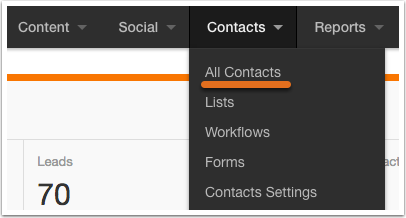 Sort by Create Date to see the most recently created contact record and confirm that your record is there. Click into the contact record and review the information to ensure that all data was properly synced.
Sort by Create Date to see the most recently created contact record and confirm that your record is there. Click into the contact record and review the information to ensure that all data was properly synced.
Repeat this process for all forms on your website, testing creating new contacts as well as updating existing contact records.
What To Write On The Audit for QAing Contact Record Collection
- ✓ = Satisfactory
All forms create and update HubSpot contact records and the form field data matches the HubSpot record field data. - != Needs Improvement
Forms are not asking for enough information for marketing automation. - ❌ = Needs Attention
Forms are not creating and/or updating HubSpot contact records.
Ensure Lists Are Being Properly Utilized
The Big Idea Behind Using Lists in HubSpot
Lists allow you to easily target a specific group of users based on actions they’ve taken. As a result, you can address them with tailored messaging that’s more likely to provide value and elicit a response.
Lists can be used to organize users for workflows, email campaigns, and more. It’s much easier to change the criteria for one list instead of twenty workflows targeting the same people.
Common Symptoms of Issues with Using Lists in HubSpot
The following symptoms may indicate an issue with lists in HubSpot:
- There are no lists in HubSpot
- Lists have generic names (e.g. Conversions or Form Fills)
- Lists are created but do not have users
Examples of Using Lists in HubSpot
Correct
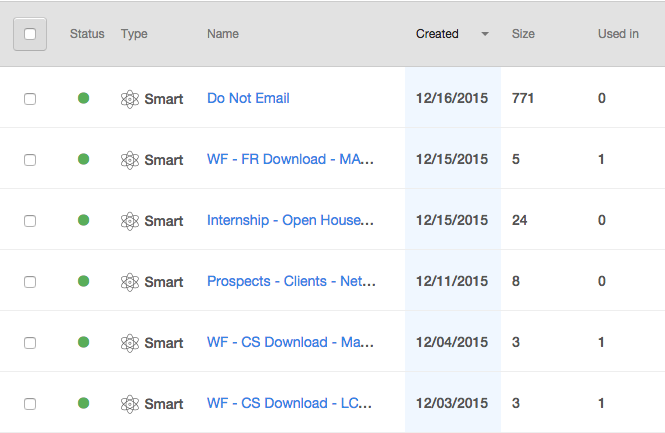
Incorrect
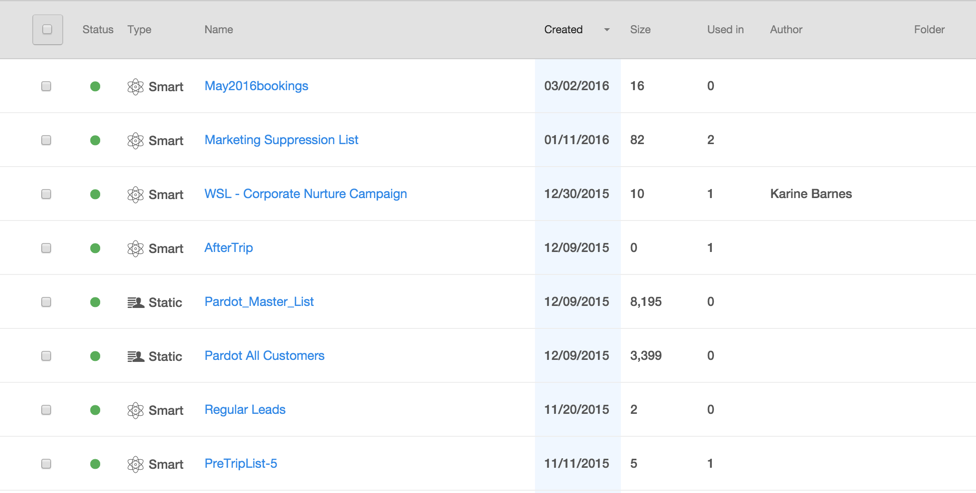
Suggested Tools for Ensuring Lists are Properly Utilized in HubSpot
- HubSpot
Step-by-Step Instructions for Ensuring Lists Are Being Properly Utilized in HubSpot
- Verify that there are lists for all data collection points (e.g. forms, newsletters, etc.)
In HubSpot, navigate to Contacts, then Lists.
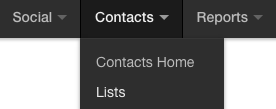 Review the Lists to ensure that one exists for each conversion opportunity on the site, e.g. one for X whitepaper download, one for Y whitepaper download, one for users who filled out the form to subscribe to the email newsletter, etc.
Review the Lists to ensure that one exists for each conversion opportunity on the site, e.g. one for X whitepaper download, one for Y whitepaper download, one for users who filled out the form to subscribe to the email newsletter, etc. - Confirm naming structure is adopted and in use
Lists should be named with a descriptive structure that can be applied to all future conversion points as well. For example, a naming structure could be as follows: [Audience] – [Name of Download], such as “Banking – 7 Tips for Auditing Your Account Download.” Generic list names such as Conversions, or Emails are not useful.
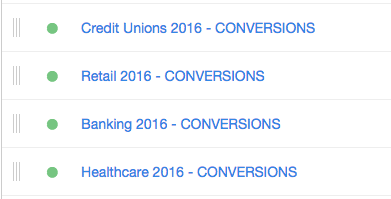
What To Write On The Audit for Ensuring Lists are Properly Utilized
- ✓ = Satisfactory
Lists have been created for all conversion points, and follow an orderly, scalable naming structure. Contacts are assigned to lists in a logical manner. - != Needs Improvement
At least one of the following is true:- Lists have not been created for all conversion points
- Lists do not follow a logical naming structure
- List rules are not comprehensive/ some contacts are not assigned to lists
- ❌ = Needs Attention
Lists have not been created.
Ensure Personas Are Being Applied
The Big Idea Behind Using Personas in HubSpot
Personas allow you to group your customers based on shared characteristics and behavior patterns. They serve as simplified profiles to help you segment your customers so you can market to them effectively.
Common Symptoms of Issues with Using Personas in HubSpot
The following symptoms may indicate an issue with personas in HubSpot:
- Personas are not set up
- Personas are not applied appropriately
- Personas are not logically developed
- Forms do not have fields to assign personas
Examples of Personas in HubSpot
Correct
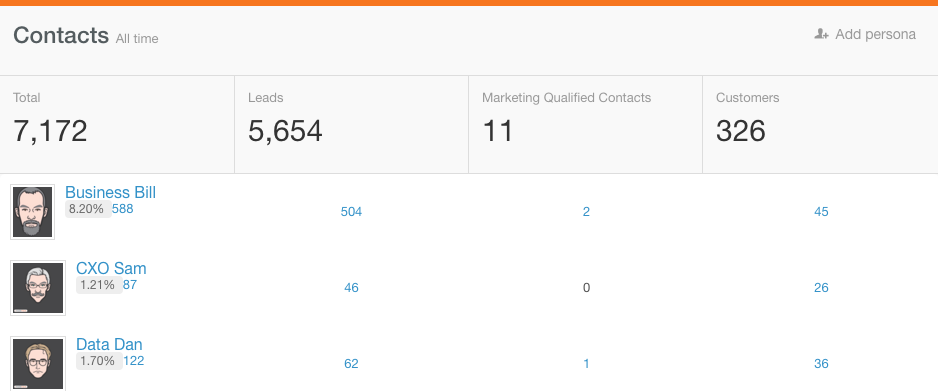
Incorrect

Suggested Tools for Ensuring Personas are Applied
- HubSpot
Step-by-Step Instructions for Ensuring Personas are Applied
- Check that personas are developed and listed
In HubSpot, navigate to the Dashboard. If personas have been developed, you will see them listed in the contacts panel (as shown in the “Correct” image above). - Ensure forms have a field to assign personas
In HubSpot, navigate to Contacts, then Contact Settings. Search for “Persona” and then see if that contact property is used in any forms. Ideally, anyone filling out a form on the website would self-select their persona for future list segmentation.
What To Write On The Audit for Ensuring Personas are Applied
- ✓ = Satisfactory
Personas have been logically developed and all personas have leads/contacts/customers added. - != Needs Improvement
Personas have been developed, but are missing leads/contacts/customers. - ❌ = Needs Attention
Personas have not been created
Ensure Lifecycle Stages Are Being Used
The Big Idea Behind Using Lifecycle Stages in HubSpot
Lifecycle stages indicate where your visitors are in the sales funnel. As a result, you can move them toward the next stage by understanding their needs and engaging them at their current level in the lifecycle.
Examples of Using Lifecycle Stages in HubSpot
Correct
Lifecycle stages have contacts and are used in lists, workflows, and/or forms

Suggested Tools for Using Lifecycle Stages in HubSpot
- HubSpot
Step-by-Step Instructions for Ensuring Lifecycle Stages are Being Used
- Check that the “Lifecycle” property is added to multiple forms, lists and workflows
In HubSpot, go to Contacts, then Contacts Settings. In the search bar in the upper right corner of the screen, type “lifecycle stage” to see the lifecycle stage contact property.Click Lifecycle Stage and then Edit Options in the window that pops up. Confirm that all lifecycle options are listed and that they have a defined internal value.
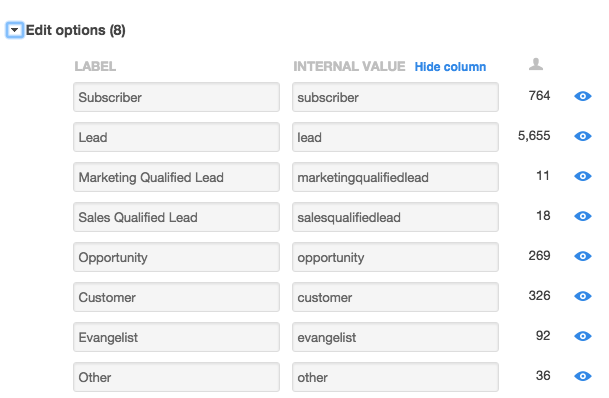 Note if the property is used in lists, workflows, and/or forms.
Note if the property is used in lists, workflows, and/or forms.

Click on these numbers to see where exactly this property is being used. Check with the client that all forms on the site include this property.
To confirm, go to Contacts Home and click into an individual contact record. In the search bar, search for “lifecycle.” Then note if the Lifecycle Stage field is blank or complete.

- Confirm all lifecycle stages have a list
Go to Contact Settings > Search for and click Lifecycle Stage. Confirm that there are lists, and click on the link to confirm there is at least one list for every lifecycle stage.
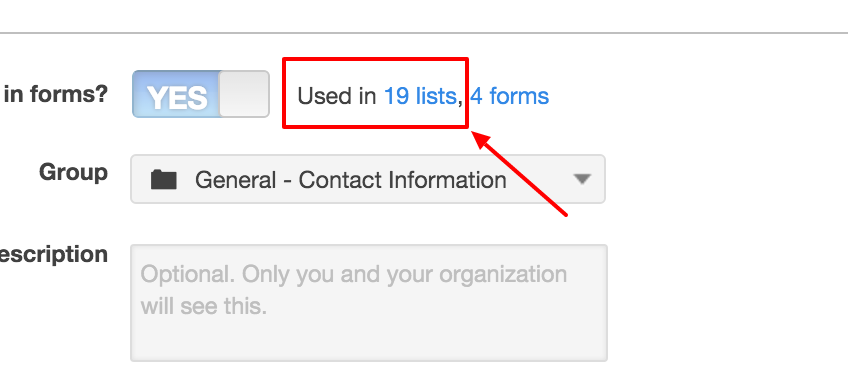
- Confirm SQL leads are being pushed to sales team
While examining the lists, confirm in the left sidebar that the Sales Qualified Lead lists are used in a least one workflow. Confirm that there is a workflow to sync the SQLs with the sales team.
What To Write On The Audit for Ensuring Lifecycle Stages are Being Used
- ✓ = Satisfactory
All lifecycle stages have contacts, and are being used appropriately in lists, workflows, and forms. SQLs are being pushed to the sales team. - != Needs Improvement
At least one of the following is true:- Lifecycle stages do not have contacts
- Lifecycle stages are not being used in lists, workflows, and forms
- SQLs are not being pushed to the sales team.
- ❌ = Needs Attention
Lifecycle stages do not have any contacts – meaning they are not being applied.
Ensure Lead Scoring is Set Up
The Big Idea Behind Lead Scoring
Lead scoring allows you to determine how warm a lead is based on the actions he/she has completed on your site. Ultimately, it tells the sales team who the best leads are to contact and engage with.
Actions that indicate engagement or interest in your products/services are given a positive value based on where the action falls in the sales funnel. For example, upper funnel actions such as subscribing to an email newsletter would be weighted less heavily than lower funnel actions, like requesting information or filling out a contact form. Actions that reflect a loss of interest or poor lead quality are given negative values. For example, unsubscribing from a newsletter or email updates.
Predictive lead scoring is available for Enterprise customers and uses an algorithm to calculate lead scores automatically. We tend to focus on manual lead scoring since it provides more control of how scores are calculated.
Common Symptoms of Issues with Lead Scoring
The following symptoms amy indicate an issue with lead scoring:
- Lead scoring attributes have not been assigned
- A contact’s lead score does not match the actions he/she has taken
- Leads with low scores tend to convert the highest
Examples of Lead Scoring in HubSpot
Correct
Lead scoring attributes have been assigned
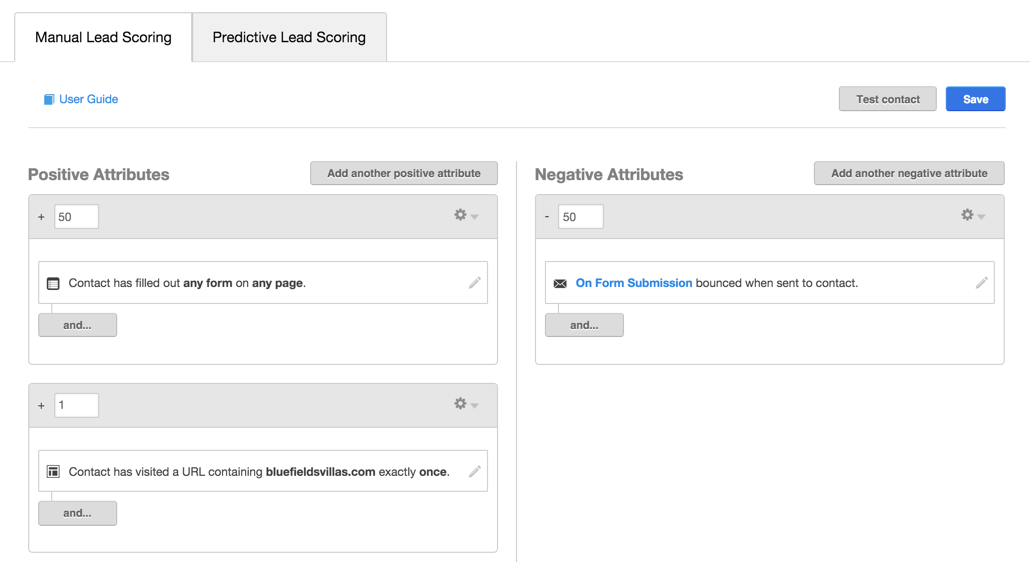
Incorrect
Lead scoring attributes have not been defined

Step-by-Step Instructions for Ensuring Lead Scoring is Set Up
- Verify positive and negative attributes are assigned
In HubSpot, navigate to Contacts, then Lead Scoring. On the left side of the Manual Lead Scoring tab, see if positive attributes are listed. On the right side of the Manual Lead Scoring tab, see if negative attributes are listed.
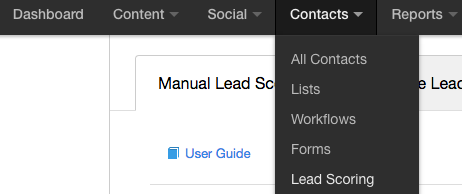
What To Write On The Audit for Ensuring Lead Scoring is Set Up
- ✓ = Satisfactory
Positive and negative attributes have been assigned. - ❌ = Needs Attention
Positive and negative attributes have not been assigned.
Check That Progressive Profiling is Set Up
The Big Idea Behind Progressive Profiling
Progressive profiling is available in Professional and Enterprise versions of HubSpot. It enables you to gather additional data about your visitors and build more complete profiles by adjusting the form fields they see over time.
For example, if a user fills out Form A, and then goes to complete Form B, but Form B has the same fields as Form A, you’re missing an opportunity to get more information about this engaged visitor. Progressive profiling allows you to “queue up” questions so when that visitor goes to Form B, they will see new fields asking for different information.
Progressive profiling builds on the capabilities of smart fields, which hide form fields if a user has already completed them in the past.
Examples of Progressive Profiling in HubSpot
Correct
Progressive profiling is enabled (evidenced by queued questions).

Incorrect
Progressive profiling is not enabled (no queued questions).

Step-by-Step Instructions for Checking that Progressive Profiling is Set Up
- Make sure smart fields are being used
In HubSpot, navigate to Contacts, then Forms. Click into a form and determine if any of the fields are marked as “smart” (icon next to the gear on the right side of the field).

- Ensure smart form fields in queue are ordered by priority
When looking at a form, as described above, scroll down to the “Queued Questions” section. Review the order of the fields to ensure that high-priority fields appear above those that are lower priority. For example, in the screenshot below, the “Email” field is higher priority and will be shown before the “Company Name” field.

What To Write On The Audit for Checking that Progressive Profiling is Set Up
- ✓ = Satisfactory
Progressive profiling with smart fields is set up across all relevant forms and fields are organized in a logical manner. - != Needs Improvement
Progressive profiling is set up, but one of the following is true:- It is not set up on all relevant forms
- The field priority does not make sense
- ❌ = Needs Attention
Progressive profiling has not been set up.
Content
- Ensure emails are optimized
- Determine is multiple templates are in use
- Confirm naming structure is adopted and in use
- Check if personalization is used in emails (e.g. name, company, conversion, etc.)
- Ensure emails are saved for automation if being used in workflows
- Ensure Call-to-Actions are being properly used
- Ensure CTAs (smart or standard) used for all main conversion points
- Ensure CTAs (smart or standard) appear on all pages and landing pages
- Ensure Smart CTAs have multiple rules
- Confirm the blog is not in use
- Landing pages are used and optimized
- Check if smart CTAs have been implemented
- Determine if custom content has been implemented (using COS if you have Professional or Enterprise edition)
- Ensure thank you pages and in-line messages are being properly used
- Ensure all content is assigned a campaign
- Verify that campaigns for business initiatives/goals are set up
- Ensure social post monitoring & scheduling are set up
Ensure All Emails Are Optimized
The Big Idea Behind Optimizing All Emails
For the highest performance impact, it is essential to make sure that marketing automation emails are both organized and personalized. The structure of the email makes it easy to find and edit. The content of the email must be enticing. Grabbing the user’s attention begins with a personal touch.
Utilizing multiple templates is also important because it is the most efficient way to complete workflows in multiple channels. The more customized your templates are, the less work you need to do every time you write a new email.
- HubSpot’s Guide to Optimizing Emails for Different Email Clients (can be useful to ensure that emails render properly)
- HubSpot Email Best Practices
- HubSpot Academy’s Email Marketing Broadcasts
Common Symptoms of Poorly Optimized Emails
If you have a difficult time sorting through emails to find the right one, then you likely haven’t properly organized your emails. Experiencing very little engagement with your email content? Chances are you haven’t engaged the user enough by personalizing the message.
Examples of Optimized Emails
Correct
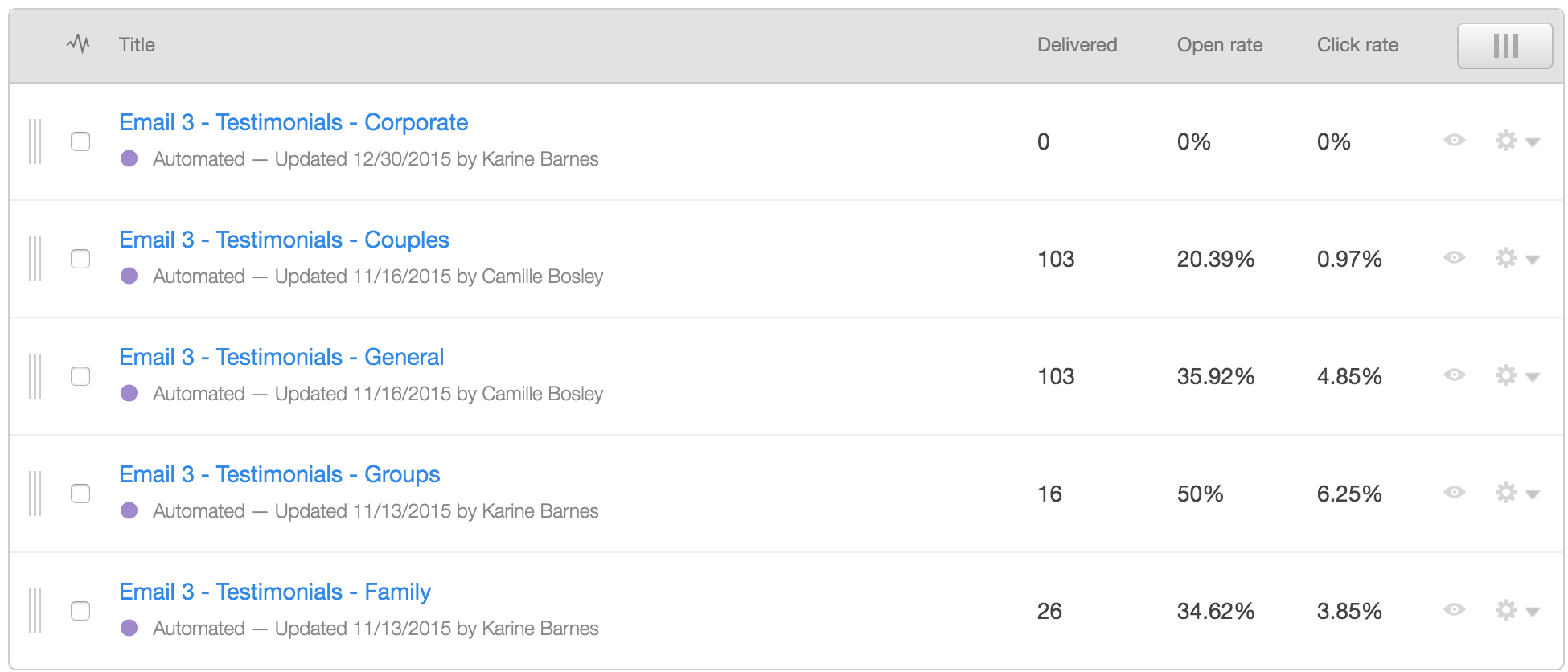
AND
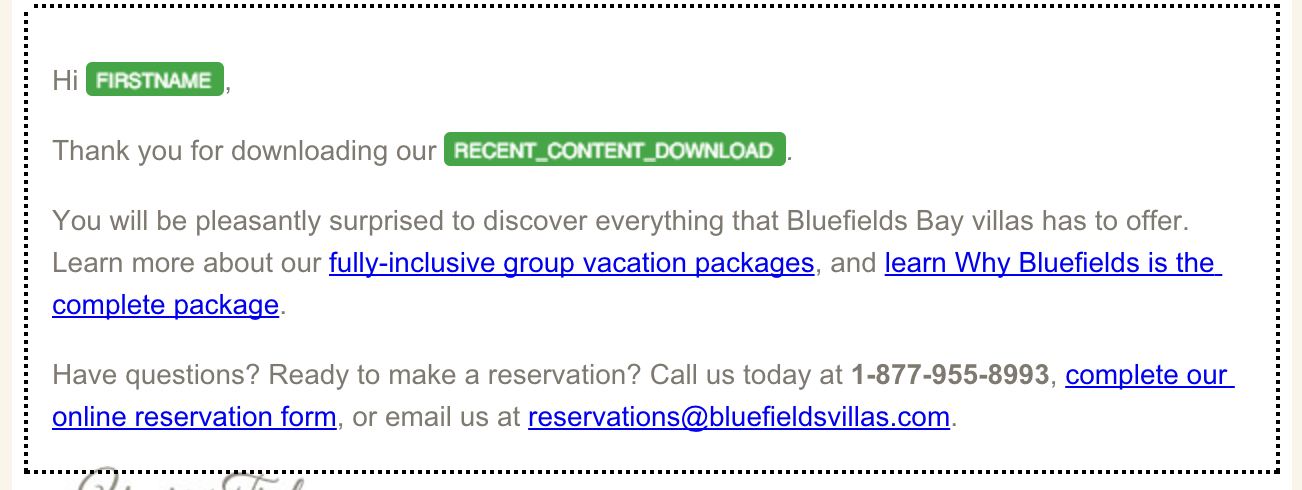
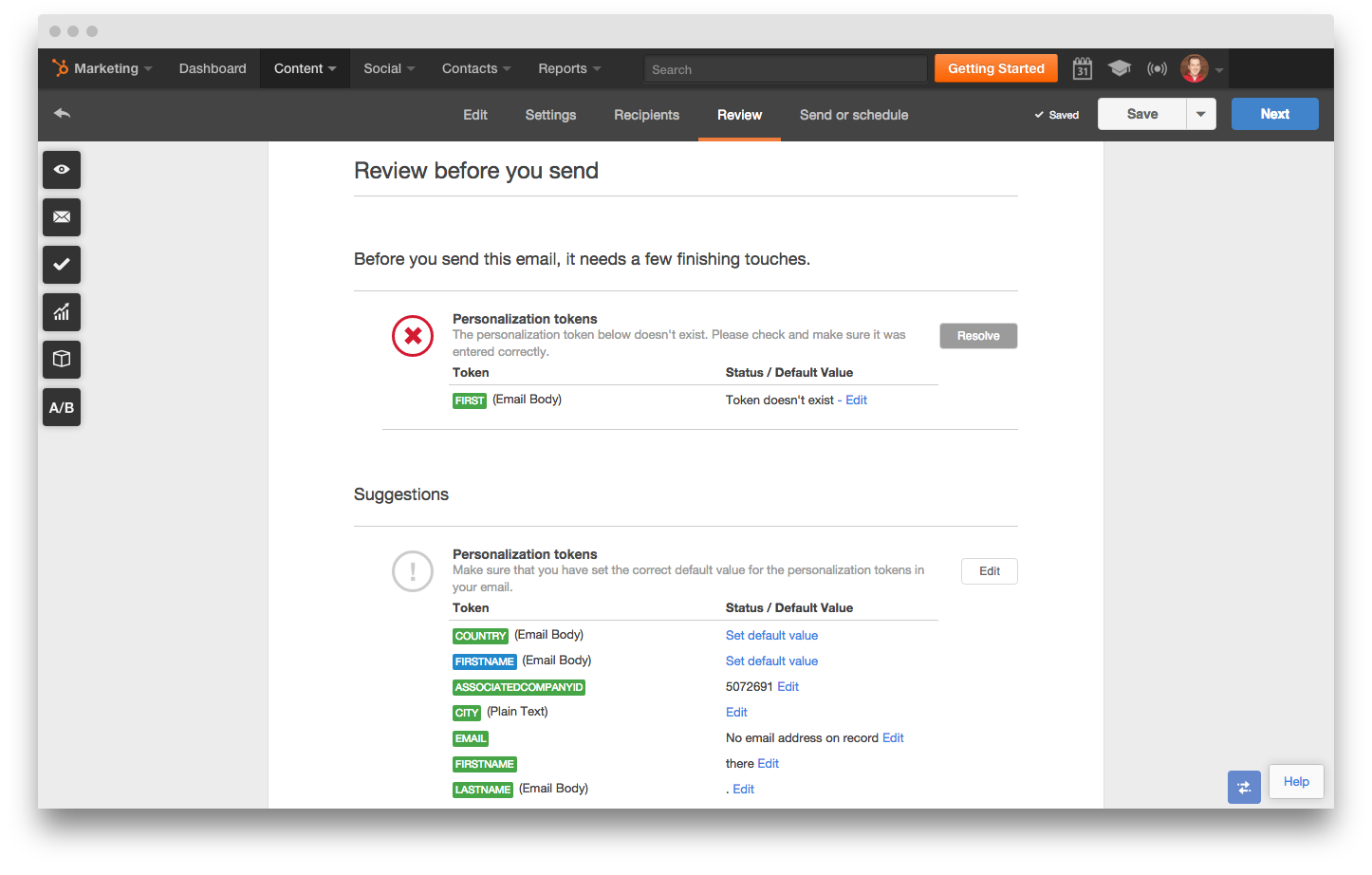
Suggested Tools for Optimized Emails
Step-by-Step Instructions for Optimizing All Emails
- Determine if multiple templates are in use
Inside of HubSpot, go to Content > Design Manager. Confirm that there are relevant templates for all types of email sends (e.g. General, Event Invitation, Transactional Thank You, etc.).
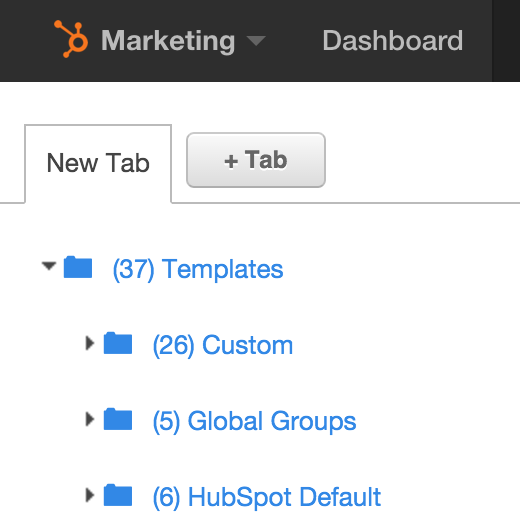
- Confirm naming structure is adopted and in use
View the list of all emails. Confirm that there appears to be a clear and concise naming structure in place to organize groups of emails. Even further, confirm if the emails are grouped in folders.
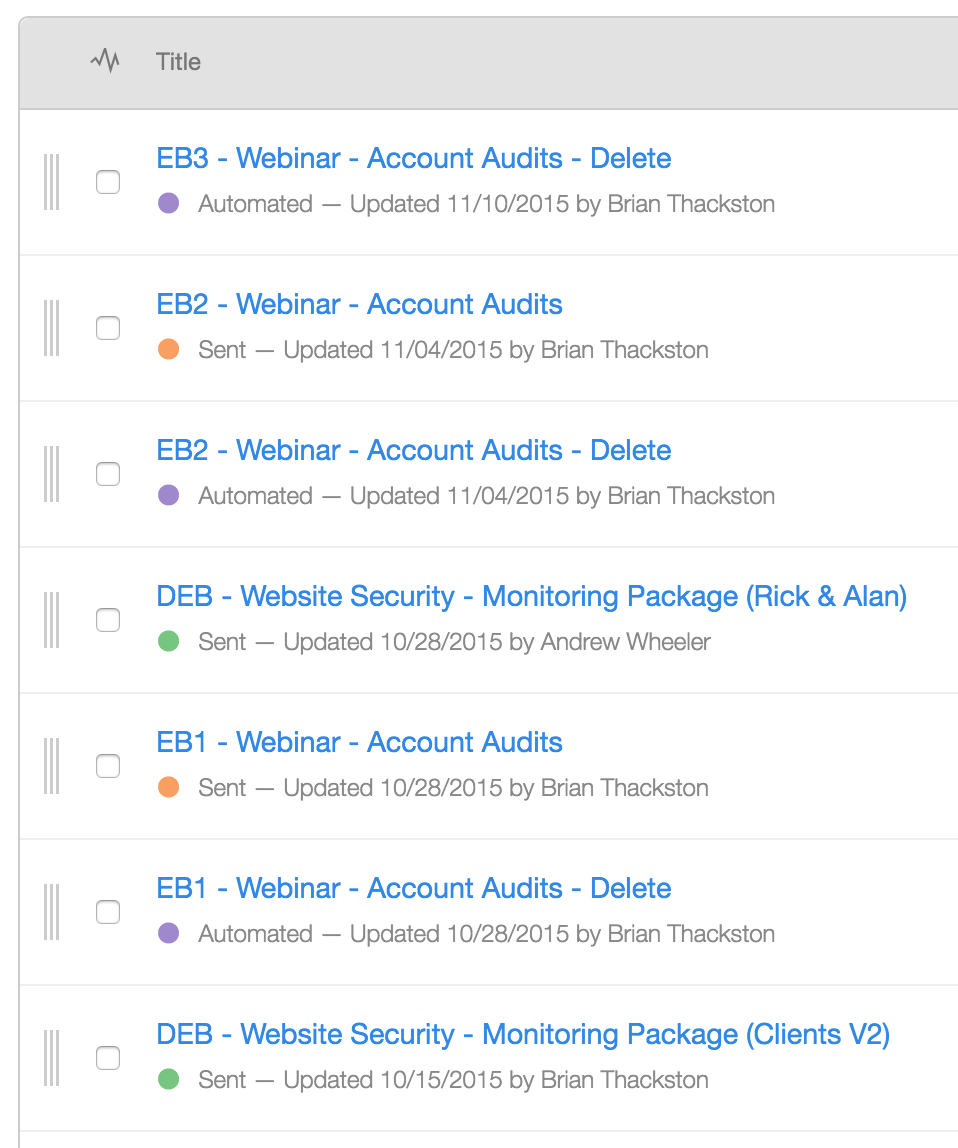
- Check if personalization is used in emails
Open a random selection of 5-10 emails and examine the content in each email. Confirm that each email is using more that one personalization token (e.g. Name, Company, Recent Download, etc.)
What To Write On The Audit for Optimizing All Emails
- ✓ = Satisfactory
Multiple templates are created; a naming structure is in place; emails are using thorough personalization. - != Needs Improvement
Not all emails adhere to the naming structure; emails use minimal personalization - ❌ = Needs Attention
Only default templates are being used; a naming structure is not in place; emails only use one personalization field or none at all
Ensure Call-to-Actions are Being Properly Used
The Big Idea Behind Properly Using Call-to-Actions
Using call-to-actions is the first step in Conversion 101. If you’re not telling your audience what to do, then you can’t expect them to convert on the website.
With HubSpot, you have the convenience of created call-to-action buttons right inside the platform. Even better, you can customize which CTAs appear to which visitors based on their behavior (Smart CTAs).
Long story short, if you don’t have a CTA for something on your website, then you’re basically saying that it isn’t important.
Examples of Call-to-Actions
Correct
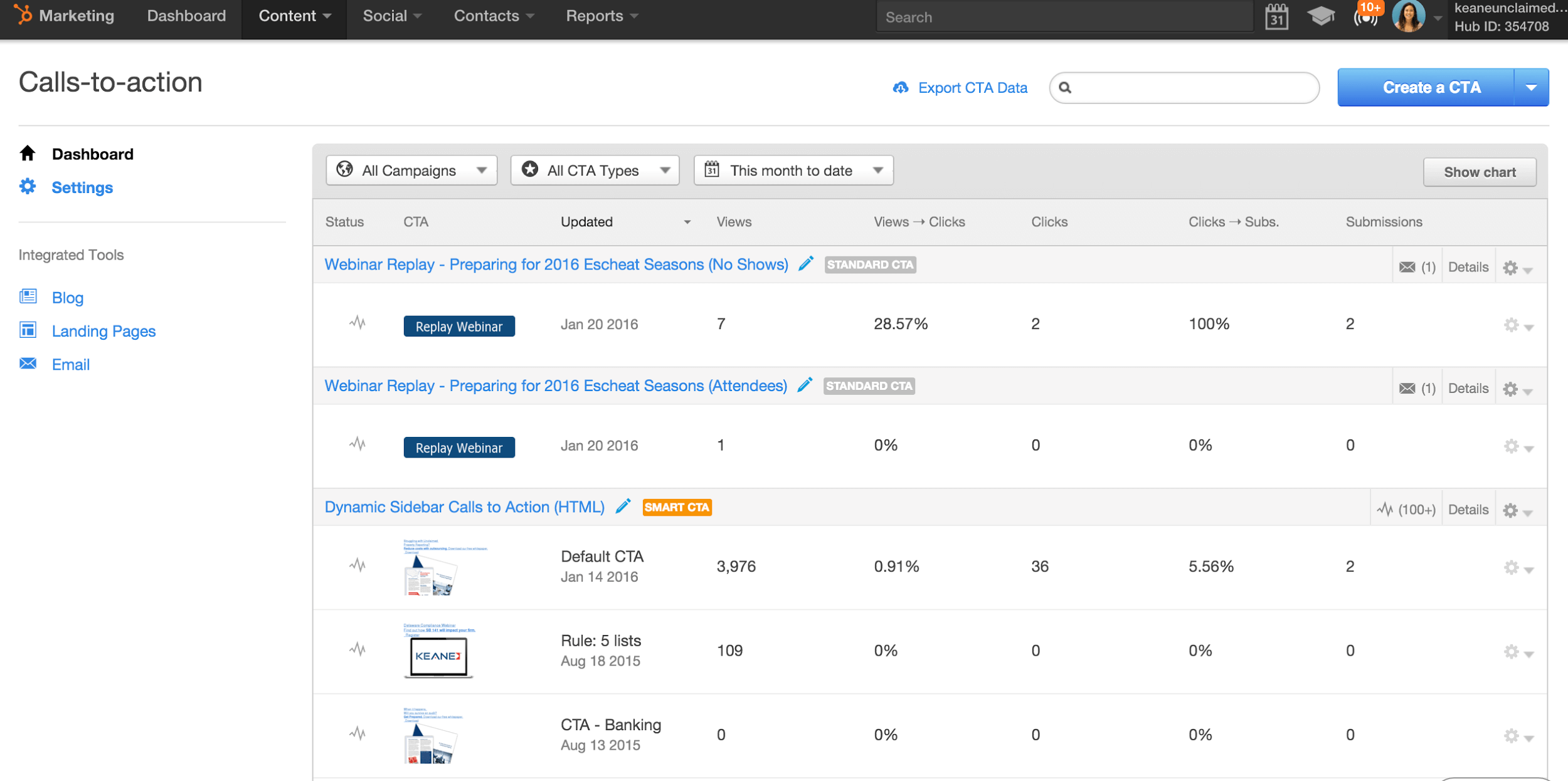
Incorrect

Step-by-Step Instructions for Ensuring Call-to-Actions are Being Properly Used
- Ensure CTAs (smart or standard) are used for all main conversion points
In HubSpot, go to Content > Calls-to-Action. Confirm that CTAs exist for the top conversion activities on the website.Spend 2-3 minutes clicking through the website. Ensure that a CTA appears on all pages of the website. - Ensure Smart CTAs have multiple rules
Filter CTAs to only show Smart Calls-to-Action. Confirm that multiple rules are listed under each Smart CTA.
Confirm that multiple rules are listed under each Smart CTA.
What To Write On The Audit for Properly Using Call-to-Actions
- ✓ = Satisfactory
Standard and Smart CTAs (with multiple rules) are being used. - != Needs Improvement
Only Standard CTAs are being used. - ❌ = Needs Attention
No CTAs are being used at all.
Confirm the Blog is Not in Use
The Big Idea Behind Using the HubSpot Blog
The big picture behind the HubSpot blog revolves mostly around whether or not it’s currently in use. If the client isn’t blogging at all, but plans to in the future, make a note that we recommend they create the blog on their native site and not HubSpot.
If the client is already using the HubSpot blog, this would be an external content audit that doesn’t necessarily relate to the HubSpot marketing audit. Long story short, the blog should be using smart CTAs, custom content, and utilizing forms.
Landing Pages are Being Used and Optimized
The Big Idea Behind Using and Optimizing Landing Pages
There are a lot of ways to create landing pages, but utilizing HubSpot’s functionality makes it easy to tie all of your data and content together. Landing pages are typically designed to collect information; that information should be flowing into HubSpot and the CRM.
Clients don’t need to use HubSpot for landing pages. Many clients will use their native CMS. If they are using HubSpot landing pages, move forward and audit accordingly.
A client may choose to use HubSpot landing pages for its personalization capabilities, quick implementation, and reporting/analytics. However, using HubSpot landing pages can unnecessarily complicate matters; for example, if their Analytics configuration is not fully optimized.
Examples of Using Landing Pages
Correct
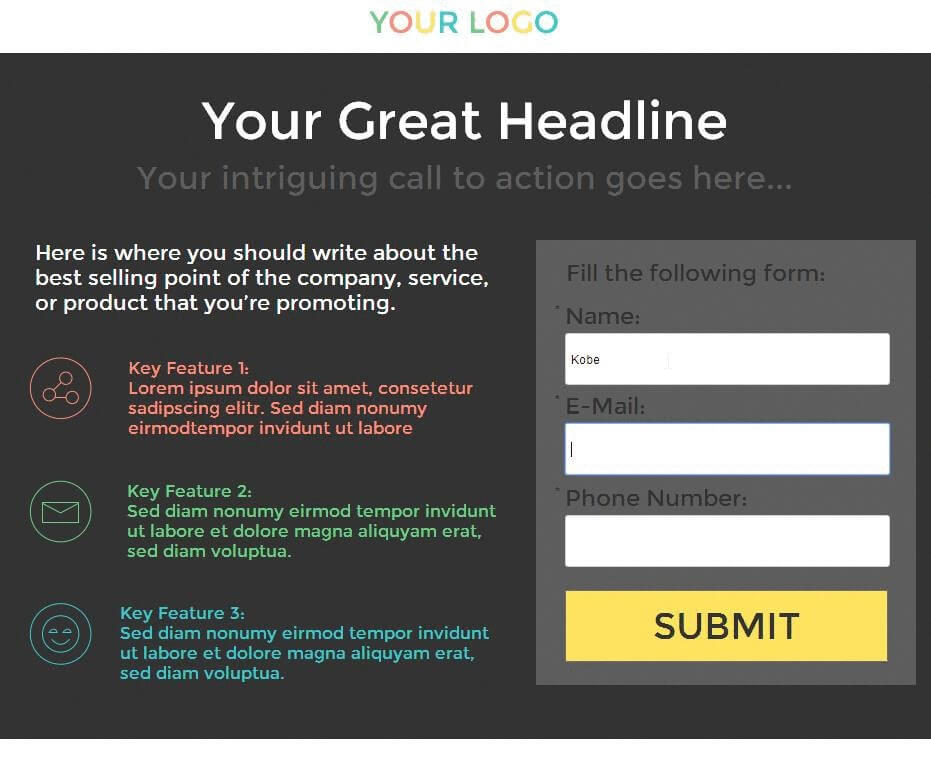
Incorrect

Step-by-Step Instructions for Using and Optimizing Landing Pages
- Ensure there is a form on the landing page
In HubSpot, go to Content > Landing Pages and open a random selection of 10 recently updated landing pages.For each landing page, confirm that there is a form and actionable copy (i.e. specific, language clearly illustrating the goal of the page). - Determine if custom content has been implemented (using COS if you have Professional or Enterprise edition)
To use custom content, the client must have the COS website add-on installed. If it is installed, confirm that the landing pages are using custom content. - Ensure thank you pages and in-line messages are being properly used
For each landing page you’re auditing, click “edit” and then click into the form. Confirm that each form is set to redirect to a thank you page or display appropriate information in an inline message.
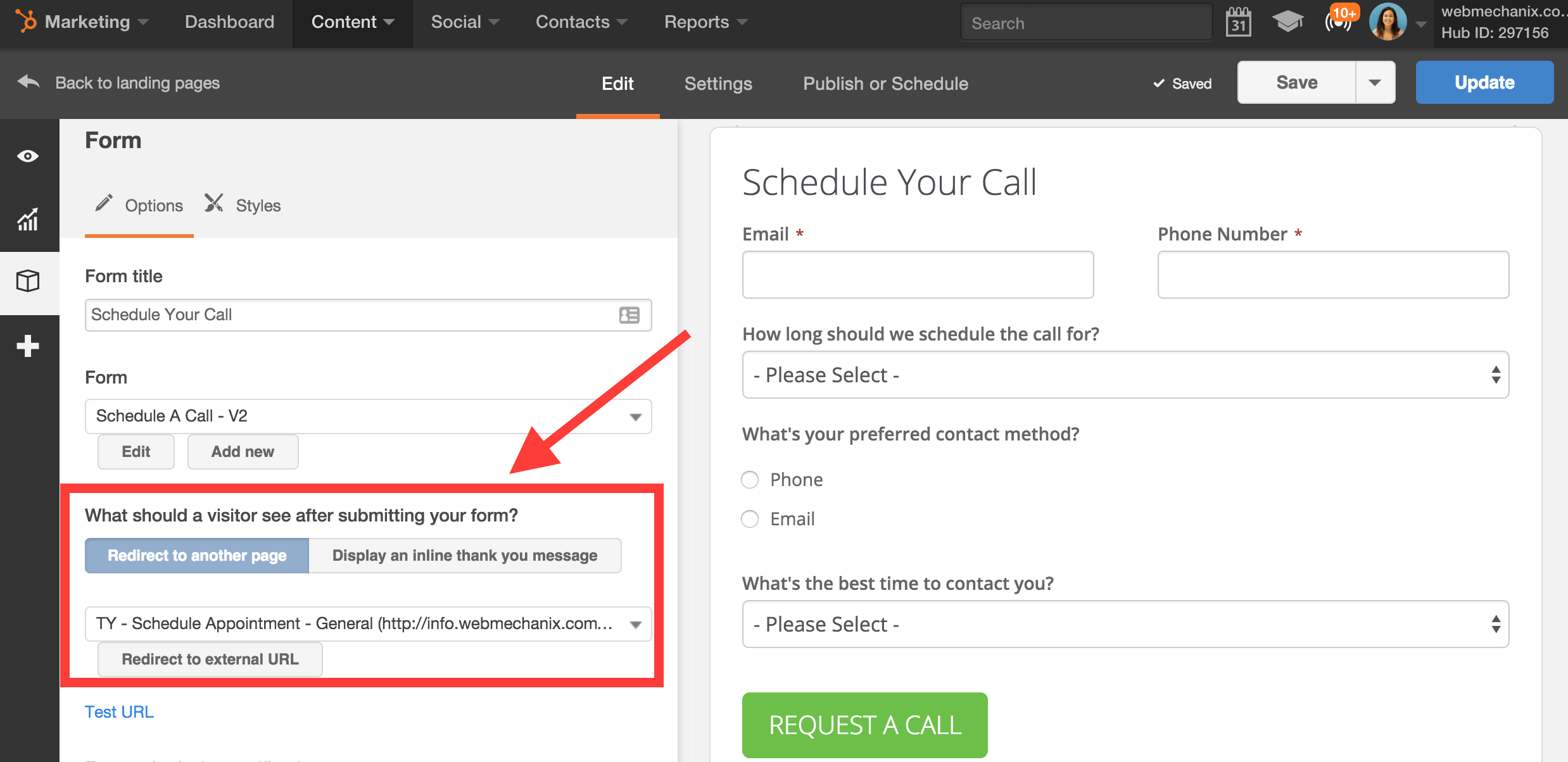
What To Write On The Audit for Using and Optimizing Landing Pages
- ✓ = Satisfactory
All landing pages have a form, actionable copy, and use a thank you page or in-line message. - != Needs Improvement
Landing pages have forms and actionable copy, but thank you pages and/or inline messages are ambiguous or non-existent. - ❌ = Needs Attention
Landing pages are missing forms and/or actionable copy and don’t use thank you pages or inline messaging.
Ensure Campaigns are Being Used
The Big Idea Behind Using Campaigns
Campaigns allow you to group and measure collective marketing efforts across multiple channels. For example, if you launch a Holiday marketing campaign with numerous social posts, emails, workflows, and landing pages, a HubSpot campaign would allow you to easily see the combined results of all these efforts.
Examples of Using Campaigns
Correct
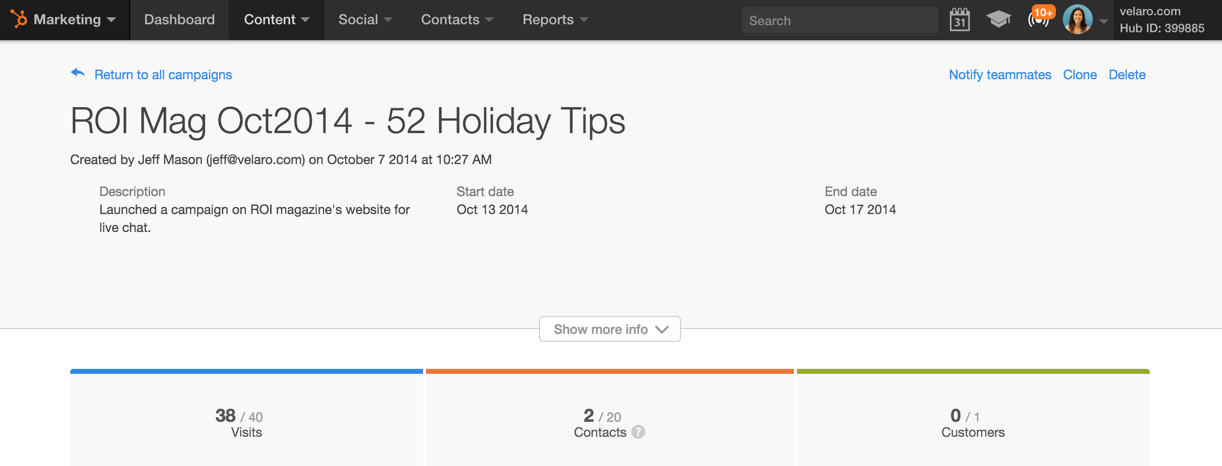
Step-by-Step Instructions for Ensuring Campaigns are Being Used
- Verify that campaigns for business initiatives/goals are set up
In HubSpot, go to Content > Campaigns. Within the list of campaigns, verify that campaigns for the client’s most recent initiatives are reflected in the list.Inside of those specific campaigns, confirm that they have set goals for visits, contacts and customers. Each campaign should also have a start and end date.
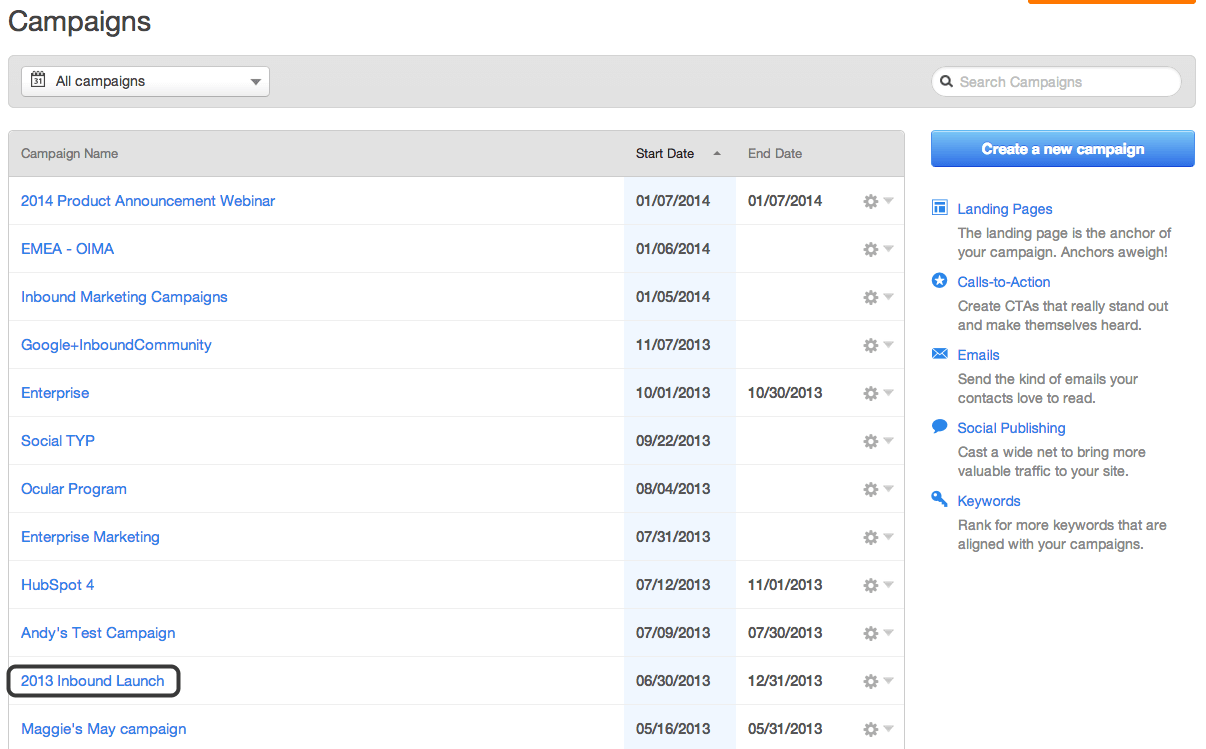
What To Write On The Audit for Ensuring Campaigns are Being Used
- ✓ = Satisfactory
Numerous campaigns exist with complete criteria. - != Needs Improvement
Campaigns exist, but without goals or start/end dates. - ❌ = Needs Attention
Campaigns don’t exist.
Ensure Social Post Monitoring and Scheduling is Set Up
The Big Idea Behind Monitoring and Scheduling Social Posts
Using HubSpot to schedule and monitor your social media posts helps you better engage with your audience. With your social accounts linked, you can begin connecting the dots with leads who are engaging both on and off your website.
Social media monitoring can help you gauge how people feel about your brand/company, understand their pain points, etc. You could also set up monitoring for your industry to ensure you can quickly see trends and news (which you could then use to create relevant content). Another great way to use HubSpot’s social monitoring tool is to keep track of what users are saying about your competitors and what they are posting. You can use this information to get a better idea of the competitive landscape and adjust strategies as needed.
Common Symptoms of Improperly Monitoring and Scheduling Social Posts
For social media scheduling, if the client doesn’t have their social media accounts listed, and there aren’t any posts scheduled, social media is being improperly utilized through HubSpot.
Additionally, if there are no filters being run on social networks (e.g. Filter all posts containing “WebMechanix”) then there is no social media monitoring going on.
Examples of Monitoring and Scheduling Social Posts
Correct
Posts are scheduled

Incorrect
No posts have been scheduled

Correct
Monitoring has been set up

Incorrect
Monitoring has not been set up
Under Monitoring in Social Media, there would not be any tweets or streams.
Suggested Tools for Monitoring and Scheduling Social Posts
Step-by-Step Instructions for Monitoring and Scheduling Social Posts
- Confirm that social media accounts are linked to HubSpot
In HubSpot, go to Social > Social Settings. Ensure that all of the applicable social media networks (i.e. Facebook, Twitter, LinkedIn, Google+, Xing) are listed and linked. - Confirm that social posts are being scheduled
In HubSpot, go to Social > Publishing. In the second tab, you should see “Scheduled”. If there is a number in parenthesis, then posts are being scheduled. If it simply says “(none),” then posts are not being scheduled. Refer to the images above.
Note: If you don’t see anything scheduled, ask the client if they are using any other tools to schedule their posts (e.g. Hootsuite, Buffer, etc.). - Confirm that social media monitoring has been set up
In HubSpot, go to Social > Monitoring. If there are streams set up, you will see tabs with Twitter feeds, as shown.
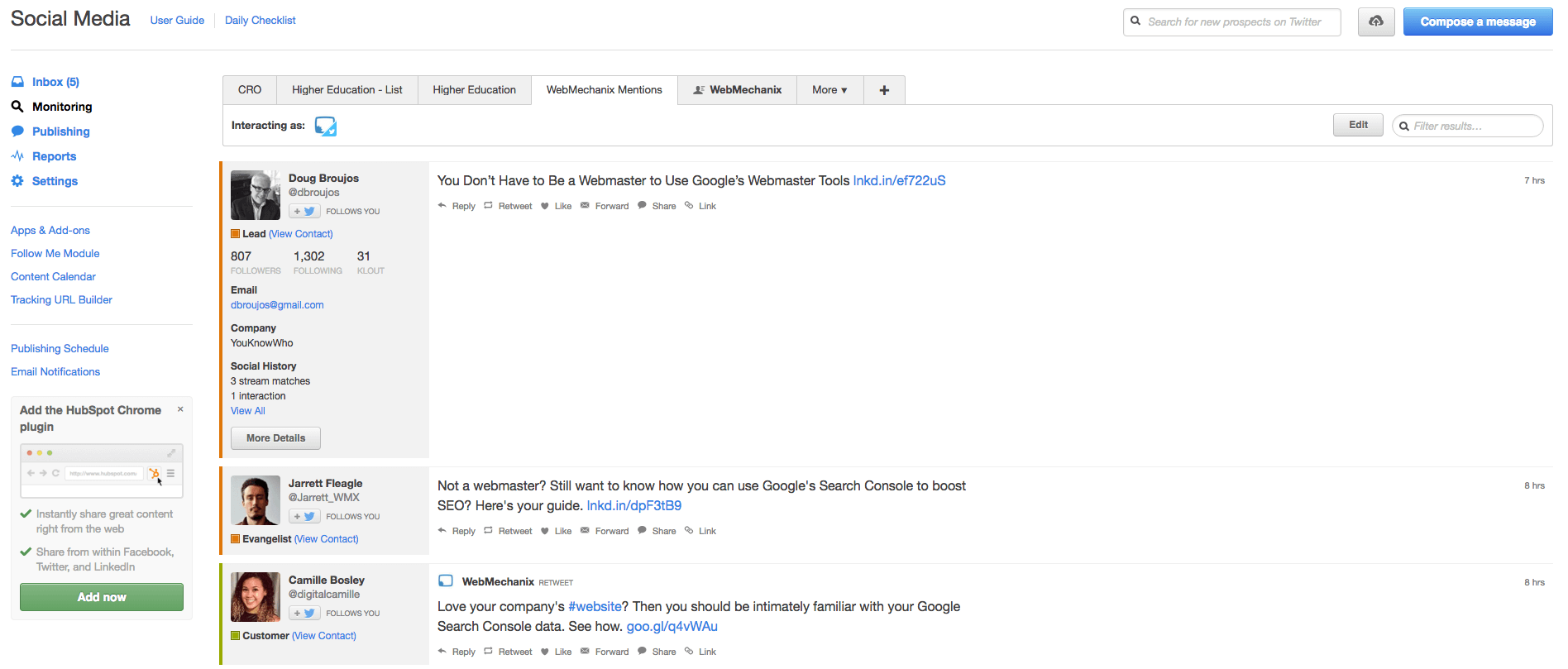 If you do not see any tabs or Tweets, social media monitoring has not been configured.
If you do not see any tabs or Tweets, social media monitoring has not been configured.
What To Write On The Audit for Monitoring and Scheduling Social Posts
- ✓ = Satisfactory
Social media accounts are linked, posts are being scheduled, and monitoring has been configured. - != Needs Improvement
Social media accounts are linked but no posts are being scheduled, some of the social accounts are missing, or monitoring has not been configured. - ❌ = Needs Attention
None of social media accounts are linked, there aren’t any posts scheduled, and monitoring hasn’t been configured.
Workflows
- Ensure workflows are being used
- Verify that workflows exist for each service area
- Verify that multiple workflows have active contacts
- Ensure a naming structure is being used
- Check that associated workflows are named similarly
- Review criteria for all workflows
- Ensure enrollment settings are accurately configured
- Verify that there is a description for the workflow
- Test a sample for glaring issues (e.g. no delay before drip campaigns, email settings, outdated workflow options, broken if/then triggers)
- Check that there is a goal for the workflow
- Ensure workflow settings are accurately configured
- Ensure date/time range for executing actions is accurate
- Ensure campaigns is assigned to workflow
- Ensure re-enrollment options are accurate
- Ensure suppressions and priorities are accurate
Ensure Workflows Are Being Used
The Big Idea Behind Using Workflows in HubSpot
HubSpot workflows allow you to enroll contacts in marketing automation cycles based on website interactions and other information collected by HubSpot. Then, you can nurture these contacts through systematically delivered, personalized messages. This ensures that you’re fostering relationships with all new leads as soon as they express interest in your product/service.
Workflows also allow you to bulk update contact records. You can specify criteria for inclusion in the workflow (e.g. all contacts who submitted job application form) and then update all contact records for those who meet that criteria with additional information (e.g. contact property “prospect type” = “employee”).
Common Symptoms of Issues with Workflows in HubSpot
The following symptoms may indicate an issue with HubSpot Workflows:
- There are no workflows set up
- Workflows are set up but do not have any contacts and/or are inactive
Examples of Ensuring Workflows are Being Used
Correct
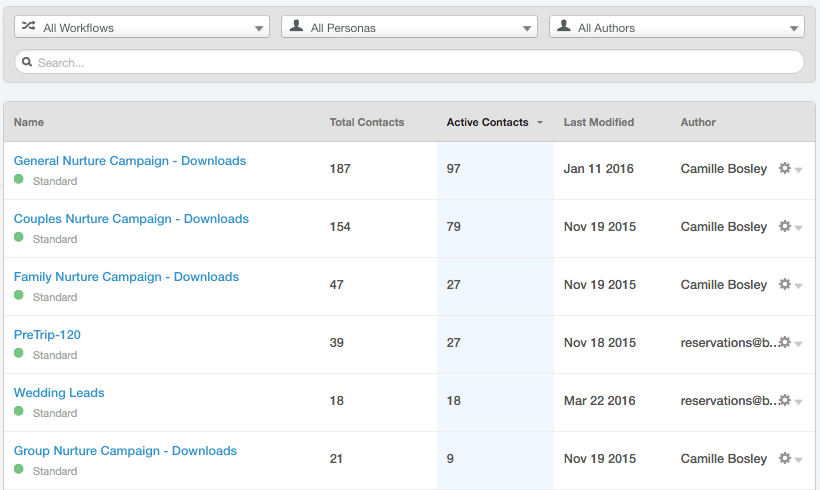
Incorrect
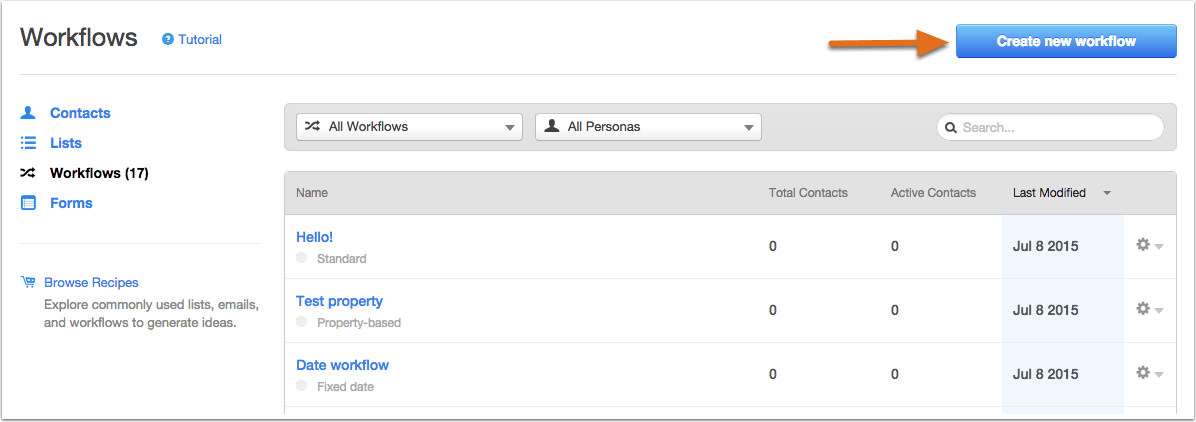
Step-by-Step Instructions for Ensuring Workflows are Being Used
- Verify that workflows exist
Under Contacts > Workflows, sort to view all active workflows.
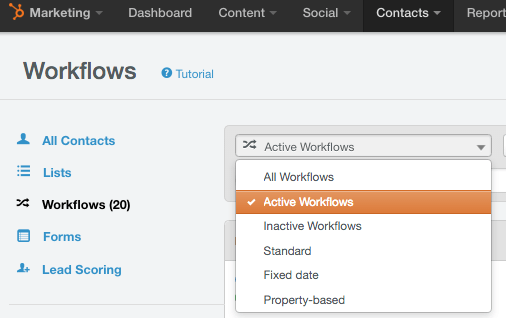
Using the search bar, or by scrolling, confirm that workflows exist. - Verify that workflows have enrolled contacts
It’s great if the client has workflows created, but we need to make sure they have been actually been used.Confirm that the majority of workflows have contacts listed as enrolled and/or active.
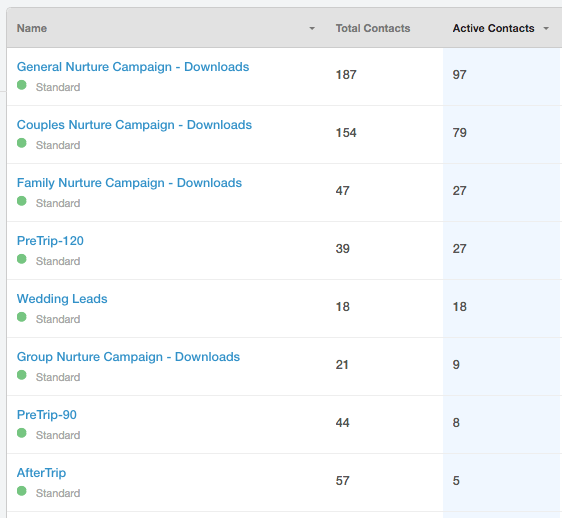
What To Write On The Audit for Ensuring Workflows are Being Used
- ✓ = Satisfactory
Workflows are set up and enrolling contacts - != Needs Improvement
Workflows are set up but not enrolling contacts - ❌ = Needs Attention
No workflows have been created
Ensuring a Naming Structure is Being Used
The Big Idea Behind Using a Naming Structure for Workflows
A logical, consistent naming structure makes it easier to organize workflows, especially as you add more over time. It can also provide an at-a-glance overview of what the workflows do.
Common Symptoms of Issues with Using a Naming Structure for Workflows
The following symptoms may indicate an issue with the naming structure of HubSpot Workflows:
- Naming is irregular or inconsistent across workflows
- No identifiable naming structure exists
- Naming structure is faulty/and or not scalable
Examples of Using a Naming Structure for Workflows
Correct
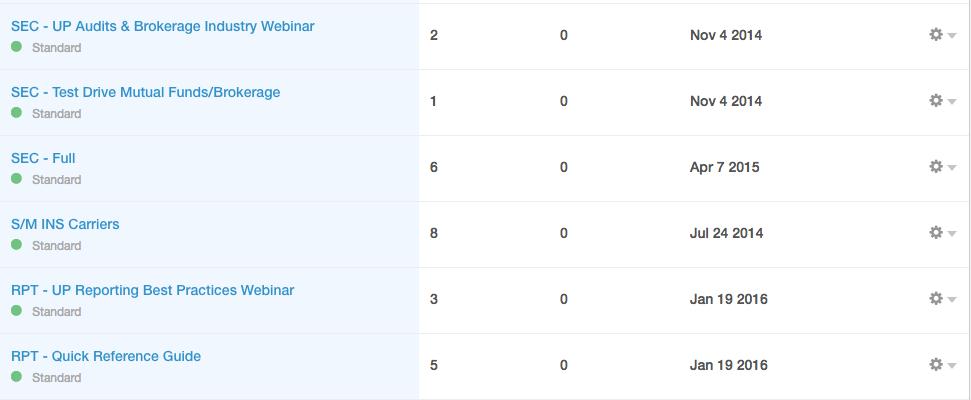
Incorrect
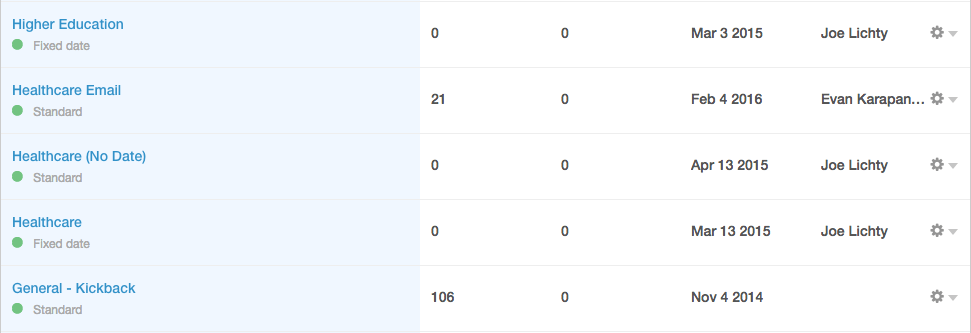
Step-by-Step Instructions for Ensuring a Naming Structure is Being Used
- Check that associated workflows are consistently and descriptively named
In HubSpot, navigate to Contacts, then Workflows. Sort workflows by name to see if they are organized clearly.
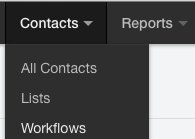
Note: If your client is lacking a naming structure, recommend a clear nomenclature for them. For example, [Service Area] – [Audience] – [Action] which may look like “Banking – New Leads – Downloaded Audit Guide”.
What To Write On The Audit for Ensuring a Naming Structure is Being Used
- ✓ = Satisfactory
Workflows follow a logical, scalable naming structure. - != Needs Improvement
A naming structure or structures have been created but are irregular across the account. - ❌ = Needs Attention
No naming structure has been established.
Review Starting Material For All Workflows
The Big Idea Behind Using Criteria for Workflows
Workflow criteria allow you to select who will be enrolled in a workflow based on a website interaction or one of their contact properties. As a result, you can segment visitors into highly relevant workflows with messaging matches the contact’s interests.
Common Symptoms of Issues with Workflow Criteria
The following symptoms may indicate an issue with workflow criteria in HubSpot:
- Too many people are being enrolled in workflows
- Too few people are being enrolled in workflows
Examples of Reviewing Workflow Criteria in HubSpot
Correct

Step-by-Step Instructions for Reviewing Workflow Criteria in HubSpot
- Ensure enrollment criteria is accurately configured
Open the workflow or workflows that you want to audit. At the top of the page is the the enrollment criteria, which show the conditions that must be met for a contact to be enrolled in the workflow. Confirm that these settings target the right group of visitors.
Note: If enrollment criteria potentially includes contacts who should be excluded from the workflow, these contacts can also be excluded using “Suppression Lists” under Settings, which is discussed in the workflow settings section below.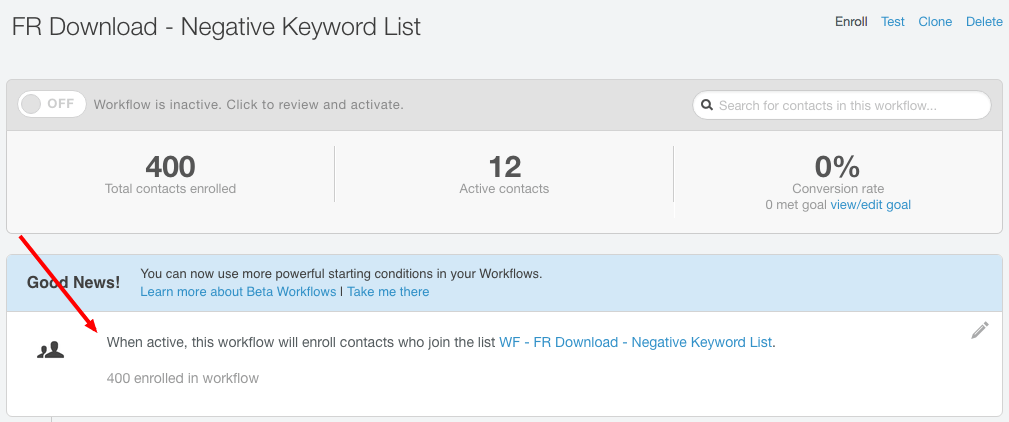
- Verify that there is a description for the workflow
In HubSpot, navigate to Contacts, then Workflows. Click into a workflow and look in the left sidebar under Workflow Details to see if a description has been added.
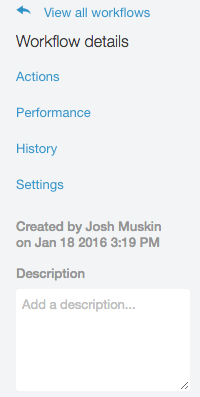
- Test a few workflows for glaring issues (e.g. no delay before drip campaigns, outdated workflow actions, broken if/then triggers, etc.)
To run a test, click into Contacts, then Workflows, and select one of the active workflows. In the upper right hand corner of the page, click Test.
 Enter the name of a test contact to enroll it in the workflow. All steps will be executed, including email sends. Confirm that all actions take place and at the right time.
Enter the name of a test contact to enroll it in the workflow. All steps will be executed, including email sends. Confirm that all actions take place and at the right time. - Check that there is a goal for the workflow (if applicable)
To see if a workflow has a goal, click into a workflow and then look in the upper right hand corner of the screen. A goal, if applicable, should be listed under the search bar (shown below) and will remove contacts from the workflow when the goal has been completed.

What To Write On The Audit for Reviewing Workflow Criteria in HubSpot
- ✓ = Satisfactory
Workflow enrollment and goals have been configured appropriately and include only steps and content relevant to the goal. There is a detailed description and no glaring issues. - != Needs Improvement
At least one of the following is true:- Enrollment settings are not configured accurately
- There is no description of the workflow
- A test shows an error with the workflow’s function
- There is no goal for the workflow
- The workflow includes steps and content that are not required to reach the
established goal
- ❌ = Needs Attention
Workflow criteria has not been established.
Ensure Workflow Settings Accurately Configured
The Big Idea Behind Ensuring Workflow Settings are Accurately Configured
Incorrectly configured workflow settings can inadvertently derail the best laid workflow plans. Settings are where you can exclude specific lists (e.g. current customers) and make sure your actions only fire on weekdays.
Common Symptoms of Issues with Workflow Settings
The following symptoms may indicate an issue with workflow settings in HubSpot:
- Actions are not completed according to the desired timetable
- Workflows include contacts that should not be targeted or excludes those that should be targeted
- Contacts are able to re-enroll in the workflow when they should not be able to do so and vice versa
Step-by-Step Instructions for Ensuring Workflow Settings are Accurately Configured
- Ensuring date/time range for executing actions is accurate
Under Contacts, then Workflows, click into a workflow. Then in the left sidebar, click Settings. Toward the top of the page there are two fields related to execution timing: “Execute actions on business days only?” and “Execute actions only within a certain time range?” Confirm that these settings are logical according to the client’s needs.
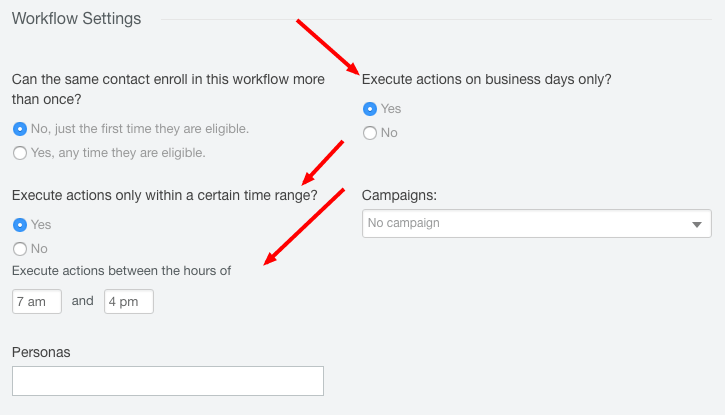
- Ensure a campaign is assigned to workflow (if applicable)
Under Contacts, then Workflows, click into a workflow. Then in the left sidebar, click Settings. On the right side, toward the top of the page there is a dropdown menu for Campaigns. Check to see that a campaign has been assigned to the workflow, if one is applicable.
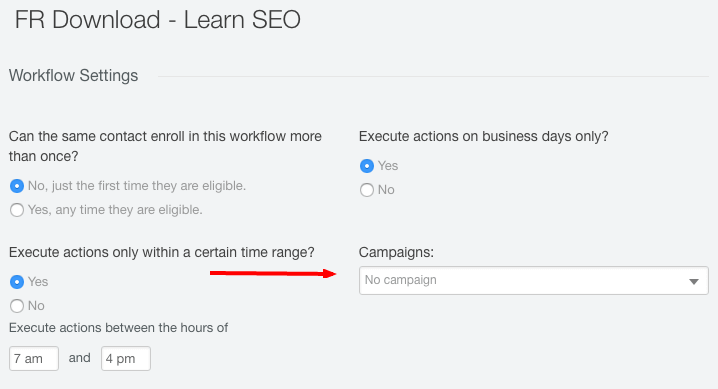
- Ensure re-enrollment options are accurate
Determine if contacts should be able to re-enroll in a workflow (i.e. will contacts potentially need to receive the same content or have similar properties updated). Then to check the re-enrollment setting, click into a workflow, then Settings, and look in the upper left corner where it says “Can the same contact enroll in this workflow more than once?”
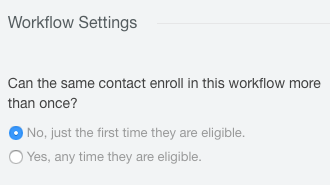
- Ensure suppressions & priorities are accurate
Click into a workflow, and then click Settings in the left sidebar. Scroll down to the Suppressions & Priorities section and check that there are no errors (such as a suppression list preventing the right contacts from joining the workflow).
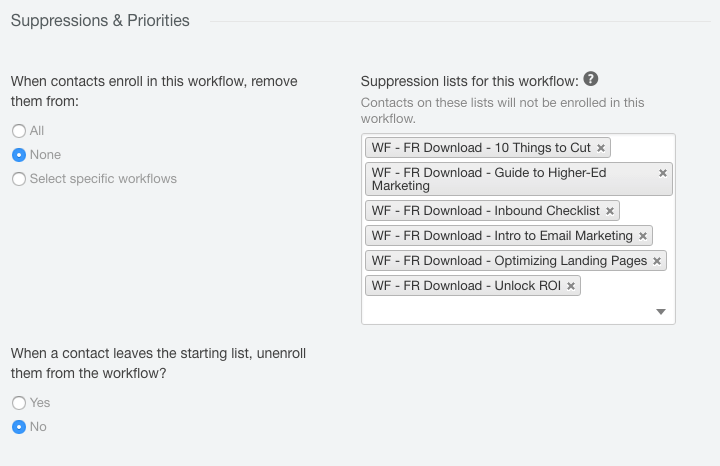
What To Write On The Audit for Ensuring Workflow Settings are Accurately Configured
- ✓ = Satisfactory
There are no errors with workflow settings. - != Needs Improvement
At least one of the following is true:- Workflows do not account for CRM sync time
- The date/time range for executing actions is not accurate
- There is no campaign assigned to a workflow
- Re-enrollment options are not accurate
- Suppressions and priorities are not accurate
- ❌ = Needs Attention
At least two of the following are true:- Workflows do not account for CRM sync time
- The date/time range for executing actions is not accurate
- There is no campaign assigned to a workflow
- Re-enrollment options are not accurate
- Suppressions and priorities are not accurate
Integrations
- Ensure all web forms integrated with HubSpot
- Verify that as many fields as possible have been assigned to the form
- Send a test submission through the forms
- Ensure CRM properly integrated with HubSpot (Salesforce, Zoho, etc.)
- Ensure all necessary fields between HubSpot and CRM are mapped
- Verify that there is a CRM sync list
- Check for any errors in integrations
- Confirm all integrations are syncing correctly
- Confirm all field mappings are properly syncing
- Confirm API call limits are not being hit
Ensure All Web Forms are Integrated with HubSpot
The Big Idea Behind Integrating Web Forms with HubSpot
Integrating all of the forms on your website with Hubspot is the best way to collect valuable user information from website visitors — both personally identifiable information (e.g. name, email, etc.) and engagement information (e.g. pages visited, CTAs clicked, etc.).
By filling out a HubSpot-integrated form, a contact creates a unified contact record that merges their personally identifiable information and their engagement information. When paired together, this information allow you to personalize your content, created more segmented email lists, and generally create better marketing campaigns.
Some website’s use forms other than HubSpot forms (e.g. Gravity Forms) don’t, so we need to make sure all the forms — regardless of type — push their data into Hubspot..
Common Symptoms of Issues with Integrating Web Forms with HubSpot
- Data is not being synced between your website leads and Hubspot (i.e. form submission data doesn’t show up in HubSpot).
Ideally, the client would know if forms are integrating because they would be missing information, but you can also ask a member from your development team to investigate with you.
Step-by-Step Instructions for Integrating Web Forms with HubSpot
- Verify that form fields are being applied to HubSpot contact records
Navigate to a form on the website. Use Inspect Element to view the HTML of the form, and note all of the fields the form is collecting.

- Send a test submission through the forms
Complete the form as a test. Then navigate to Contacts in Hubspot and check the contact record to confirm that it contains all submitted data.Repeat this process 2-3x using different email addresses to test a sample of different forms on the website.
What To Write On The Audit for Integrating Web Forms with HubSpot
- ✓ = Satisfactory
All forms are sending marketing fields directly into HubSpot - != Needs Improvement
Some, but not all, marketing fields are being sent from forms to HubSpot - ❌ = Needs Attention
None of the forms on the website are sending marketing fields to HubSpot
Ensure CRM is Properly Integrated with HubSpot (Salesforce, Zoho, etc)
The Big Idea Behind Integrating the CRM with HubSpot
The goal of integrating a CRM with Hubspot is Smarketing: the process of integrating the sales and marketing process of a business.
By syncing website engagement data with the CRM, both processes are enhanced. This union allows marketers to push sales qualified leads leads directly to the sales team in the CRM. If users are not ready to buy, the sales team can kick them back to Hubspot workflows and nurture them further.
Ultimately, the point of integrating Hubspot with the CRM is to make sure that all data lives in both systems to increase efficiency, maintain consistency, and optimize the sales and marketing processes.
Common Symptoms of Issues with Integrating the CRM with HubSpot
See “Errors in Integrations” section below
Examples of Integrating the CRM with HubSpot
Correct

Incorrect

Suggested Tools for Integrating the CRM with HubSpot
- Bedrock
- Zapier
- Podbox
Step-by-Step Instructions for Integrating the CRM with HubSpot
- Ensure all necessary fields between HubSpot and CRM are mapped
Pull up the same record in both the CRM and HubSpot to see if all necessary information matches. If not, check “Integrations > Field Mappings” in HubSpot to ensure that a mapping for that field exists. If it does, check errors below.
Note: Some clients only want specific contacts to being added to their CRM — e.g. sales qualified leads, not marketing qualified. So, they may have rules for which contacts and/or fields are mapped to the CRM. - Verify that there is a CRM sync list
Under Integrations > Settings, confirm that there is an Inclusion List. Check the criteria for the noted inclusion list.

What To Write On The Audit for Integrating the CRM with HubSpot
- ✓ = Satisfactory
All fields are being synced between HubSpot and the CRM correctly - != Needs Improvement
Inclusion list is not properly defined - ❌ = Needs Attention
Field mappings are missing or broken and/or inclusion list does not exist
Check for Errors in Integrations
The Big Idea Behind Errors with Integrations
If there are errors with your integrations, you’re going to get partial data or no data at all syncing.
Common Symptoms of Errors with Integrations
The following symptoms may indicate an issue with the integration (but note they may also be indicative of other issues):
- Login credentials have expired
- Maxing out API call limits
- Changes in security token
- Invalid field mappings
Examples of Errors with Integrations
Correct

and

Incorrect


Suggested Tools for Errors with Integrations
- Hubspot’s Guide to Identifying and Fixing Salesforce Sync Errors
- Hubspot’s Help Section for Sync Errors
Step-by-Step Instructions for Errors with Integrations
- Confirm all integrations are syncing correctly
Go to your account menu and select integrations. Confirm that all of the integrations have a green message noting they are integrated properly.Click inside of each individual integration and select the “Sync Errors” tab. Confirm that there are no records listed (see images above for correct and incorrect listings).

- Confirm all field mappings are properly syncing
Inside of each individual integration, select the tabs related to “mappings.” Confirm that none of the standard or custom mappings are yellow or red.This is an example of field mappings that have errors:

- Confirm API call limits are not being hit
Under “API Call Limit,” confirm that the API limit considerably exceeds the calls within the last 24 hours.

If they are close in range, ask the client if they have ever received email warnings that they are exceeding the API call limit.

Confirm the maximum number of API calls Hubspot can make to your integration system before raising the limit.
What To Write On The Audit for Errors with Integrations
- ✓ = Satisfactory
All integrations listed as “Integrated” and no sync errors listed - != Needs Improvement
Sync errors listed under the integration - ❌ = Needs Attention
Integration Sync is suspended

Steps for Performing an SEO Audit
At the end of this lesson, you’ll know:
- What a website’s biggest SEO opportunities and challenges are
- How to make recommendations for a website’s SEO opportunities and challenges
Introducing the SEO Audit Process
These step-by-step guides will help you perform a basic SEO audit. Your ultimate deliverable for the SEO audit may take the shape of a powerpoint, spreadsheet, or something else entirely.
Example of a completed audit here.
The first 2 components of the SEO audit process require you to 1) crawl the website to create an inventory of content and 2) verify the website in search engine monitoring tools. You’ll then be referencing the data from these sources for the remaining components of the audit.
The audit then consists of assessing 5 elements of a website:
- Access & Indexation:
Can search engines find your website? Are your rankings in search engines’ indexes affected by problems or penalties? - Metadata Formatting:
Are you properly describing your site to search engines (and other networks)? - Content Optimization:
Are you overlooking opportunities to increase the relevancy of your content for popular search queries by ideal visitors? - Tracking & Reporting:
Are you monitoring your site’s performance and relevance? - Technical Configurations:
Can you make life easier for search engines and give them more confidence in your site’s value?
The SEO audit guides provide you with a) step-by-step instructions and b) important tools that will help you complete your analysis.
But remember, who the recipient of the audit is can affect the sequence of events and depth of analysis — technical knowledge of recipients, industry the recipient is operating in, existing/ongoing efforts by recipient, and recipient’s anticipated next steps/resources can all impact your SEO audit process.
Tools Needed For The SEO Audit
Listed below are important tools for completing foundational SEO audit activities.
Just like there’s more than one way to skin a cat, there are countless other tools (and services) that might help you complete the individual components of our SEO audit.
Our guides will reference the default tools listed, but feel free to substitute your own.
| Default Tools | Alternatives/Supplements | |
| Free | Paid | |
| Screaming Frog SEO Spider | Xenu Link Sleuth | Content Analysis Tool |
| Google Analytics | Piwik | Marketing Cloud HubSpot, MixPanel |
| Google Search Console | Bing Webmaster Tools | Moz Pro |
| Google Search | Bing, DuckDuckGo, Yahoo | n/a |
| Structured Data Sniffer | n/a | n/a |
| Tag Assistant | n/a | n/a |
| Google Keyword Planner | Google Trends, The Keyword Tool | The Keyword Tool, Moz Pro |
| Copyscape | Siteliner | n/a |
| Tota11y | n/a | n/a |
| GTmetrix Analyzer | PageSpeed Insights, Pingdom Website Speed Test | Pingdom Website Speed Test |
| BrowserStack | BrowserShots | Sauce Labs |
– Mark Twain
Master Checklist
- Initiate a crawl of your website
- Specify criteria and perform the website crawl
- Export crawl results into spreadsheet
- Reference crawl results throughout the audit
- Ensure Google Search Console is verified
- Ask website owner if they have access to Search Console
- Log in to Google account for managing Search Console properties
- Ensure Bing Webmaster Tools is verified
- Ask website owner if they have access to Bing Webmaster Tools
- Log in to Microsoft account for managing Bing Webmaster Tools properties
- Ensure robots.txt is NOT blocking search engines
- Perform a "site:example.com" search
- Use the robots.txt tester in Google Search Console
- Review your robots.txt file permissions
- Verify XML sitemap is updated and submitted
- Visit yourdomain.com/sitemap.xml
- Check in Google Search Console
- Check status codes to ensure no major errors
- Identify 4xx and 5x errors
- Identify soft 404 errors
- Investigate redirects
- Identify instances of Flash
- Check for search engine penalties affecting rankings
- View messages in Search Console
- Match traffic patterns in Google Analytics with algorithm updates
- Verify title tags are present and well-optimized
- Identify missing title tags
- Identify under-optimized title tags
- Verify meta descriptions are present and well-optimized
- Identify missing meta descriptions
- Identify under-optimized meta descriptions
- Verify image alt text is present and well-optimized
- Identify missing image alt text
- Identify under-optimized image alt text
- Check if structured data is properly utilized
- View the "Strucutred Data" report in Search Console
- Spot check pages with Structured Data Sniffer
- Ensure URLs are short and feature unique content
- Identify non-descriptive URLs
- Identify poor URL structure
- Be aware of duplicate content issues
- Verify the copy is not low-quality
- Ensure content is not hidden
- Check that there is at least 300 words per page
- Check if geographies (if applicable) are mentioned
- Ensure there is no duplicate content
- Ensure internal links are properly utilized
- Identify pages with too few or too many links
- Spot check important pages
- Ensure external links appear natural
- Verify there are no spam links on the website
- Verify essential local listings are claimed
- Ensure NAP consistency
- Verify keywords are targeted on each potential landing page
- Identify good keywords to target
- Assess keyword usage on the page(s)
- Verify website analytics is installed
- Check for tracking code with Tag Assistant
- Access Google Analytics
- Verify website goals are configured
- Check Google Analytics for goal configurations
- Test Goals with Tag Assistant
- Verify Search Console is linked to Google Analytics
- View "Search Report" in Google Analytics
- View correct Search Console profile is associated with Google Analytics
- Ensure IP & spam filters are enabled
- View referring domains in Google Analytics
- Check filter settings in Google Analytics
- Ensure there is no malware on the website
- Check page speed to ensure no major issues
- Test your website on GTmetrix
- Double-check page speed in a second tool
- Test mobile-friendliness on multiple devices
- Verify with Google's Mobile-Friendly Test tool
- Resize your desktop browser
- Visit on mobile device
- View mobile usability report in Search Console
- Ensure browser compatibility across website
- Check browser report in Google Analytics
- View website in multiple browsers
- Ensure SSL/HTTPS is working (if applicable)
- Type the URL into your browser and visit the website
- View site information in browser address bar
Crawling Your Website
- Initiate a crawl of your website
- Specify criteria and perform the website crawl
- Export crawl results into spreadsheet
- Reference crawl results throughout the audit
The Big Idea Behind Website Crawling
Search engines find new and updated content by periodically sending out bots to “crawl” the web (i.e. locate and save content for future referencing).
Performing your own website crawl allows you to simulate what search engines see. A website crawl can show you: lists of pages, status codes, metadata, page speed, and a great deal more.
Using the results of the crawl, you’re then able to quickly size up areas of opportunity.
Common Scenarios Where Your Website Needs To Be Crawled
- Website recently redesigned
- Website recently changed domains
- You do not have crawl results < 6 months old
Examples of Correct and Incorrect Website Crawling
Correct

Incorrect

Suggested Tools for Analyzing Website Crawls
Step-by-Step Instructions for Performing a Website Crawl
- Specify criteria and perform the website crawl
Open Screaming Frog and enter your website’s domain into the box at the top of the program. Then, click the “Start” button next to the domain you entered. - Export crawl results into spreadsheet
Once your crawl is finished, go to the ‘Internal’ tab and filter your results by ‘HTML’. Then, Click ‘Export’, and you’ll have the full list in CSV format.
Tool Tip
If you have the paid version of Screaming Frog SEO Spider, you can expedite the crawl process (and eliminate irrelevant data) by configuring your “Spider” settings under the “Configuration” menu.
To do this, from the “Spider” menu, deselect “Check Images”, “Check CSS”, “Check JavaScript” and “Check SWF”.
You can save your configuration settings for future audits by going into “File” and “Default Config.” and saving the current setup.
Referencing Your Website Crawl Results
The results of your website crawl will inform several components of your SEO audit.
Activities where you’ll be referencing the crawl results includes:
- Checking status codes
- Assessing title tags
- Assessing meta descriptions
- Checking URLs
- Assessing copy quality
- Assessing internal links
- Assessing keyword usage
- Checking page speed
Be sure to keep your crawl results in an accessible, easy-to-manipulate file. This will make many of the activities in this audit far easier to complete.
Webmaster Tools Implementation
- Ensure Google Search Console is verified
- Ask website owner if they have access to Search Console
- Log in to Google account for managing Search Console properties
- Ensure Bing Webmaster Tools is verified
- Ask website owner if they have access to Bing Webmaster Tools
- Log in to Microsoft account for managing Bing Webmaster Tools properties
Ensure Google Search Console Is Verified
The Big Idea Behind Google Search Console Verification
Search Console is a free service offered by Google to monitor your site’s presence in Google Search results.
Verifying your site in Search Console provides you with access to valuable search engine optimization data that would otherwise be unavailable.
And similar to your website crawl, Google Search Console will inform several other components of your SEO audit.
Common Problems with Search Console Verification
- Website property not listed in Search Console
- Website property listed but inaccessible in Search Console
Examples of Correct and Incorrect Search Console Verification
Correct

Incorrect

Suggested Tools for Analyzing Search Console Verification
Step-by-Step Instructions for Ensuring Google Search Console Is Verified
- Ask website owner if they have access to Search Console.
The easiest way to tell if Search Console has verified ownership listed for the property would be talking to the website owner (or the person responsible for managing the website).
If the website owner (or website manager) doesn’t know if the site is verified, odds are the website is not verified.And even if the website has been verified by another party, you’ll be able to easily verify again via an action consistent with website ownership (e.g. uploading a file, accessing Analytics, etc…). - Log into Google account for managing Search Console properties.
Alternatively, you can log into the Google account used to manage the website and see if the property is listed: https://www.google.com/webmasters/tools/home.If the website is verified, you should be able to click into the domain and manage the property. If the website is not verified, it will be grayed out and tell you that you don’t have access and need to verify.
What To Write On Audit for Search Console Verification
Based on your findings, input one of the following into your SEO audit deliverable.
- ✓ = Satisfactory
Google Search Console is verified AND accessible. - ❌ = Needs Attention
Google Search Console is NOT verified and/or NOT accessible.
Ensure Bing Webmaster Tools Is Verified
The Big Idea Behind Bing Webmaster Tools Verification
Bing Webmaster Tools is a free service offered by Microsoft to monitor your site’s presence in Bing Search results.
Verifying your site in Search Console provides you with access to valuable search engine optimization data that would otherwise be unavailable.
Common Problems with Bing Webmaster Tools Verification
- Website property not listed in Webmaster Tools
- Website property listed but inaccessible in Webmaster Tools
Examples of Correct and Incorrect Bing Webmaster Verification
Correct

Incorrect

Suggested Tools for Analyzing Bing Webmaster Verification
Step-by-Step Instructions for Analyzing Bing Webmaster Verification
- Ask website owner if they have access to Bing Webmaster Tools
The easiest way to find out if Bing Webmaster Tools has verified ownership listed for the property would be talking to the website owner (or the person responsible for managing the website).If the website owner (or website manager) doesn’t know if the site is verified, odds are the website is not verified.And even if the website has been verified by another party, you’ll be able to easily verify again via an action consistent with website ownership (e.g. uploading an HTML file, etc.). - Log into Microsoft account for managing Bing Webmaster Tools.
Alternatively, you can log into Webmaster Tools with the Microsoft account used to manage the website and see if the property is listed: https://www.bing.com/webmaster/home/mysites.If the website is verified, you should be able to click into the domain and manage the property. If the website is not verified, it will be grayed out and tell you that you need to verify.
What To Write On Audit for Bing Webmaster Verification
Based on your findings, input one of the following into your SEO audit deliverable.
- ✓ = Satisfactory
Bing Webmaster Tools is verified AND accessible. - ❌ = Needs Attention
Bing Webmaster Tools is NOT verified and/or NOT accessible.
Access & Indexation
- Ensure robots.txt is NOT blocking search engines
- Perform a "site:example.com" search
- Use the robots.txt tester in Google Search Console
- Review your robots.txt file permissions
- Verify XML sitemap is updated and submitted
- Visit yourdomain.com/sitemap.xml
- Check in Google Search Console
- Check status codes to ensure no major errors
- Identify 4xx and 5x errors
- Identify soft 404 errors
- Investigate redirects
- Identify instances of Flash
- Check for search engine penalties affecting rankings
- View messages in Search Console
- Match traffic patterns in Google Analytics with algorithm updates
Ensure Robots.txt Is NOT Blocking Search Engines
The Big Idea Behind Robots.txt
Robots.txt is a file that can tell search engine crawlers to not access parts of a website (therefore denying search engines the ability to add the website to their index and show it in search results).
If your robots.txt file is erroneously overbroad, it’ll completely prevent search engines from finding, indexing, and displaying your website.
Webmasters commonly use robots.txt files to do things like:
- Prevent staged versions of website redesigns from being accessed (and confusing search engines with duplicate content)
- Prevent gated content from showing up in search engine results
Common Symptoms of Robots.txt Issues
- No traffic from search engines
- Unable to locate any website pages in search engines
Examples of of Correct & Incorrect Robots.txt Usage
Correct

Incorrect

Suggested Tools for Analyzing Robots.txt Issues
Step-by-Step Instructions for for Analyzing Robots.txt Issues
- Perform a “site:example.com” search.
Go to Google and perform a “site search” by prefacing the website’s URL with “site:”. This should retrieve all of the pages on the website known and indexed by Google.If your search returns no results, then your website may be blocking search engine access with a robots.txt file. But note, there are other potential problems that may be causing Google to leave your website out of its index (like penalties). - Use the Robots.txt tester in Google Search Console.
Log into Google Search Console and access your website’s profile. Then, click on “Crawl” then “robots.txt Tester”.At the bottom of robots.txt Tester page is a box to test robot.txt files on URLs you specify. This will tell you if your site is either:- allowing search engines to access your site’s content, or
- blocking search engines from accessing your site’s.
To test if your site’s homepage has a robots.txt file, simply leave the URL box blank and click “Test” to see if the site’s content is “blocked” or “allowed”.
- Review your robots.txt file permissions.
View your website’s robots.txt file either in Google Search Console (as shown above) or by adding “/robots.txt” to your domain (e.g. https://www.webmechanix.com/robots.txt).The line for “Disallow” then specifies which URL strings should prevent search engines from accessing the content.For example, disallowing “/” means that all URLs on your site are preventing search engine access because every URL follows that pattern. Similarly, if you’re disallowing “/blog” then any page with “/blog” somewhere in the URL will not be accessible by search engines.
What To Write On Audit for What To Write On The Audit for Robots.txt Issues
Based on your findings, input one of the following into your SEO audit deliverable.
- ✓ = Satisfactory
Robots.txt is not blocking search engines from accessing website content - != Needs Improvement
Robots.txt is blocking search engines from accessing some important website content - ❌ = Needs Attention
Robots.txt is blocking search engines from accessing any website content
Verify XML Sitemap is Updated and Submitted
The Big Idea Behind XML Sitemaps
A sitemap helps search engines better understand your website. Rather than have them stumble through your site’s links and form their own map, you can provide them with one that prioritizes your most important pages.
Providing search engines with a sitemap helps:
- determine which pages are crawled,
- describe the content on the page
- gives clues about which content you want to prioritize
Common Symptoms of XML Sitemap Issues
- No record of sitemap in Search Console or Bing Webmaster Tools
Examples of Correct and Incorrect XML Sitemaps
Correct

Incorrect

Suggested Tools for Analyzing XML Sitemap Issues
Step-by-Step Instructions for Analyzing XML Sitemap Issues
- Visit yourdomain.com/sitemap.xml
The quickest way to ensure your website has a viewable XML sitemap is to try to access it from the browser.Simply add “/sitemap.xml” to the end of your domain (e.g. webmechanix.com/sitemap.xml) and see if it leads you to the sitemap. If you receive an error, then the site is most likely missing an XML sitemap. - Check in Google Search Console
You also want to ensure that XML sitemap has been submitted to search engines. To do this, log in to Search Console and click into “Crawl” then select “Sitemaps”. From here, you’ll know if a sitemap has been submitted and if there were any major errors. Similarly, you can also check your sitemap for Bing via their Webmaster Tools.
What To Write On Audit for XML Sitemap Issues
Based on your findings, input one of the following into your SEO audit deliverable.
- ✓ = Satisfactory
XML Sitemap exists and has been submitted to Google and Bing - != Needs Improvement
XML Sitemap exists and has not been submitted to Google and Bing - ❌ = Needs Attention
XML Sitemap does not exist
Check Status Codes For Major Issues
The Big Idea Behind Status Codes
URLs that return status code errors (i.e. 4xx and 5xx) prevent search engines and users from accessing those locations on your website.
The more errors your website has, the more frustrated search engines become when crawling your site (because you’re making them use more resources). Additionally, unaddressed status code errors will lower search engines’ confidence in your site’s ability to provide a good user experience.
Common Symptoms of Status Code Issues
- High volume of visitors hitting your 404 page
- Messages in Search Console indicating errors
Examples of Correct and Incorrect Status Codes
Correct
???
Incorrect
???
Suggested Tools for Analyzing Status Codes
Step-by-Step Instructions for Analyzing Status Codes
- Identify 4xx and 5xx errors
Reference your Screaming Frog website crawl and find the column labeled “Status Code”. Are ~10% or more of your status codes 4xx or 5xx (note: view a list of status codes and explanations here)? Are these issues appearing for important pages (e.g. service pages)?Double check your findings in Search Console. Log in and click into “Crawl Errors”. Are there a similar number of status code errors are listed there? If you find yourself with different numbers, you’ll want rely on the Search Console numbers as they’re the ones that are recorded and referenced by the search engines ranking your web pages. - Identify soft 404 errors
Similar to above, log in to Search Console for the website property and click into “Crawl Errors”. Are there are URLs listed as returning soft 404 errors (i.e. URL doesn’t exist but your server is not returning a 404 error)? - Investigate redirects
Return to your Screaming Frog website crawl and look again at the “Status Code” column. Be sure the site is using 301 HTTP redirects (and not 302 HTTP redirects, meta refresh redirects, or JavaScript-based redirects) because they pass the most link juice to their destination pages. - Identify instances of Flash
Turn again to your crawl in Screaming Frog SEO Spider (not your export). On the default “Internal” tab, you can filter your results by “Flash” (if it found any instances).Is important content in Flash? Search engines can’t access content in Flash so it’ll be ignored.
What To Write On Audit for Status Codes
Based on your findings, input one of the following into your SEO audit deliverable.
- ✓ = Satisfactory
Status code issues are affecting few to no URLs. - != Needs Improvement
Status code issues are affecting some important URLs. - ❌ = Needs Attention
Status code issues are affecting a big percentage of URLs and/or important URLs.
Check for Search Engine Penalties Affecting Rankings
The Big Idea Behind Search Engine Penalties
Attempts to manipulate search rankings can get your domain penalized. Examples of manipulative tactics include: buying links, hiding keywords with white text on a white background, and publishing duplicate content.
Website penalties will often linger until addressed. You’ll need to remedy the situation (e.g. remove the duplicate content) and then you may need to request reconsideration from the search engines.
Penalties are either specifically communicated by search engines (uncommon) or silently applied to the domain (common).
Common Symptoms of Search Engine Penalties
- Sudden and steep drop in organic traffic
- Messages in Google Search Console
Examples of of Correct and Incorrect Search Engine Penalty Assessments
Correct
???
Incorrect
???
Suggested Tools for Analyzing Search Engine Penalties
Step-by-Step Instructions for Analyzing Search Engine Penalties
- View messages in Search Console
Log into Search Console for the web property and click into “Messages”. In some instances, Google will send a message to the webmaster informing them a penalty has been applied to the website. Bing does something similar, so you should check Bing Webmaster Tools for messages about the website.But note, not all penalties are communicated to the webmaster. Sometimes you can only infer that a penalty has been applied to the website by comparing traffic patterns with algorithm updates. - Match traffic patterns in Google Analytics with algorithm updates
Log into Google Analytics, access your web property, and then view all organic traffic for the past 24 month period, or as far back as you can. (Click: Acquisition → All Traffic → Channels → Organic Search).Are there any major organic traffic dropoffs? If so, note the date(s) the traffic began dropping. If you’re lucky, there may be annotations around those dates noting website changes that made the traffic drop may be attributed to (e.g. website redesign launches).If you notice an organic traffic drop but don’t have any communications indicating the cause, you’ll have to match the date of the traffic drop in Google Analytics with a search engine algorithm update. If it approximately matches one of the penalties (in both timing and anticipated impact) then you can assume there was a penalty applied.
What To Write On Audit for Search Engine Penalties
Based on your findings, input one of the following into your SEO audit deliverable.
- ✓ = Satisfactory
Search engine penalties do not appear to be affecting organic traffic. - != Needs Improvement
Search engine penalties may be affecting organic traffic. - ❌ = Needs Attention
Search engine penalties are definitely affecting organic traffic.
– Woody Allen
Metadata Formatting
- Verify title tags are present and well-optimized
- Identify missing title tags
- Identify under-optimized title tags
- Verify meta descriptions are present and well-optimized
- Identify missing meta descriptions
- Identify under-optimized meta descriptions
- Verify image alt text is present and well-optimized
- Identify missing image alt text
- Identify under-optimized image alt text
- Check if structured data is properly utilized
- View the "Strucutred Data" report in Search Console
- Spot check pages with Structured Data Sniffer
- Ensure URLs are short and feature unique content
- Identify non-descriptive URLs
- Identify poor URL structure
- Be aware of duplicate content issues
Verify Title Tags Are Present and Optimized
The Big Idea Behind Title Tags
Title tags describe the content on a webpage.
Search engines rely on title tags when assessing the relevancy of a page for a searcher’s query. Additionally, title tags also determine what shows up in preview snippets for a given page.
For example, the blue title text on search engine results page is drawn from the page’s title tag.

Similarly, when sharing a page on social media, title tags will show up as the page name/title.

Common Symptoms of Title Tag Issues
- Website’s listings in search engines are inaccurate or non-descriptive
- Page name/title in browser tab is inaccurate or non-descriptive
- Page name/title inaccurate or non-descriptive when shared on social networking sites
Examples of Correct & Incorrect Title Tags
Correct

Incorrect

Suggested Tools for Analyzing Title Tags
Step-by-Step Instructions for Analyzing Title Tags
- Identify Missing Title Tags
Reference your Screaming Frog website crawl and find the column labeled “Title 1”. Do all URLs have a title associated with them?Every URL should have a title tag; otherwise, Google has to infer their own page title (and they’re not perfect). Plus, you’re missing an opportunity to control the copy being displayed and the ability to increase search engine’s confidence in the relevance of a page for users’ searches. - Identify Under-Optimized Title Tags
Again, look at your Screaming Frog website crawl and find the columns labeled “Title 1” and “Title 1 length”.Are the title lengths frequently in excess of 60 characters? Going slightly above the character limit is okay if those first 60 characters make sense on their own.What about the keyword usage in the title tags? Do they accurately describe the page and incorporate keywords the page should be targeting?Keywords the page should be targeting can be deduced by identifying the main topic(s) of the page and entering it into Google Keyword Planner to find high volume keywords (that you stand a chance to rank for).
What To Write On Audit for Title Tags
Based on your findings, input one of the following into your SEO audit deliverable.
- ✓ = Satisfactory
All URLs have concise, compelling, keyword-rich title tags. - != Needs Improvement
Some URLs do not have title tags and/or title tags are under-optimized. - ❌ = Needs Attention
All URLs are missing title tags.
Verify Meta Descriptions Are Present and Optimized
The Big Idea Behind Meta Descriptions
Meta descriptions allow you to provide a brief description.
Your meta description is displayed in search engine results. While it won’t influence the relevancy of a page for search terms, a compelling, well-formatted meta description will assist in your quest to get searchers to click on your website’s search result.
Similarly, meta descriptions will also display on social networks when your content is shared.
Common Symptoms of Meta Description Issues
- Descriptions of web pages in search engines are inaccurate or non-descriptive
- Descriptions of web pages inaccurate or non-descriptive when shared on social networking sites
Examples of Correct & Incorrect Meta Descriptions
Correct

Incorrect

Suggested Tools for for Analyzing Meta Descriptions
Step-by-Step Instructions for Analyzing Meta Descriptions
- Identify Missing Meta Descriptions
Reference your Screaming Frog website crawl and find the columns labeled “Meta Description 1”.Do all URLs have a description associated with them? Every URL should have a meta description; otherwise, Google has to supply their own summary (and they’re not perfect). Plus, you’re missing an opportunity to compel users to click on the results by controlling the copy displayed. - Identify Under-Optimized Meta Descriptions
Again, look at your Screaming Frog website crawl and find the columns labeled “Meta Description 1” and “Meta Description 1 length”.Are the description lengths frequently in excess of 160 characters? Going slightly above the character limit is okay if those first 160 characters make sense on their own.What about the quality of the copy for the descriptions? Do they accurately describe the page and compel a user to click on the result?
What To Write On Audit for Meta Descriptions
Based on your findings, input one of the following into your SEO audit deliverable.
- ✓ = Satisfactory
All URLs have concise, compelling, meta descriptions. - != Needs Improvement
Some URLs do not have meta descriptions and/or meta descriptions are under-optimized. - ❌ = Needs Attention
All URLs are missing meta descriptions.
Verify Image Alt Text Is Present and Optimized
The Big Idea Behind Image Alt Text
Alt text provides alternative information about the image for users who have disabled images in their browsers. This is commonly used by visually-impaired users.
Optimizing your alt text to be accurate, descriptive, and concise provides a better user experience for anyone who needs to browse with images disabled.
Search engines that see alt text will then have more confidence that a) the search engine understands what the page is about, and b) users will have a good experience if they visit the site.
Image file names function similarly. Naming them something short and descriptive provides search engines with something to gain confidence from.

Common Symptoms of Image Alt Text Issues
- Browsing a website with images disabled shows images as empty boxes without any text
Examples of Correct and Incorrect Image Alt Text
Correct

Incorrect
![]()
Suggested Tools for Analyzing Image Alt Text Issues
Step-by-Step Instructions for Analyzing Image Alt Text Issues
- Identify missing alt text in Screaming Frog
First, if you’re using a paid license, you’ll want to make sure you crawled the site with “Check Images” selected in Screaming Frog’s Spider Configuration menu.After ensuring you included images in your website crawl, go to the “Images” tab in the Screaming Frog SEO Spider program (not your export) then filter by “Missing Alt Text”. You can find the pages where any image is located by clicking on the “Image Info” tab at the bottom of the program; the page locations will be listed in the “From” column.
You can find the pages where any image is located by clicking on the “Image Info” tab at the bottom of the program; the page locations will be listed in the “From” column. - Identify under-optimized image alt text
Like before, you’ll need a website crawl that checked image information.When you have image information, go to the ‘“Images” tab in the Screaming Frog program (not your export) and filter by “Alt Text Over 100 Characters”.You can find the pages where any image is located by clicking on the ‘Image Info’ tab. The pages will be listed in the ‘From’ column.
What To Write On Audit for Alt Text
Based on your findings, input one of the following into your SEO audit deliverable.
- ✓ = Satisfactory
All images have appropriate alt text. - != Needs Improvement
Some images do not have alt text and/or alt text is too long or nonsensical. - ❌ = Needs Attention
No images have alt text.
Check If Structured Data Is Properly Utilized
The Big Idea Behind Structured Data
Structured data provides additional details about the content of a page. Search engines are able to use those extra details to provide richer search results.
For example, a website featuring recipes can use structured data to provide search engines with extra information that can be displayed directly in the recipe’s search result — user ratings, cooking time, calories, ingredients, etc.

Incorporating structured data into your web pages will help you enhance your search results (and click through results) as well put your site’s content in contention for showing up in knowledge panels.
Common Symptoms of Structured Data Issues
- Errors in Google Search Console
- Strange or unusual information displaying alongside search results (e.g. star ratings)
Examples of Correct and Incorrect Structured Data Usage
Correct

Incorrect

Suggested Tools for Analyzing Structured Data
Step-by-Step Instructions for Analyzing Structured Data
- View the “Structured Data” report in Search Console.
Log into Google Search Console and access your website’s profile. Then, click on “Search Appearance” and select “Structured Data”.Look at this report and note two things: a) if there are recognized instances of structured data, and b) if there are any implementation errors. - Spot check pages with Structured Data Sniffer.
Alternatively, you can spot check implementation with the Structure Data Sniffer for Chrome.First, make a list of pages that should have structured data — e.g. product pages with pricing and reviews, recipe pages with calorie counts and preparation time, events with a time and place, etc. You can view a list of common uses for structured data on Google Developer’s site.Next, click on the the Structure Data Sniffer extension to check if those candidate pages have the necessary structured data markup. Does the tool identify any structured data?For an example of a webpage that properly uses structured data, you can use the Structured Data Sniffer on this page.
What To Write On Audit for Structured Data
Based on your findings, input one of the following into your SEO audit deliverable.
- ✓ = Satisfactory
All pages that support structured data markup have implemented it. - != Needs Improvement
Some pages that support structured data markup have implemented it. - ❌ = Needs Attention
No pages that support structured data markup have implemented it.
Ensure URLs Are Short And Feature Unique Content
The Big Idea Behind URL Formatting
It’s critical to avoid having URLs that fail to inform:
- people (e.g. unable to remember and return to “yoursite.com/llaksjdklafsafgsag”), or
- machines (e.g. site.com/i-hate-soup and web.com/i-love-soup link to the same exact content).
To make things easier for both users and search engines, URLs should be descriptive, logically structured, and linking to unique content.
Common Symptoms of URL Formatting Issues
- URLs contain very long strings of characters
- URLs do not contain any nesting (e.g. Blog is at “/blog” but blog post URLs DO NOT look like “/blog/my-blog-first-post”)
- Multiple URLs lead to the same content
- Crawlers get stuck in endless loop when inventorying the URLs on the website
Examples of Correct and Incorrect URL Formatting
Correct

Incorrect

Suggested Tools for Analyzing URL Formatting
Step-by-Step Instructions for Analyzing URL Formatting
- Identify non-descriptive URLs
Reference your Screaming Frog website crawl and find the column labeled “Address”.Can you guess the content for each page based off the URL alone? Are the URLs excessively long? Do the URLs contain keywords the page should be attracting traffic for?If the URLs are clear, concise, and contain keywords, then little to no tweaks will be necessary. But if they’re ambiguous and unoptimized, then resolving this should be a priority. - Identify poor URL structure
Again, look at your Screaming Frog website crawl and find the column labeled “Address”.Do the URLs appear to follow a logical structure? Are the URLs for child pages nested properly (e.g. all blog post URLs prefaced by “/blog/)?Alternatively, you can go to the ‘URI’ tab in Screaming Frog, then filter by ‘Underscores’, ‘Uppercase’ or ‘Non ASCII Characters’ to view URLs that could potentially be rewritten to a more standard structure.Properly structuring your URLs helps search engines better understand your website, which helps them gain confidence that your site should be ranking highly in search. - Be aware of duplicate content issues
One last thing to note is that multiple URLs leading to the same content can create issues with search engine rankings. This is because crawling your site can consume much more bandwidth than necessary, rendering the search engine unable to completely index all the content on your site.To check for this issue, go to the ‘URI’ tab in the Screaming Frog SEO Spider program (not your export), then filter by “Duplicate” and you’ll see all pages that have multiple URL versions. You can also filter by “Dynamic” and you’ll see URLs that include parameters that may be interfering with indexation.Alternatively, you can find these issues by using Siteliner. It will crawl your site to find duplicate content, broken links, and more.
What To Write On Audit for URL Formatting
Based on your findings, input one of the following into your SEO audit deliverable.
- ✓ = Satisfactory
All URLs are descriptive, logically structured, and linking to unique content. - != Needs Improvement
Some URLs are NOT descriptive, logically structured, and/or linking to unique content. - ❌ = Needs Attention
No URLs are descriptive, logically structured, or linking to unique content.
– Bill Gates
Content Optimization
- Verify the copy is not low-quality
- Ensure content is not hidden
- Check that there is at least 300 words per page
- Check if geographies (if applicable) are mentioned
- Ensure there is no duplicate content
- Ensure internal links are properly utilized
- Identify pages with too few or too many links
- Spot check important pages
- Ensure external links appear natural
- Verify there are no spam links on the website
- Verify essential local listings are claimed
- Ensure NAP consistency
- Verify keywords are targeted on each potential landing page
- Identify good keywords to target
- Assess keyword usage on the page(s)
Copy Is Not Low Quality
The Big Idea Behind Copy Quality
Website copy is one of the most important factors for ranking in search engine results.
Pages with rich information (e.g. words, images, videos, etc.) that include relevant, appropriately-used keywords do a better job at communicating the relevancy of a page than pages with thin content that adds no value.
So what counts as high quality content? Here are 5 of 23 suggestions listed by Google in their advice for “building high-quality sites”:
- Would you trust the information presented in this article?
- Is this article written by an expert or enthusiast who knows the topic well, or is it more shallow in nature?
- Does the site have duplicate, overlapping, or redundant articles on the same or similar topics with slightly different keyword variations?
- Would you be comfortable giving your credit card information to this site?
- Does this article have spelling, stylistic, or factual errors?
Common Symptoms of Copy Quality Issues
The following symptoms may indicate an issue with a site’s copy quality:
- Message in Google Search Console indicating low-quality or shallow pages have been detected on your site
- Word count on critical pages < 300
Examples of Correct and Incorrect Copy Quality
Correct
Incorrect
Suggested Tools for Assessing Copy Quality
Step-by-Step Instructions for Assessing Copy Quality
- Ensure content is not hidden
Content that is hidden cannot easily be seen by viewing the page (or by using any of our suggested tools), so you’ll have to manually check for this.Look for anything that’s not easily viewable by visitors of your site (e.g. tabbed modules). In the tabs, are there any text or links solely existing for search engines rather than visitorsHidden content can be seen as deceptive and is a violation of Google’s Webmaster Guidelines. Other examples include white text on a white background, text with font size 0, etc.But know that not all hidden content will harm you website — tabbed modules (like those housing product information) can be a user friendly way of condensing multiple types of information into a small space.
In the tabs, are there any text or links solely existing for search engines rather than visitorsHidden content can be seen as deceptive and is a violation of Google’s Webmaster Guidelines. Other examples include white text on a white background, text with font size 0, etc.But know that not all hidden content will harm you website — tabbed modules (like those housing product information) can be a user friendly way of condensing multiple types of information into a small space. - Check that there are at least 300 words/page
Crawling the site with Screaming Frog will reveal the word count for each URL.View your exported Screaming Frog crawl and apply conditional formatting to highlight URLs in red if the word count is less than 300. - Check if geographies (if applicable) are mentioned
If applicable, check to see that the web pages reference the physical areas the business is targeting (e.g. Baltimore, Virginia, USA, etc.).Appropriately incorporating geographies (e.g. city, state, country, etc.) into a website’s copy is important for ranking in those geographies. - Ensure there is no duplicate content
As mentioned before, the same content at two different URLs on the same domain can be problematic. Even more problematic, however, is the same content at two different domains.That’s why it’s important to ensure that your website’s content hasn’t been copied word-for-word from another source (e.g. manufacturer’s product description).To check this, you can spot check content on your site using Copyscape or Siteliner. These tools will tell you if the content on your site is duplicate.
What To Write On Audit for Copy Quality
- ✓ = Satisfactory
All content is unique, valuable, and non-duplicate. - != Needs Improvement
Most content is unique, valuable, and/or non-duplicate. - ❌ = Needs Attention
Little to none of the content is unique, valuable, and/or non-duplicate.
Internal Links are Properly Utilized
The Big Idea Behind Internal Links
An internal link is a link from on part of your site to another. Search engines use these links as a way to identify the relative importance of the page being linked to.
If you’re not linking internally to important pages then you’re missing an easy opportunity to signal to search engines about what you want users to view on your website.
On the flip side of the coin, search engines do not believe that excessive links lead to a good user experience, so they’ll avoid serving up webpages with excessive internal linking.
Common Problems of Internal Link Issues
The following symptoms may indicate an internal link issue:
- No internal links listed in Search Console
- Important pages only accessible with 4+ clicks from the homepage
- Ratio of linked text to non-linked text is nearing, at, or above 1:4
Examples of Correct and Incorrect Internal Linking
Correct

Incorrect

Suggested Tools for Analyzing Internal Links
Step-by-Step Instructions for Analyzing Internal Links
- Identify pages with too few or too many links
List out 10-20 of the most important pages on the website.Next, reference your Screaming Frog website crawl. Locate the 10-20 important pages you listed and then look at the column labeled “Inlinks”.Are the important pages receiving the most inlinks?Similar to finding pages with too few links, you should identify pages receiving too many links (which are erroneously signaling to search engines that you really want users to find that content).Are your important pages at the top of the list or are less important pages receiving more links?Note: You can also access a list of internally linked content in Search Console by viewing the “Internal Links” report under “Search Traffic”. - Spot check important pages
Visit important website pages and look at the ratio of linked to non-linked content. This can quickly give you a good idea if a site is properly using internal links.Another thing to investigate is how the anchor text (i.e. blue words in a link) used when internally linking.Does the anchor text accurately describe where the user will end up? Using descriptive, keyword-rich anchor text helps inform search engines about the content on the page being linked to and the relationship between the pages linked together. But being overly keyword-optimized (e.g. all anchor text uses same keyword) can also appear to suspicious to search engines, so you’ll need to find a balance.
What To Write On Audit for Internal Links
- ✓ = SatisfactoryAll of the important pages have a high number of internal links, reasonable ratio of text to link, and use descriptive anchor text.
- != Needs ImprovementMost of the important pages have a high number internal links, a reasonable ratio of text-to-links, and/or descriptive anchor text.
- ❌ = Needs AttentionThe pages with the highest number of internal links are the least important, there is an unreasonable ratio of text-to-links, and/or non-descriptive anchor text is commonly used.
External Links Appear Natural
The Big Idea Behind External Links
When Google first started, the quantity and quality of external links was the central premise behind their search engine algorithm.
External links remain an important factor to this day, so you need to make sure the site a) has authoritative websites linking to it and b) does not have excessive links from low-quality sites.
Common Symptoms of External Link Issues
The following symptoms may indicate an external link issue:
- An “unnatural link” warning in Search Console
- Unusual linking domains and/or anchor text appearing in Search Console
Examples of Correct and Incorrect External Linking
Correct

Incorrect

Suggested Tools for Analyzing External Links
Step-by-Step Instructions for Analyzing External Links
- Check Search Console for warnings.
Log into Search Console for the website property and click into “Messages”. Are there any historical messages referencing unnatural links directed toward the site? - Check Search Console for other issues.
While in Search Console, click into “Search Traffic” then select “Links to Your Site”.Are the externally linking sites authoritative or do they seem spammy? Is the content most commonly linked what you would logically expect? Does the anchor text for the links follow any suspicious patterns (e.g. no diversity, “too” keyword optimized, etc.)?
What To Write On The Audit for External Links
- ✓ = Satisfactory
There are external links from a diversity of authoritative sites with varied anchor text. - != Needs Improvement
There are some external links from a handful of authoritative sites, the anchor text is somewhat varied, and/or there are some links from low-quality domains. - ❌ = Needs Attention
There are no external links from authoritative sites, the anchor text is not varied, and/or there are an excess of links from low-quality domains.
Keywords Properly Targeted On Landing Pages
The Big Idea Behind Keyword Targeting
Search engines revolve around keywords; users type in a keyword or keywords and search, then search engines return the most relevant results for the keyword(s).
You can dramatically improve many pages’ rankings in search engine results by explicitly including the keywords that you want the pages to rank for.
First, you need to research which keywords your target audience uses to search. Then, you can include those search terms (i.e. keywords) on the page where users would expect to land after clicking on your search result.
Common Symptoms of Keyword Targeting Issues
The following symptoms may indicate a keyword targeting issue:
- Few visits from organic search traffic
- High bounce rate from organic search traffic
Examples of Correct and Incorrect Keyword Targeting
Correct

Incorrect

Suggested Tools for Analyzing Keyword Targeting
Step-by-Step Instructions for Analyzing Keyword Targeting
- Identify good keywords to target
Use one or more keyword tools to figure out the most relevant keywords to target on your web pages. Google’s Keyword Planner provides plenty of data to inform your analysis.Then, make a list of relevant keywords with high search volume. Once you have a list, you can spot check the competition of the keywords by using an “intitle:’example’” advanced search to see how many websites already use that exact keyword in their page title (as that’s a good indicator that the page is optimized/relevant for the term). - Assess keyword usage on the page(s)
Take a look at an important webpage on the website — a service page, the homepage, etc. Do you believe the words on the page sufficiently explain what the page is about? Remember, these pages are viewed by robots reading lines of code, so everything needs to be clearly spelled out.Next, take a look at the page’s headers — the HTML markup for the headline and the subheaders — do they use keywords that clearly communicate what the page is about? Search engines pay particular attention to headers because they’re prominently featured first and throughout a page. To get a quick list of headers on a page, you can use Tota11y. Otherwise, reference your Screaming Frog export and analyze the H1s, H2s, etc.Lastly, spot check certain pages to make sure they’re not “stuffed” with too many keywords. Google’s robots can identify suspicious patterns in copy (e.g. keyword overuse) that is commonly done to manipulate search rankings, so you don’t want to overdo keywords.
What To Write On Audit for Keyword Targeting
- ✓ = Satisfactory
High volume, low competition keywords appropriately used in all headers and copy. - != Needs Improvement
High volume, low competition keywords missing or inappropriately used in some headers and/or copy. - ❌ = Needs Attention
High volume, low competition keywords missing or inappropriately used in all headers and/or copy.
Tracking & Reporting
- Verify website analytics is installed
- Check for tracking code with Tag Assistant
- Access Google Analytics
- Verify website goals are configured
- Check Google Analytics for goal configurations
- Test Goals with Tag Assistant
- Verify Search Console is linked to Google Analytics
- View "Search Report" in Google Analytics
- View correct Search Console profile is associated with Google Analytics
- Ensure IP & spam filters are enabled
- View referring domains in Google Analytics
- Check filter settings in Google Analytics
- Ensure there is no malware on the website
Website Analytics Platform is Installed
The Big Idea Behind Website Analytics
-John Wanamaker
Website analytics allows you to monitor and manage your website’s traffic. Without tracking traffic, you’re stuck using less accurate indicators of success (e.g. anecdotal mentions about more phone calls).
Common Symptoms of Website Analytics Installation Issues
The following symptoms may indicate a website analytics issue:
- Visits not registering in Google Analytics
- Tag Assistant shows tracking error
Examples of Correct and Incorrect Website Analytics Installations
Correct

Incorrect

Suggested Tools for Analyzing Website Analytics Installations
Step-by-Step Instructions for Analyzing Website Analytics
- Check for tracking code with Tag Assistant
Enable Tag Assistant on a web page to see if it includes any Google Analytics tags for tracking. It will tell you what tags are enabled and if there are any issues with them. - Access Google Analytics
Once you’ve verified that your website tracking tags are implemented on the site, you need to make sure the analytics profile is accessible by logging into Google Analytics and locating the property.Once logged into the web property, make sure that the profile is collecting data on visits, bounce rate, etc. You may sometimes run into an issue where the tracking code is present but data isn’t being properly recorded.
What To Write On The Audit for Website Analytics
- ✓ = Satisfactory
Analytics installed and all data being properly recorded. - != Needs Improvement
Analytics installed but some data isn’t being properly recorded. - ❌ = Needs Attention
Analytics NOT installed and/or data isn’t being properly recorded.
Website Analytics Goals Confirmed
The Big Idea Behind Website Goals
Every website has a goal — it might be selling you things, entertaining you, etc. By tracking and measuring visitor sessions that complete your goal, you’re able to identify more things that lead to goal completions.
For example, you might find that visitors from search engines are far more likely to convert (i.e. complete your website’s goal) than visitors from social networks. Knowing this, you might want to increase the resources you use to attract search engine visitors and decrease the resources used on social media.
Common Symptoms of Website Goal Configuration Issues
The following symptoms may indicate a website goal configuration issue:
- Goal report not set up in Google Analytics
- Goal completions not being
Examples of Correct and Incorrect Website Goal Configurations
Correct

Incorrect

Suggested Tools for Analyzing Website Goal Configurations
Step-by-Step Instructions for Analyzing Website Goal Configurations
- Check Google Analytics for goal configurations
Log in to Google Analytics and locate the website property. Then, click into the Goals Overview (Conversions → Goals → Overview) in the standard “Reporting” tab. Is the Goal report enabled? Is data being properly reported?After verifying Goals are enabled, click on “Admin” tab at the top of the page and then click” “Goals”. This will show you a list of all goals for the website. Is the logic for a goal completion properly configured? Are all the necessary goals enabled to record? - Test Goals with Tag Assistant
You can also test Goal tracking configurations using the recording feature in Tag Assistant. To do this, simply click on the extension and select “record”. Then, perform the website interactions that should trigger a goal completion. Finally, you can view Tag Assistant’s Google Analytics report detailing the hits (e.g. Conversions) that were recorded.
What To Write On The Audit for Goal Configurations
- ✓ = Satisfactory
All major website interactions are properly tracked with Goals. - != Needs Improvement
Most major website interactions are properly tracked with Goals and/or some tracking is not working properly. - ❌ = Needs Attention
No major website interactions are properly tracked with Goals and/or tracking is not working properly.
Search Console Linked to Google Analytics
The Big Idea Behind Linking Search Console to Google Analytics
Google Analytics records how people interact with your website; Google’s Search Console records how people interact with your website in search results. By linking both data sources together, you’re able to get a fuller picture of your website’s performance.
Common Symptoms of Not Linking Search Console to Google Analytics
The following symptoms may indicate Search Console is not linked to Google Analytics:
- Unable to access “Search Engine Optimization” tab in Google Analytics
Examples of Correctly and Incorrectly Linking Search Console to Google Analytics
Correct

Incorrect

Suggested Tools for Linking Search Console to Google Analytics
Step-by-Step Instructions for Linking Search Console to Google Analytics
- View “Search Report” in Google Analytics
Log into Google Analytics, expand the “Acquisition” section, click on “Search Console”, and then select any of the reports below (Queries, Landing Pages, Devices, or Countries).Were you able to access any of the Search Engine Optimization reports? Do the numbers seem accurate or might there be a problem with the data that’s being reported? - Verify Search Console is associated with Google Analytics profile
You’ll also want to verify that the proper Search Console property is associated with your Google Analytics profile.Click “Admin” at the top of the screen, then click “Property Settings”. Choose “Adjust Search Console” at the bottom of the options. From here, you can verify that the right Search Console is associated with the website and ensure that the right views in Google Analytics have access to the data.
What To Write On The Audit for Linking Search Console to Google Analytics
- ✓ = Satisfactory
Search Console is linked to Google Analytics. - ❌ = Needs Attention
Search Console is NOT linked to Google Analytics.
IP & Spam Filters Enabled
The Big Idea Behind Filters
Misleading data is a dangerous thing. That’s why it’s crucial to filter out erroneous website data that might skew your analytics reports (like spammers, traffic from your web developers, etc).
For example, imagine a company where each employee’s browser defaults to the company’s website when first opened; every time an employee opens their browser would register as a visit to your website. These “visits” from employees would artificially inflate visits from your actual audience. Anybody using the visit data to support a decision would then be unfairly misled.
Further, imagine if somebody in IT decided to suddenly change each employee’s browser start page from the company website to something else. This would trigger a sudden “drop” in traffic and would spur the unnecessary use of resources investigating a simple data collection error.
Lastly, imagine the most terrible human being you’ve ever encountered. Now, imagine if they had diverted the majority of their energies into learning how to spam people online. Sadly, these people exist and they can cloud your analytics with their junk. So, you need to make sure you’re filtering out as much spam as possible.
Common Symptoms of IP & Spam Filtering Issues
The following symptoms may indicate IP and/or spam filtering issues:
- Unusually high bounce rate
- Strange domains in your Google Analytics referral report
Examples of Correct and Incorrect IP & Spam Filtering
Correct

Incorrect

Suggested Tools for Analyzing IP & Spam Filtering
Step-by-Step Instructions for Analyzing IP & Spam Filtering
- View referring domains in Google Analytics
Log in to Google Analytics and click into the “Acquisition” section. Under Acquisition, click on “All Traffic” and then select “Referrals”.Are the referring domains from sites you’d expect to link to you? Do any of the domains seem particularly spammy (e.g. traffic2cash.xyz)? - Check filter settings in Google Analytics
Click on the “Admin” tab at the top of Google Analytics. Then, click on “Filters”. Are there any active filters for the company’s IP and other internally-facing organizations?If you need help finding your IP, you can search “what is my IP” in Google and it will tell you.
What To Write On The Audit for IP & Spam Filtering
- ✓ = Satisfactory
Filters actively excluding traffic from company IP(s) and removing referral spam - != Needs Improvement
Missing some filters for actively excluding traffic from company IP(s) or removing referral spam - ❌ = Needs Attention
No filters actively excluding traffic from company IP(s) or removing referral spam
-Peter Drucker
Technical Configurations
- Check page speed to ensure no major issues
- Test your website on GTmetrix
- Double-check page speed in a second tool
- Test mobile-friendliness on multiple devices
- Verify with Google's Mobile-Friendly Test tool
- Resize your desktop browser
- Visit on mobile device
- View mobile usability report in Search Console
- Ensure browser compatibility across website
- Check browser report in Google Analytics
- View website in multiple browsers
- Ensure SSL/HTTPS is working (if applicable)
- Type the URL into your browser and visit the website
- View site information in browser address bar
No Major Page Speed Issues
The Big Idea Behind Page Speed
Google worships speed. It’s been one Google’s company beliefs since they were founded.
If long website load times are making your visitors wait, then Google will look to send those visitors to other websites.
Common Symptoms of Page Speed Issues
The following symptoms may indicate a page speed issue:
- Website loads very slowly
Examples of Good and Bad Page Speed
Good

Bad

Suggested Tools for Analyzing Page Speed
Step-by-Step Instructions for Analyzing Page Speed
- Test your website on GTmetrix
Go to gtmetrix.com and enter your URL into their analysis tool. It will then generate a basic page speed report for your site.Did the report return good PageSpeed scores (A-C) or were they poor (D-F)? What about the page load time — does it seem too long? - Double-check page speed in a second tool
Each tool’s definition of “speed” means something slightly different (e.g. Google’s PageSpeed Insights emphasizes images far more than others). So, you’ll want to rerun the analysis through another tool to verify the results.Your Screaming Frog website crawl should have individual page speed numbers under the column “Response Time”. Check that out and see if there are any important pages with a slow response time (i.e. >4 seconds).You might also want to consider clicking through the website on your own and noting your gut feeling. Page speed tools aren’t perfect so they might not overturn issues that people can quickly find.
What To Write On The Audit for Page Speed
- ✓ = Satisfactory
Website and all important individual page speeds are near 2s response time/5s load time. - != Needs Improvement
Website and/or important individual page speeds are above 4s response time/8s load time. - ❌ = Needs Attention
Website and/or important individual page speeds are well above 8s response time/10+s load time.
Website is Mobile Friendly
The Big Idea Behind Mobile-Friendly Websites
More visitors access the web from mobile devices than desktops. That’s why Google made major changes to their mobile search results, favoring websites that are mobile-friendly.
Now, this doesn’t necessarily mean most websites should get the majority of their traffic from mobile. But it does mean that mobile is incredibly important and your website needs to show that.
Common Symptoms of Mobile-Friendly Issues
The following symptoms may indicate an issue with the website’s mobile-friendliness:
- Page doesn’t automatically resize on desktop if window is resized
- Horizontal scrolling required when viewing pages on mobile
- Text appears small on mobile and requires pinch and zooming to view
- Links hard to click on mobile
Examples of Good and Bad Mobile-Friendliness
Suggested Tools for Analyzing Mobile-Friendliness
Step-by-Step Instructions for Analyzing Mobile-Friendliness
- Verify with Google’s Mobile-Friendly Test tool
Visit Google’s Mobile-Friendly Test tool, enter the website’s homepage, and then click “Analyze”. Did Google consider the page you tested to be mobile-friendly?
Note: Google’s Mobile-Friendly Test tool isn’t foolproof. Robots.txt can block resources needed for the tool to effectively crawl the site. You can read more about the issue here. - Resize your desktop browser
If your website is built with responsive web design (which is Google’s preferred method for mobile-websites), then it should resize based on screen size and regardless of device.If you believe you have a responsive website, you can simply resize your desktop browser window and see if the website adjusts accordingly. If it does not automatically resize (e.g. you have to scroll right) then it’s not a responsive website. - Visit on mobile device
A quick and easy way to determine if a site is mobile-friendly is by visiting it on a mobile device. Does it pass your eyeball test? Is it easy to navigate? - View mobile usability report in Search Console
You can log in to Search Console to discover pages with mobile errors.Click on “Search Traffic” then select “Mobile Usability.” Here, you’ll have a report of pages with mobile usability issues that may be directly impacting your rankings in mobile search results. Are there any errors? Are the errors on a small handful of pages or virtually every page?
What To Write On The Audit for Mobile-Friendliness
- ✓ = Satisfactory
All webpages pass Google’s mobile-friendly test and there are no errors in Search Console. - != Needs Improvement
Most webpages pass Google’s mobile-friendly test and/or there are very few errors in Search Console. - ❌ = Needs Attention
Most web pages fail Google’s mobile-friendly test and/or there are many errors in Search Console.
Website Compatible Across Browsers
The Big Idea Behind Browser Compatibility
Web browsers work differently. This means that a website might look very different on Internet Explorer then it will in Chrome. In the worst case scenario, parts of a website can break in certain browsers, rendering large segments of your audience with a below-average browsing experience.
Good developers will perform browser compatibility tests, but even those aren’t guaranteed to uncover all bugs and glitches. And sometimes, small changes on one part of the site can create problems on a seemingly unrelated part of the site. So, it’s best to periodically audit browser compatibility.
A good practice to be in would be to have monthly reports on visitor engagement segmented by browser type.
Common Symptoms of Browser Compatibility Issues
The following symptoms may indicate a browser compatibility issue:
- Poor engagement metrics (e.g. bounce rate, page views, etc.) from specific browsers
Examples of Correct and Incorrect Browser Compatibility
Correct

Incorrect

Suggested Tool for Analyzing Browser Compatibility
Step-by-Step Instructions for Analyzing Browser Compatibility
- Check browser report in Google Analytics
Log in to Google Analytics and find the “Audience” section. Click into it and then click on “Technology” and then “Browser & OS”. The default report should show you acquisition, behavior, and conversion data segmented by browser.Are there any browsers where bounce rate, pages/session, and/or avg. sessions duration is particularly low? - View website in multiple browsers
Spot check important pages on your website in different browsers and see if there are any issues displaying the content. We’d suggest testing the most popular browsers: Internet Explorer 8+, Safari, Firefox, and Chrome. You can do that on your own computer or by using a service like BrowserStack.You can also look at your Google Analytics report and test the website’s performance in the top 5 browsers (or the browsers accounting for 80%+ of traffic).
What To Write On The Audit for Browser Compatibility
- ✓ = Satisfactory
No issues on any browsers. - != Needs Improvement
Some issues on older and/or less popular browsers. - ❌ = Needs Attention
Lots of issues on most browsers.
SSL/HTTPS Properly Working (If Applicable)
The Big Idea Behind SSL/HTTPS
Website security is vital for visitors — nobody wants to run the risk of losing control of their computer (or worse) because they decided to visit your website.
And because Google and other search engines favor websites that provide good user experiences, they’ll favor websites in search rankings that use SSL/HTTPS to provide website visitors what they want — peace of mind via additional security protections.
SSL/HTTPS is the most common way to provide website visitors additional protection.
Common Symptoms of SSL/HTTPS Issues
The following symptoms may indicate an SSL/HTTPS issue:
- Unable to prefix web address with “https://”
- No lock in browser address bar next to domain name
- Lock next to domain name in the browser address bar is red, has a cross, or other warning
- Visiting site triggers security warning from browser
Examples of Acceptable and Unacceptable SSL/HTTPS Implementation
Acceptable

Unacceptable

Suggested Tools for Analyzing SSL/HTTPS Issues
- Your browser
Step-by-Step Instructions for Analyzing SSL/HTTPS Issues
- Type the URL into your browser and visit the website
Type the website URL into an incognito browser and try to visit it. Are there any warnings preventing your from visiting the web page? - View site information in browser address bar
While on a page on the website, look at the icon on the left-hand side of your browser’s address bar — it should either be a document, a lock, or a red cross. Click on the icon and note if there are any issues listed (e.g. security certificate not valid).
What To Write On The Audit for SSL/HTTPS
- ✓ = Satisfactory
Website uses SSL/HTTPS and there are no issues. - ❌ = Needs Attention
Website does not use SSL/HTTPS and/or there are issues with implementation.
– Aristotle





